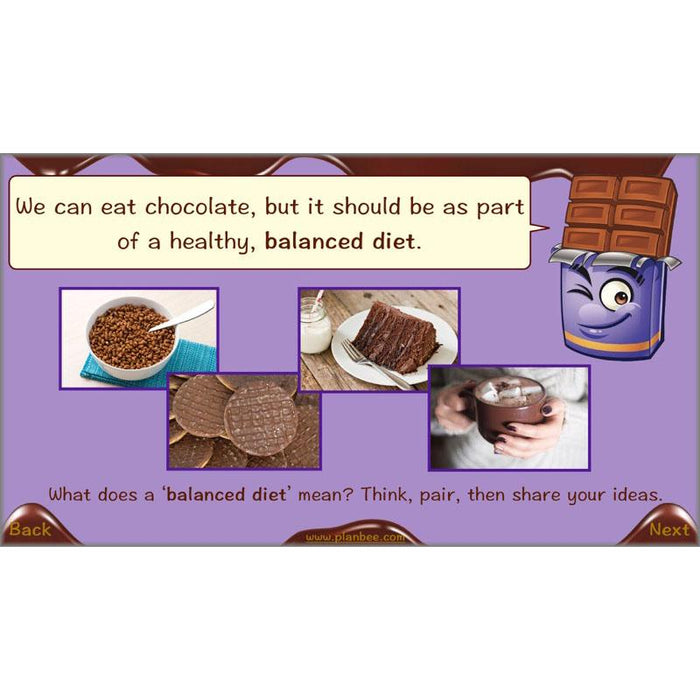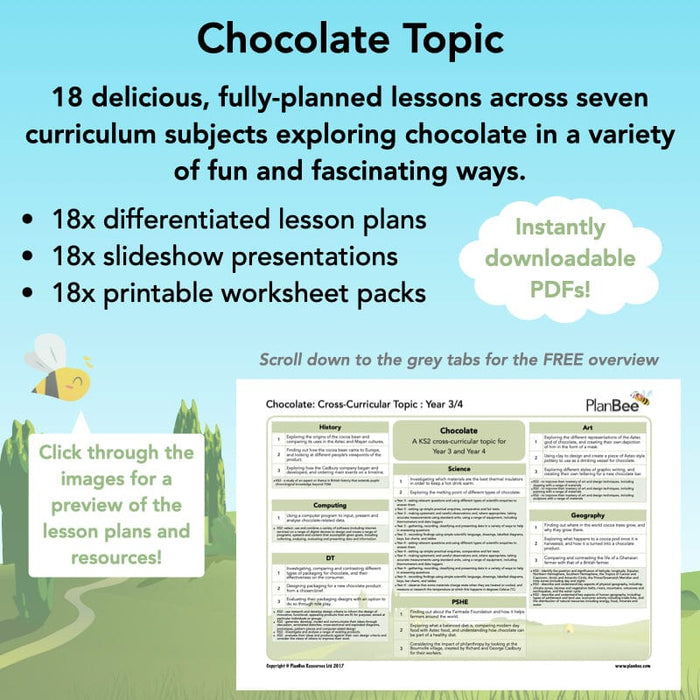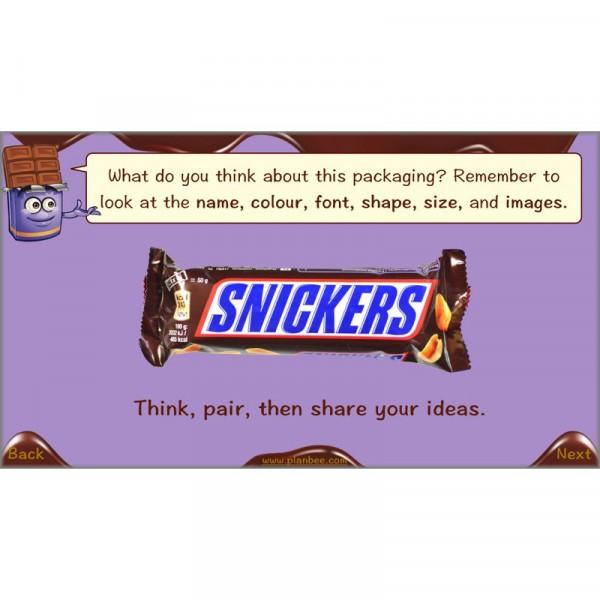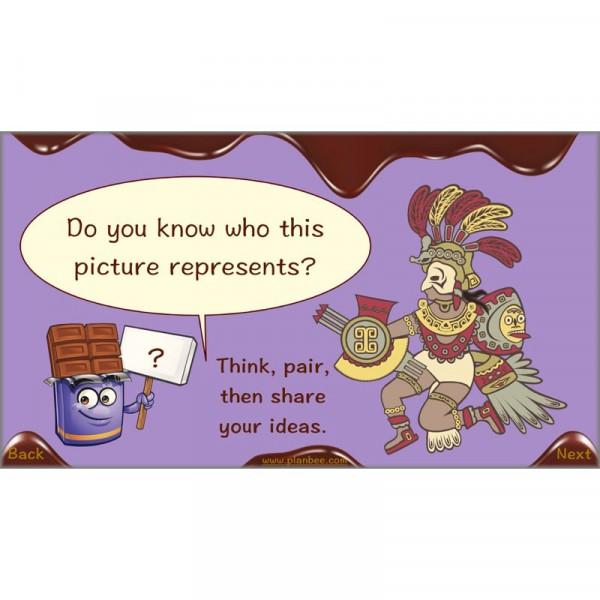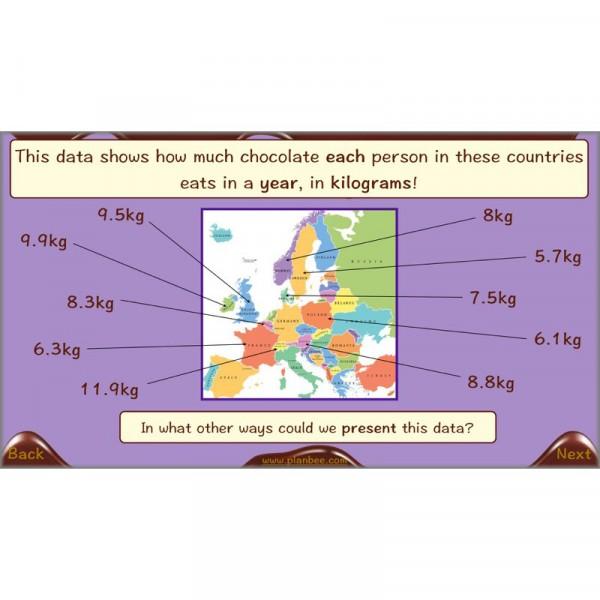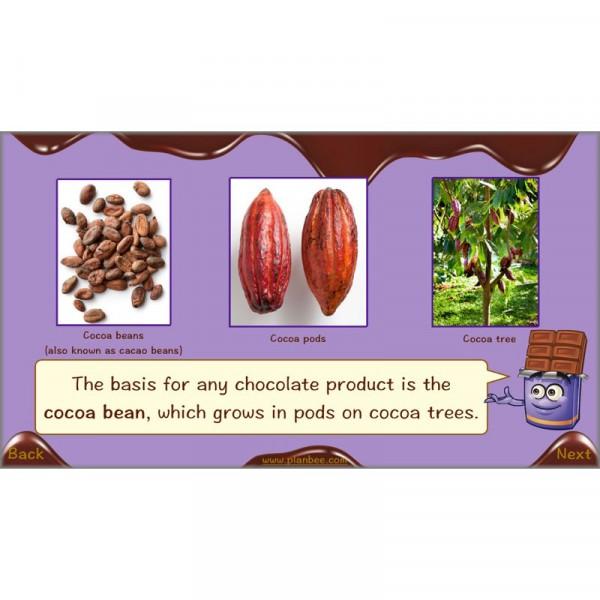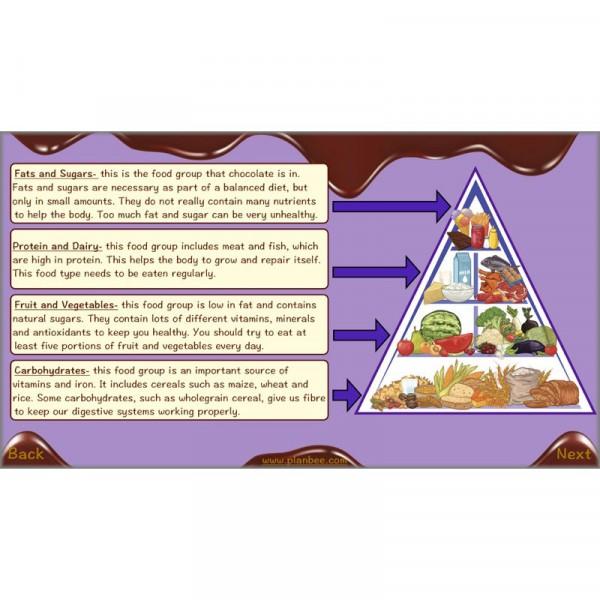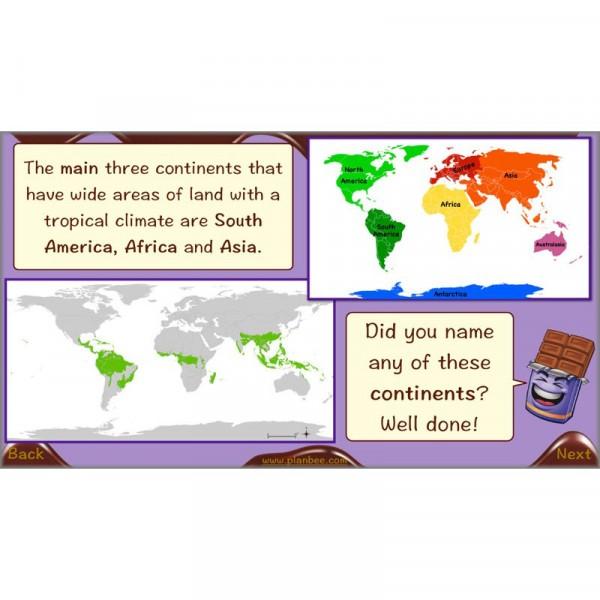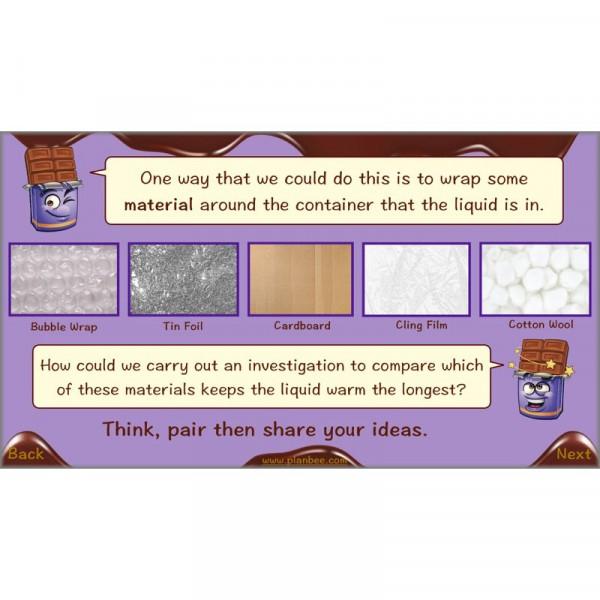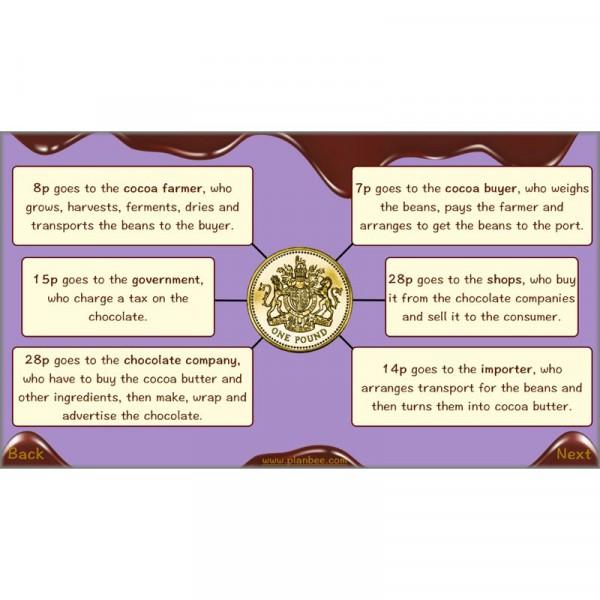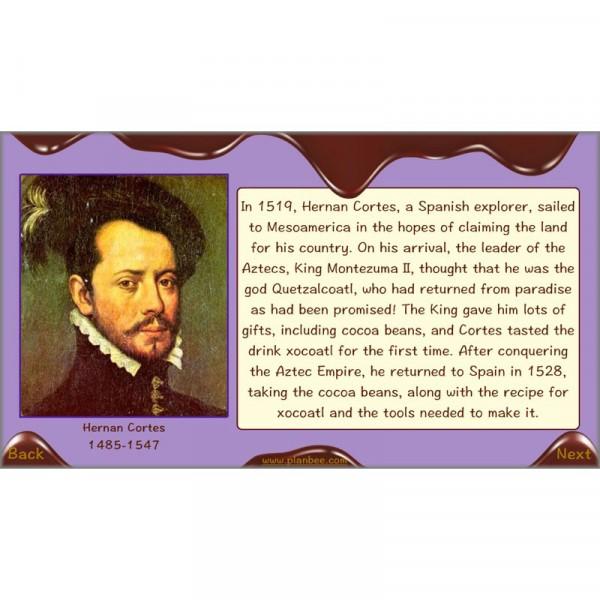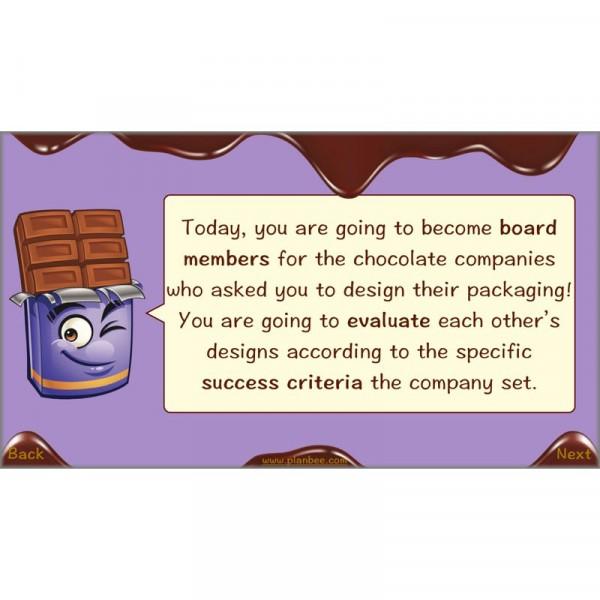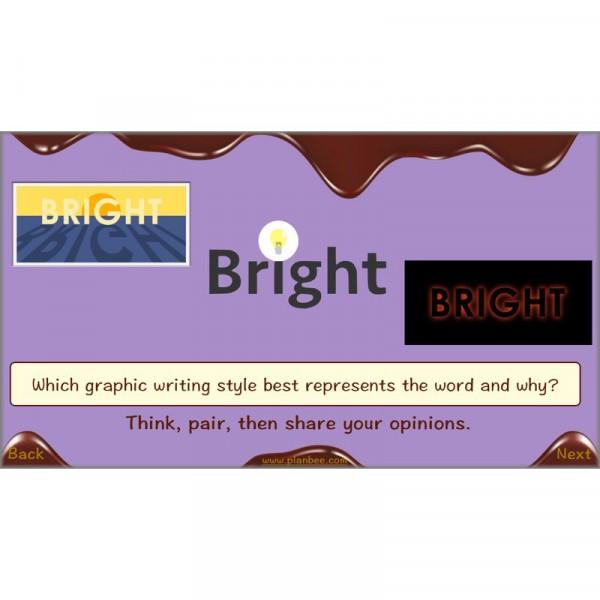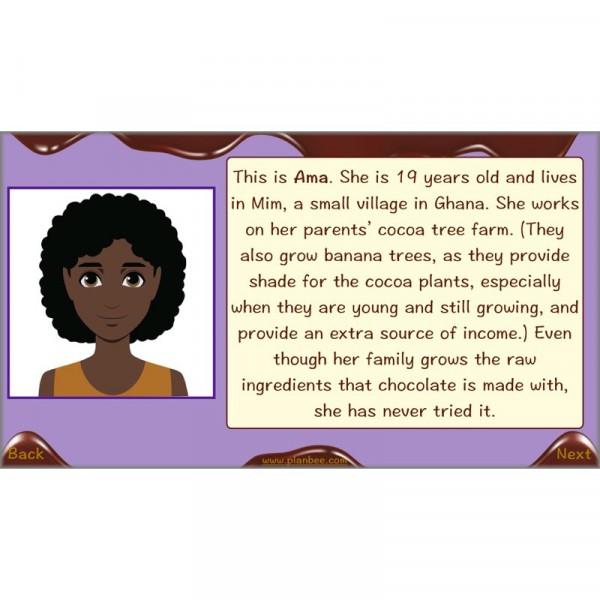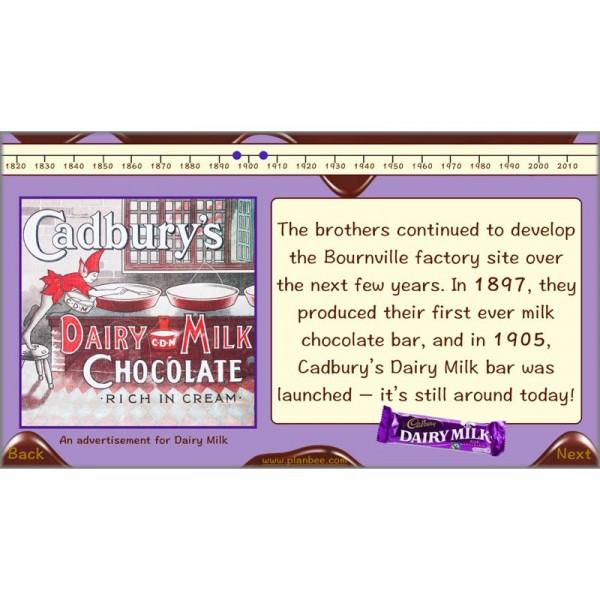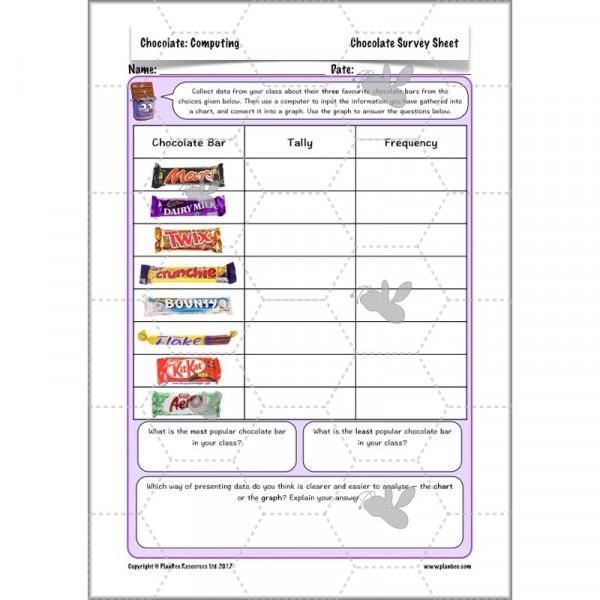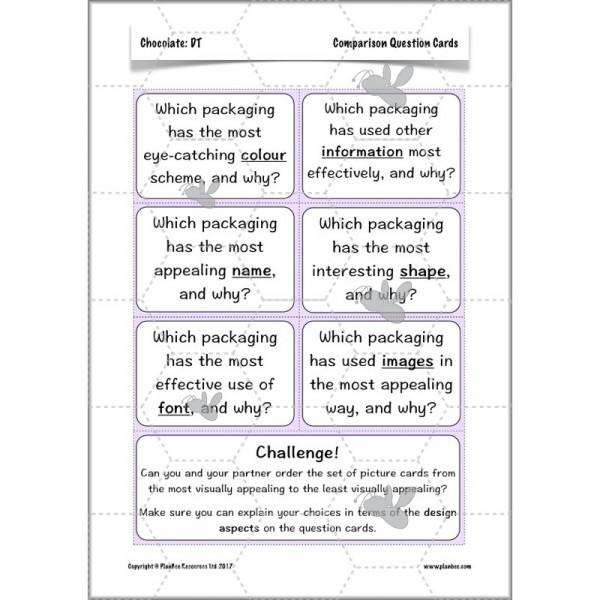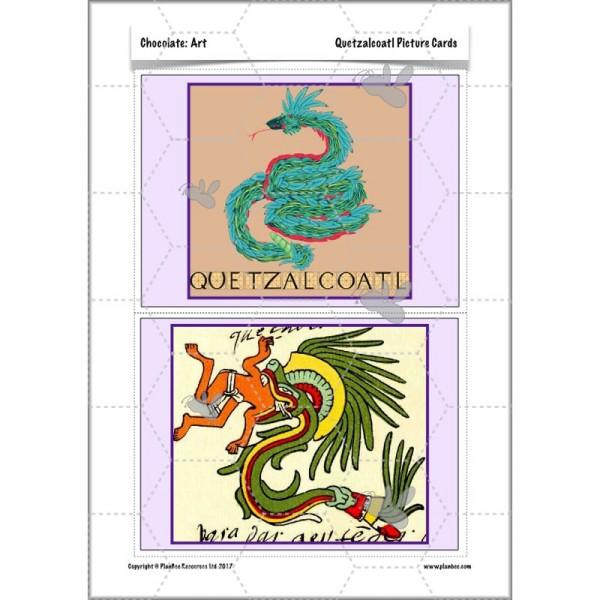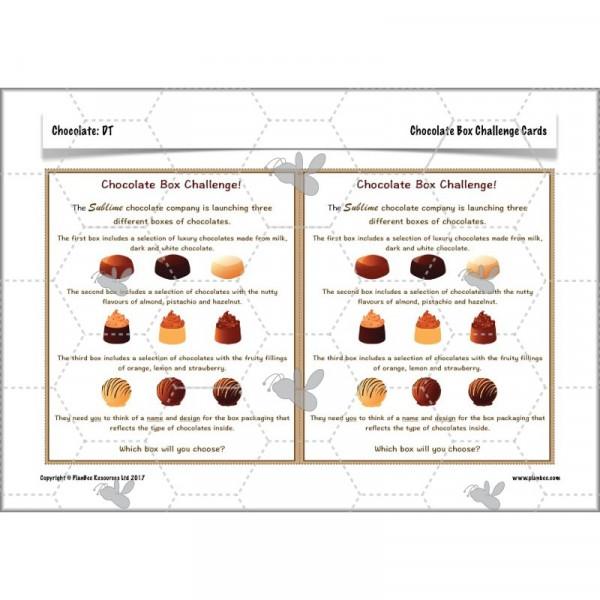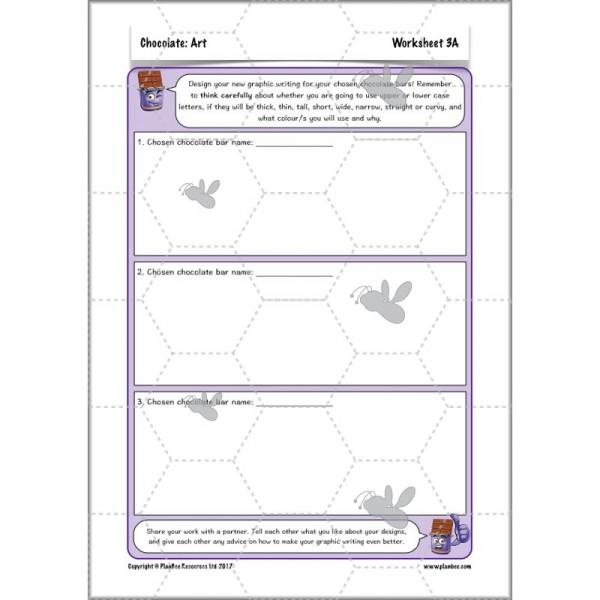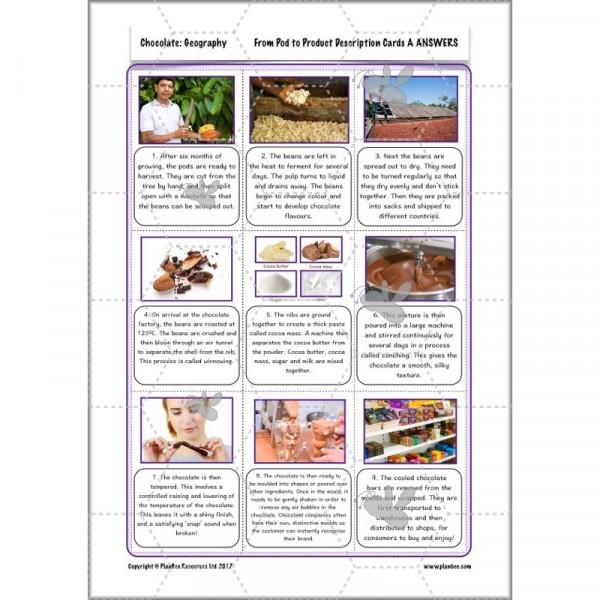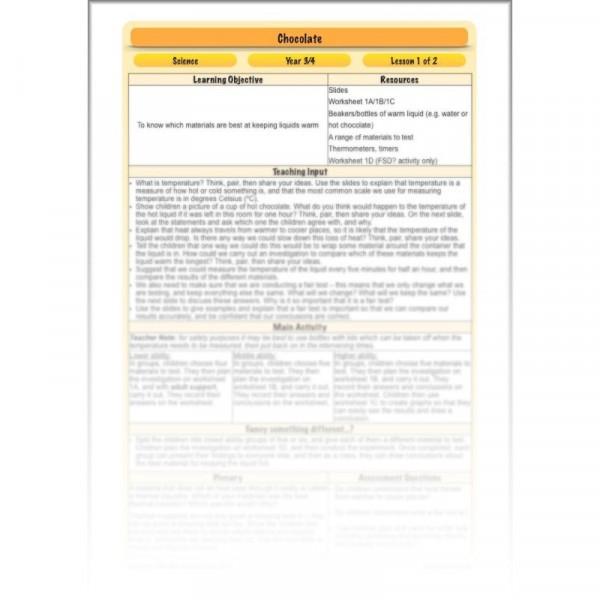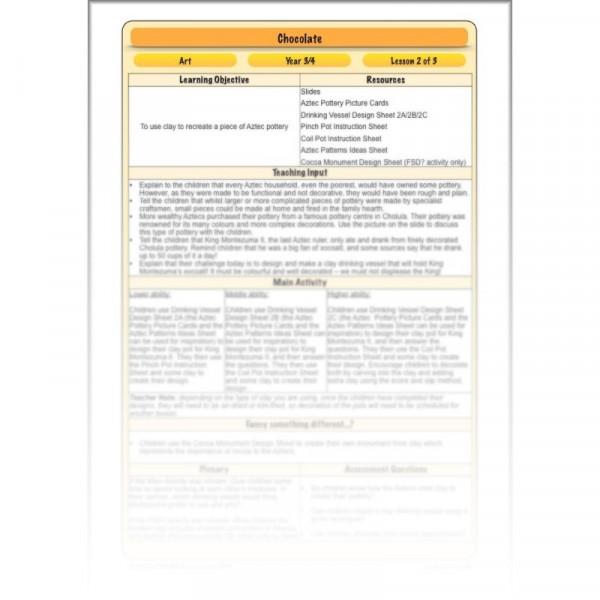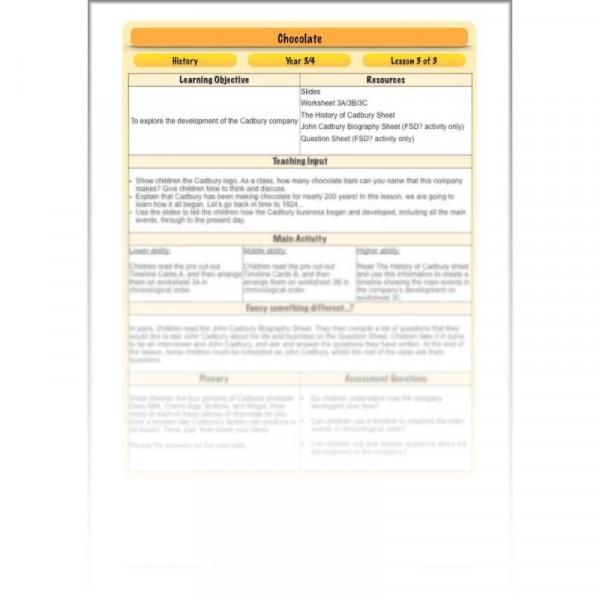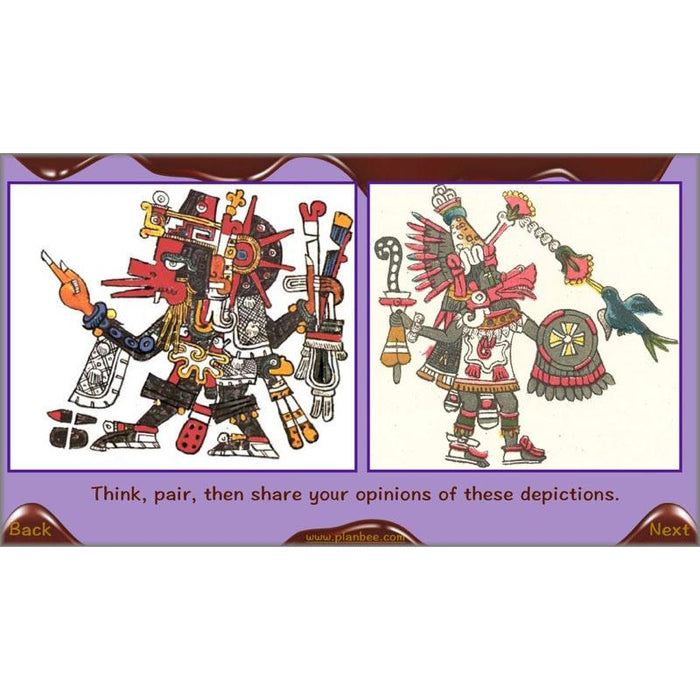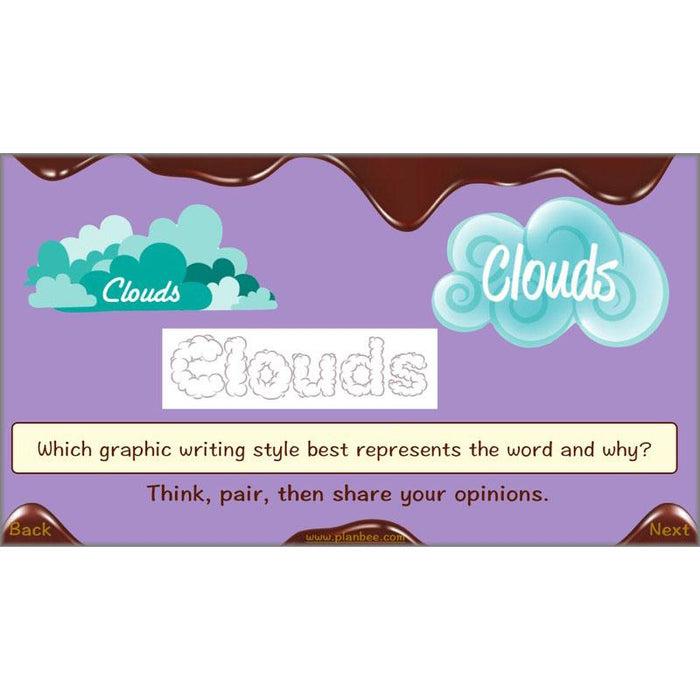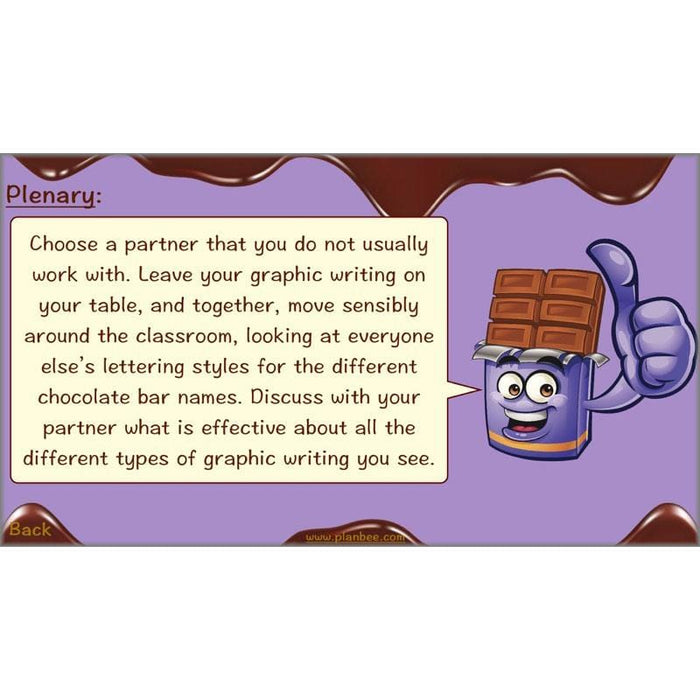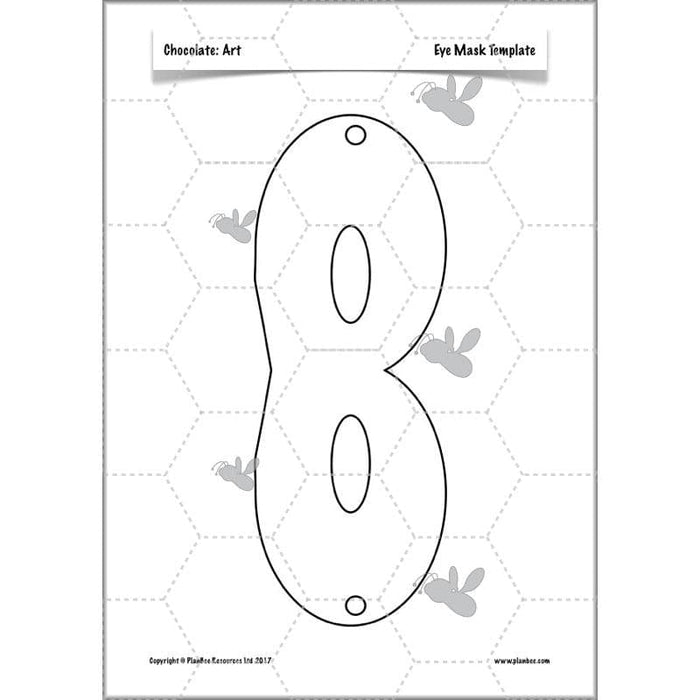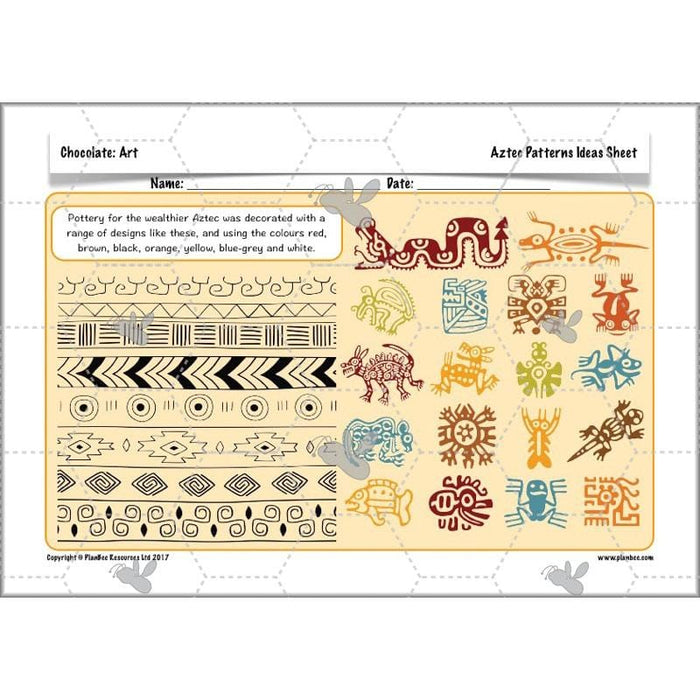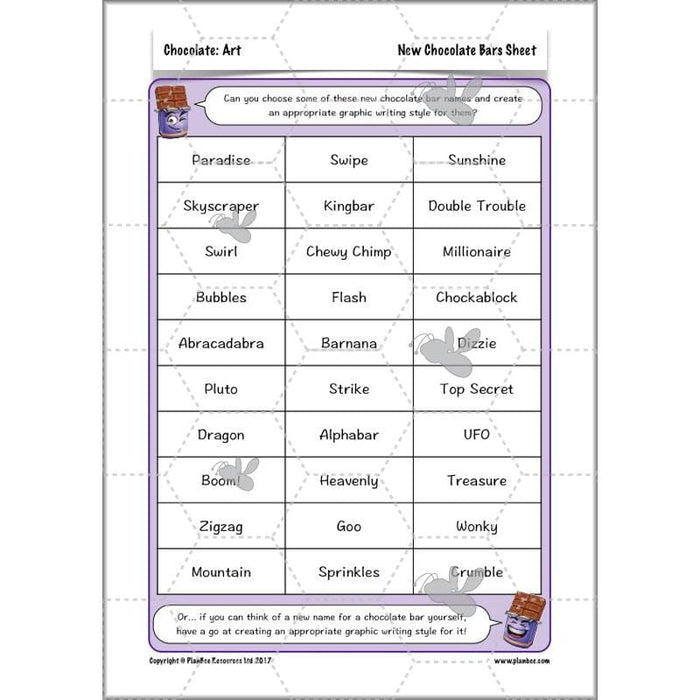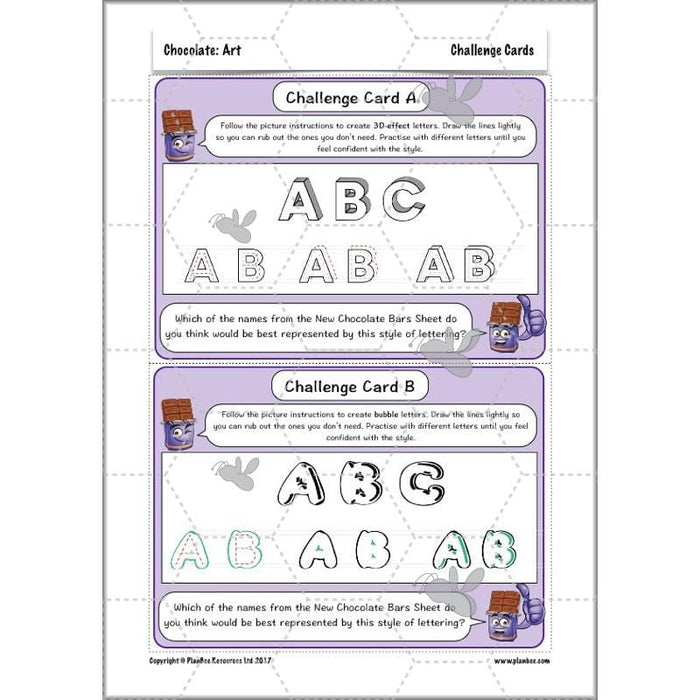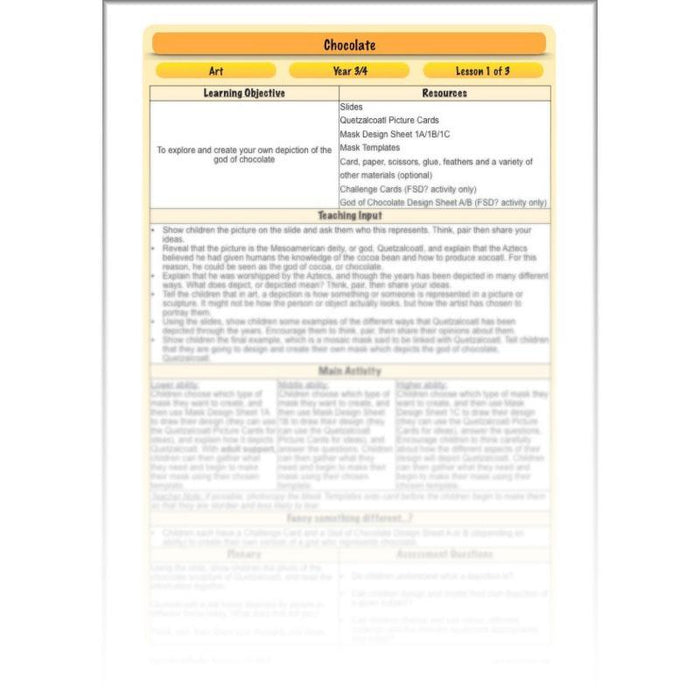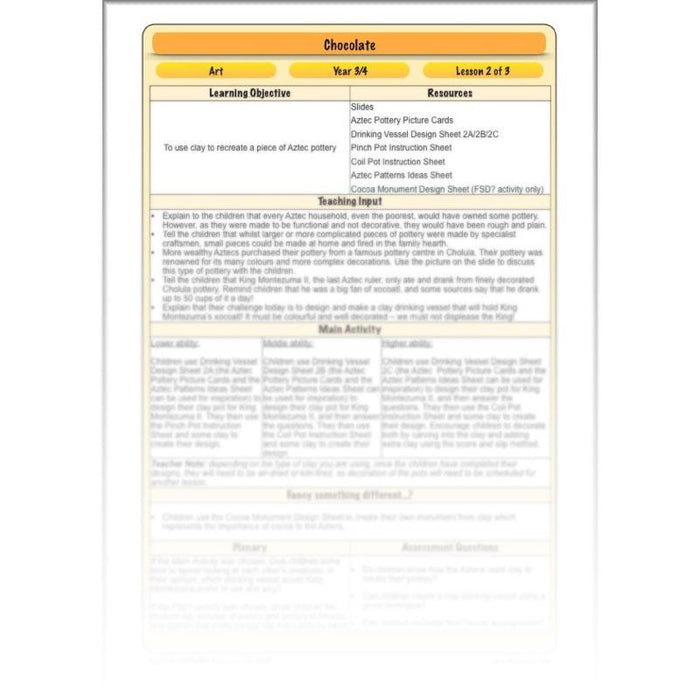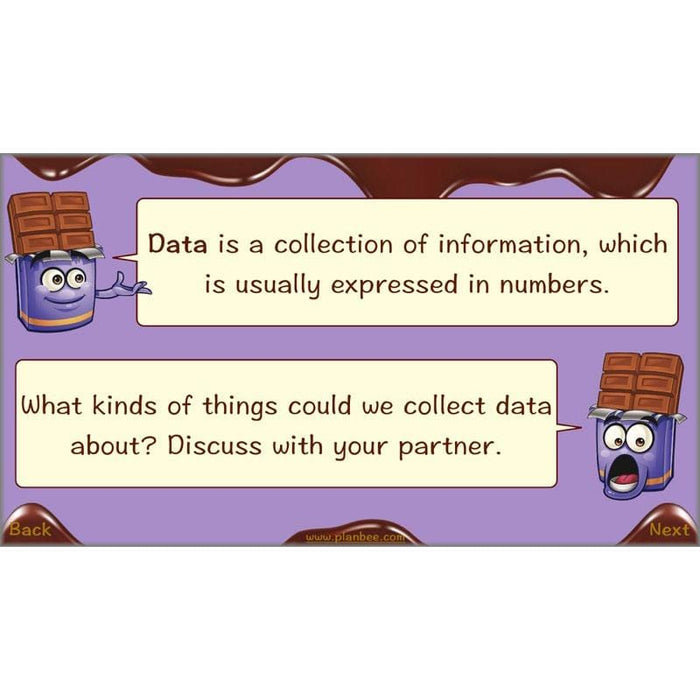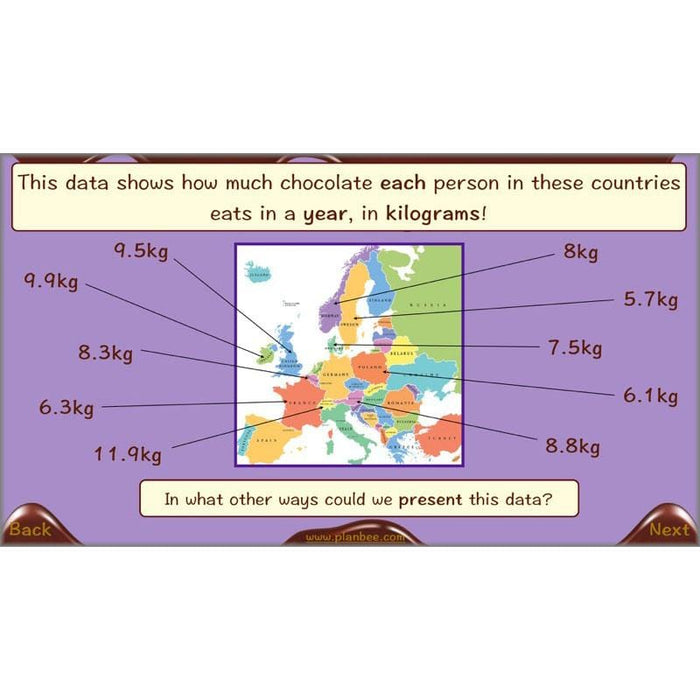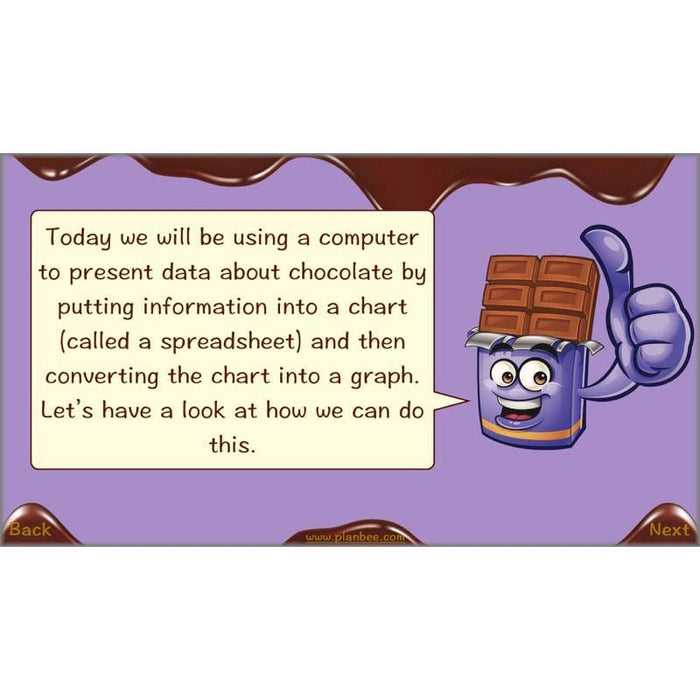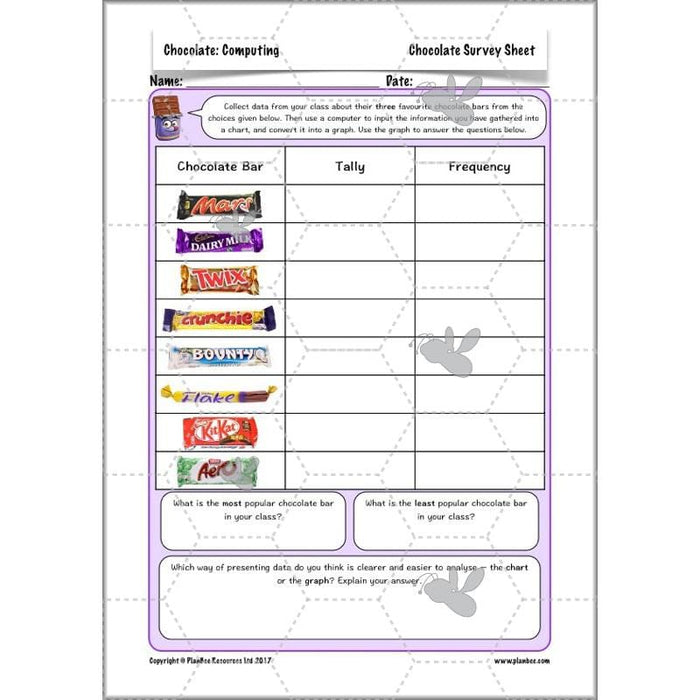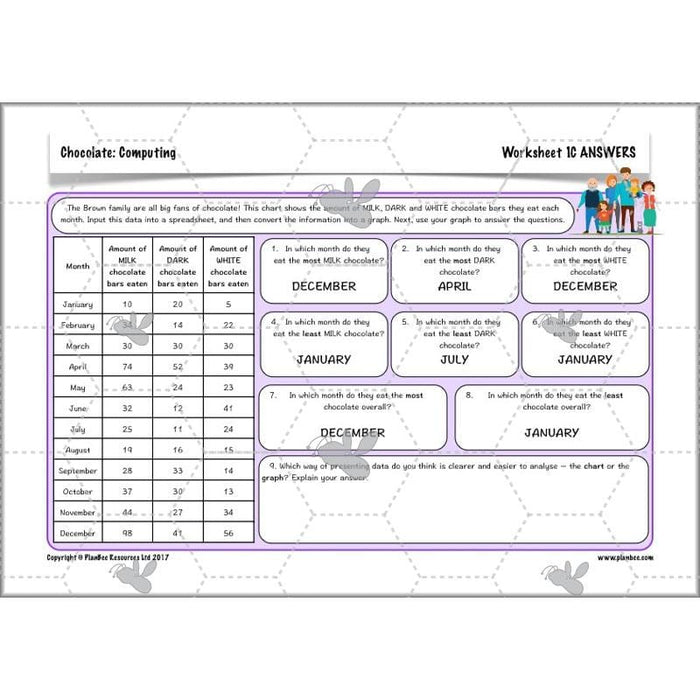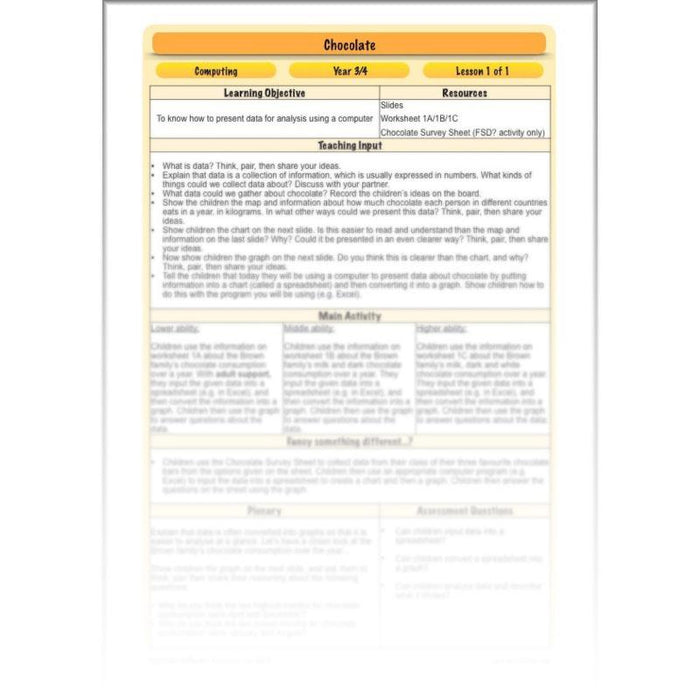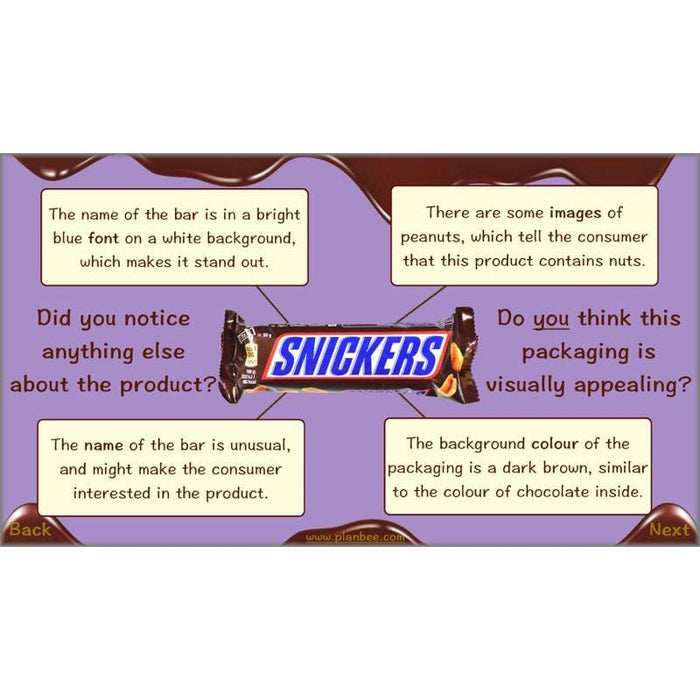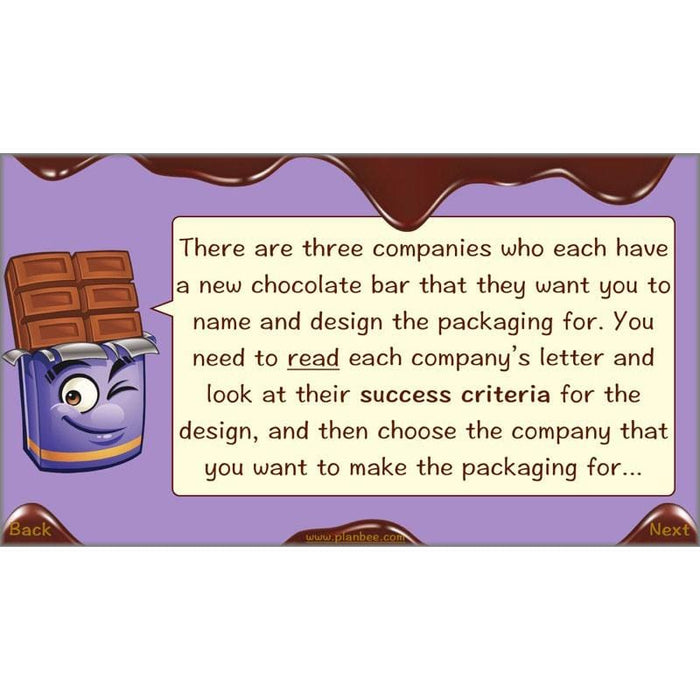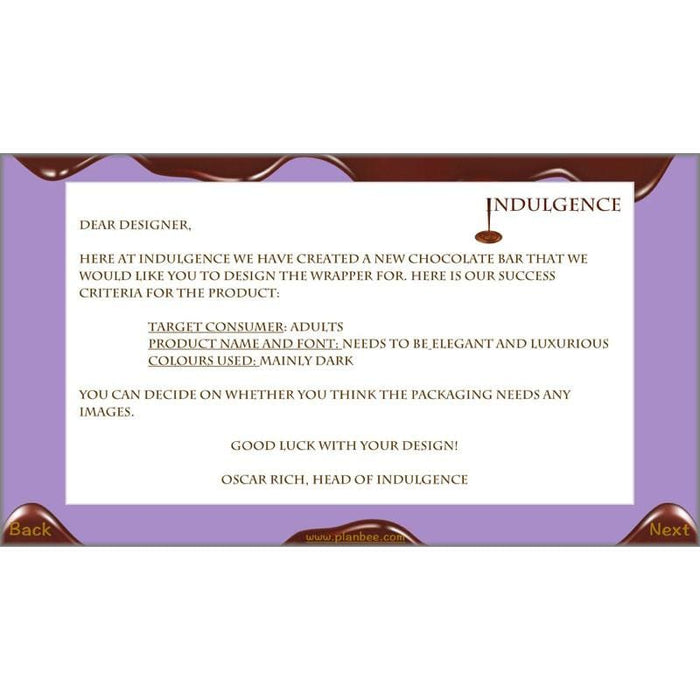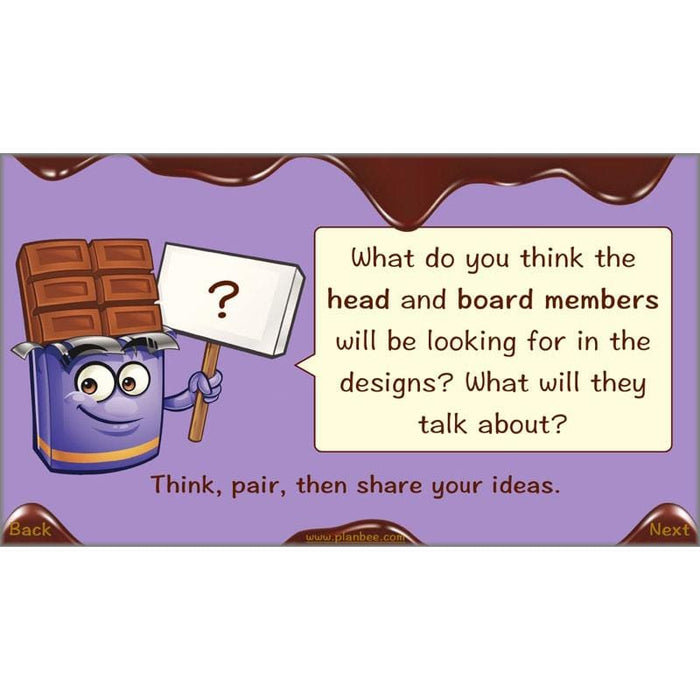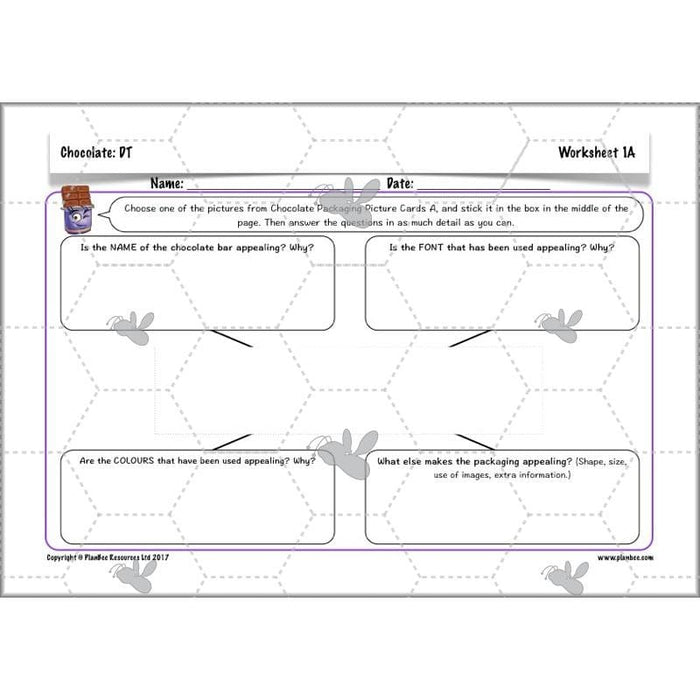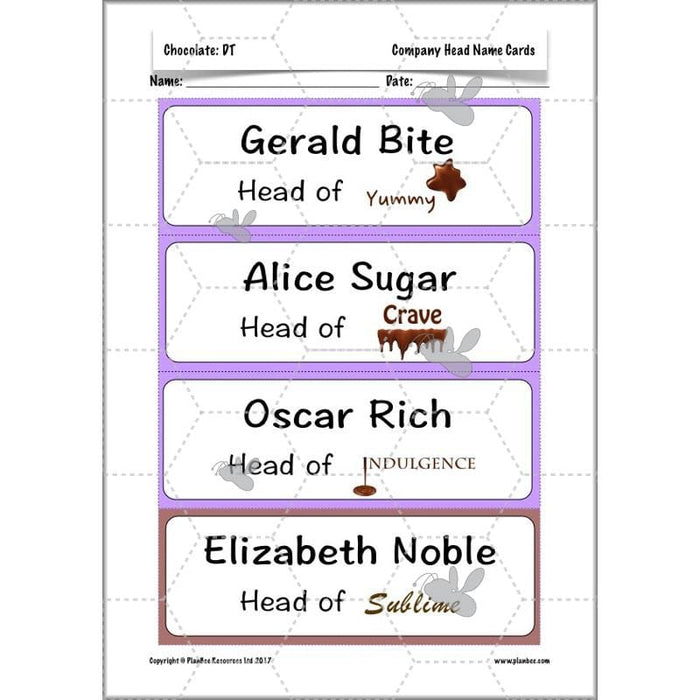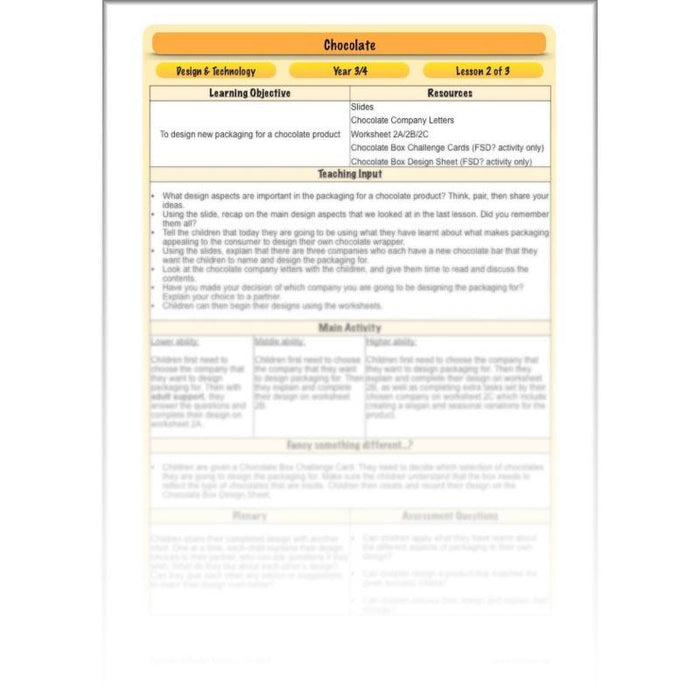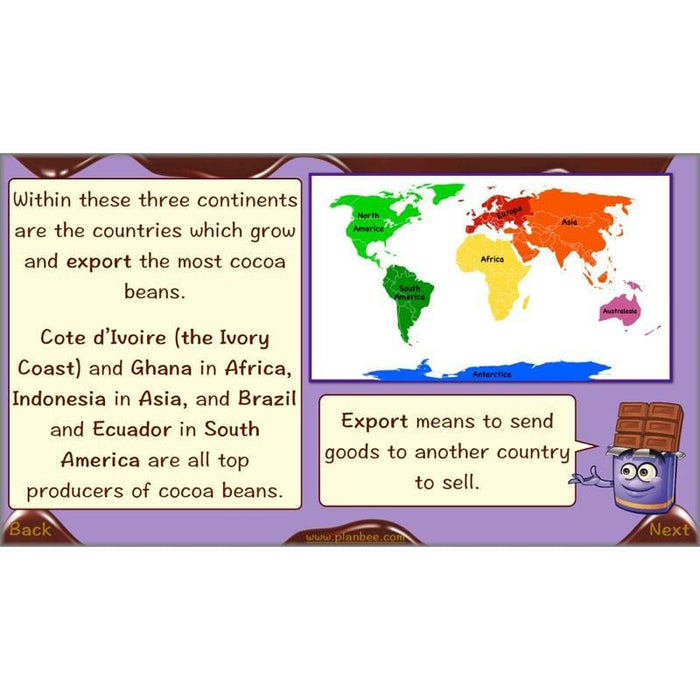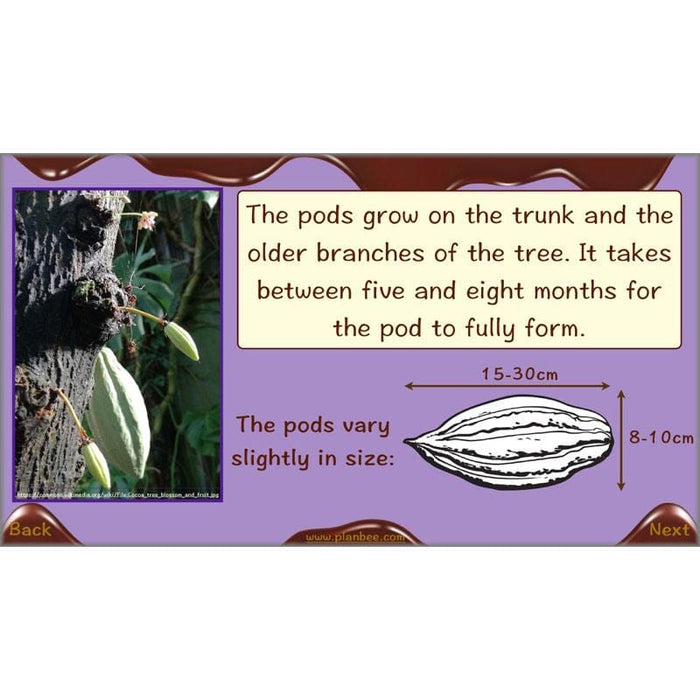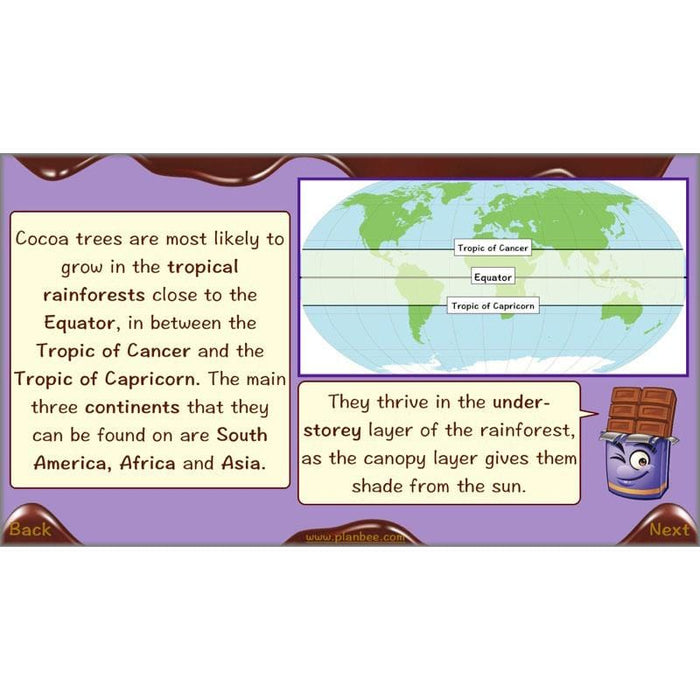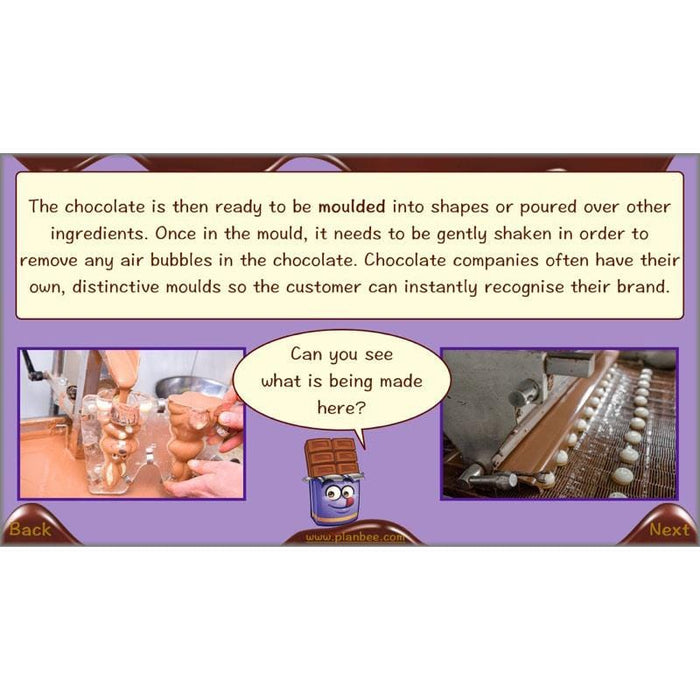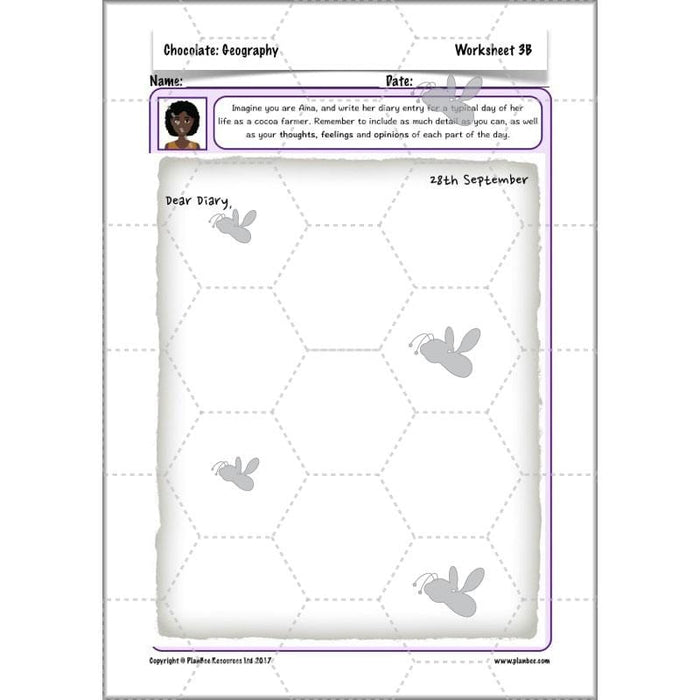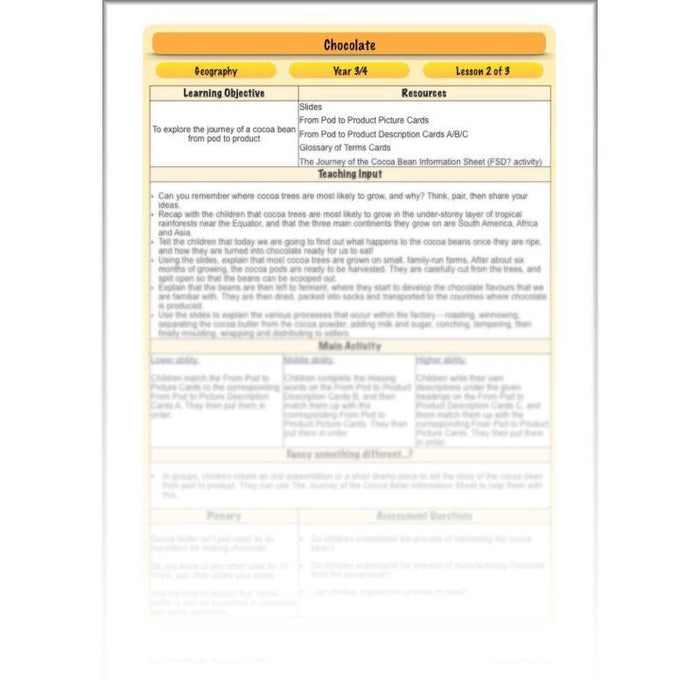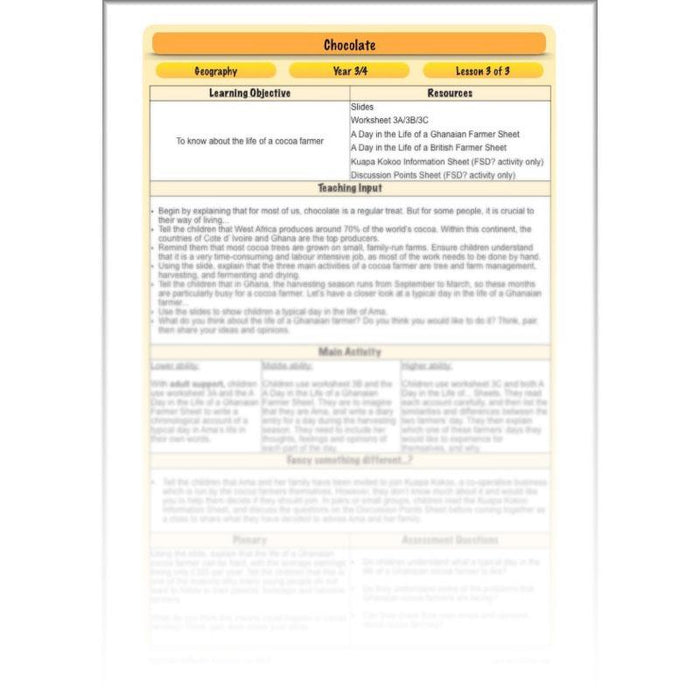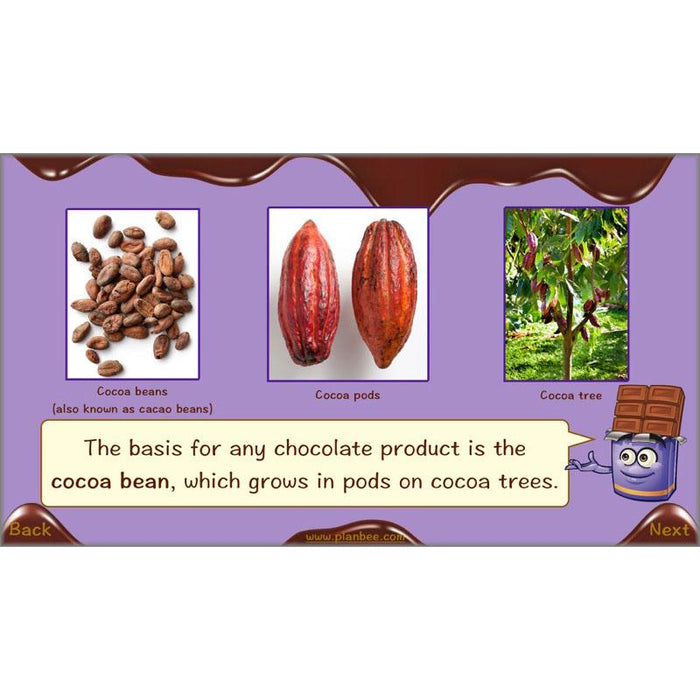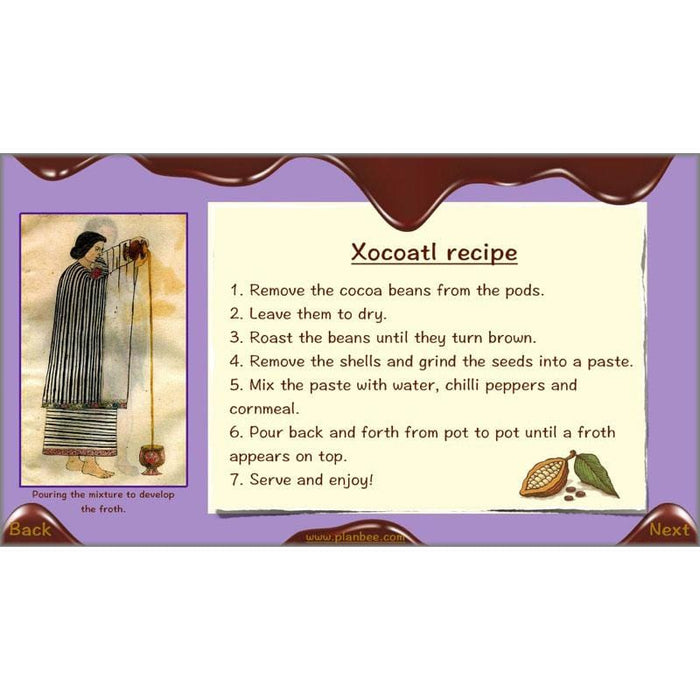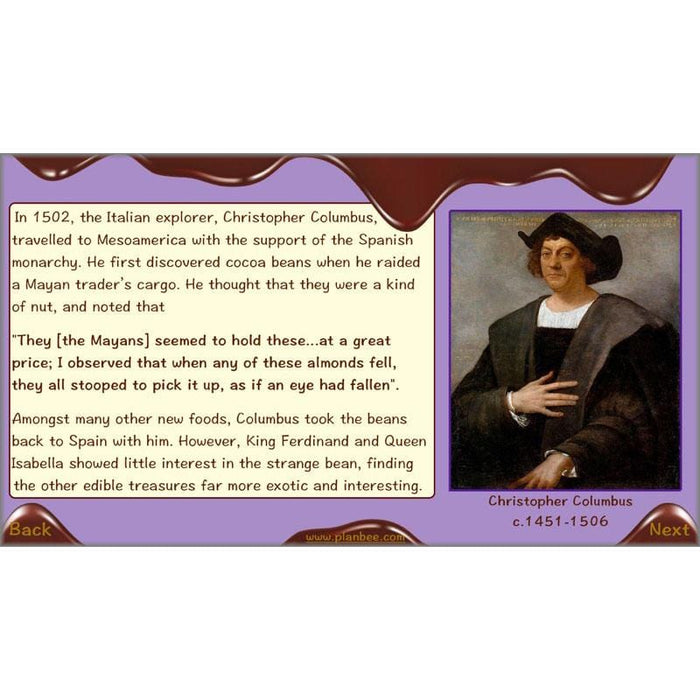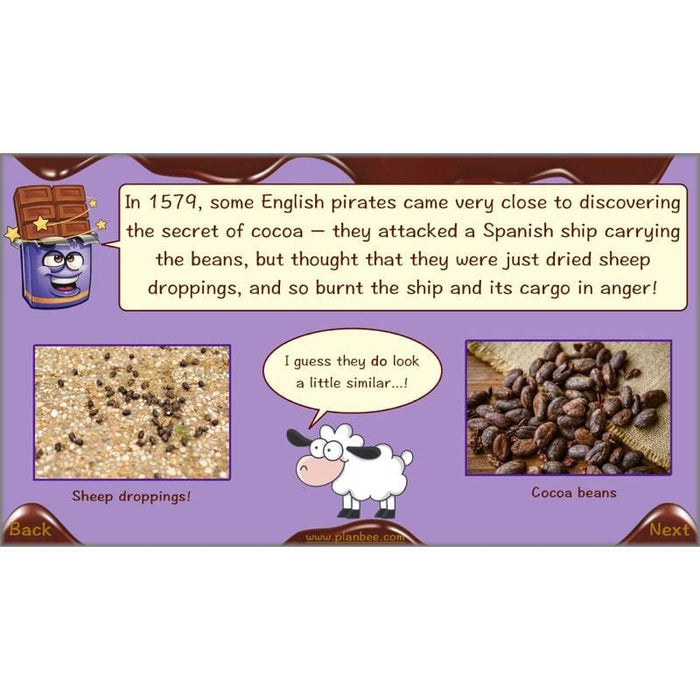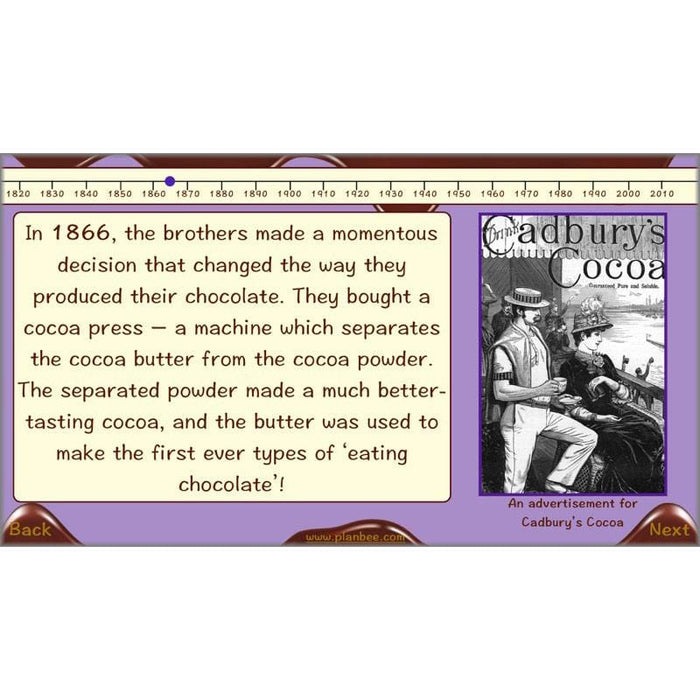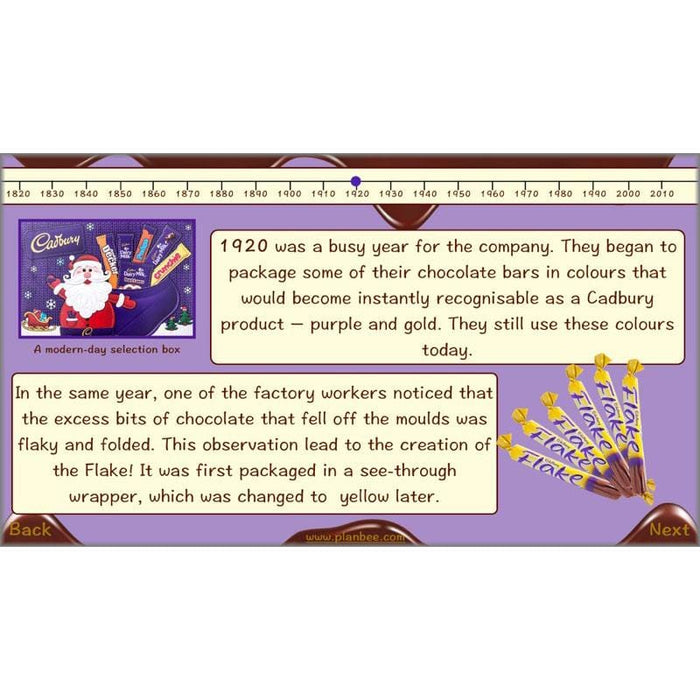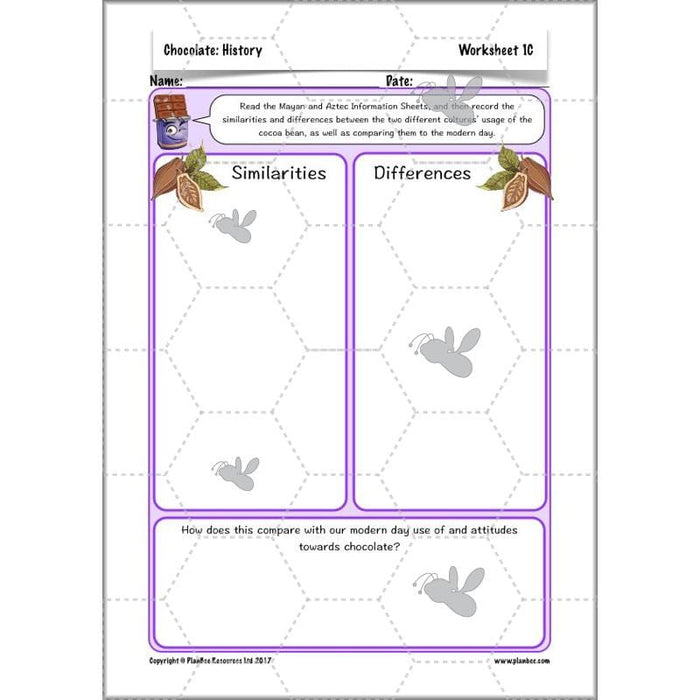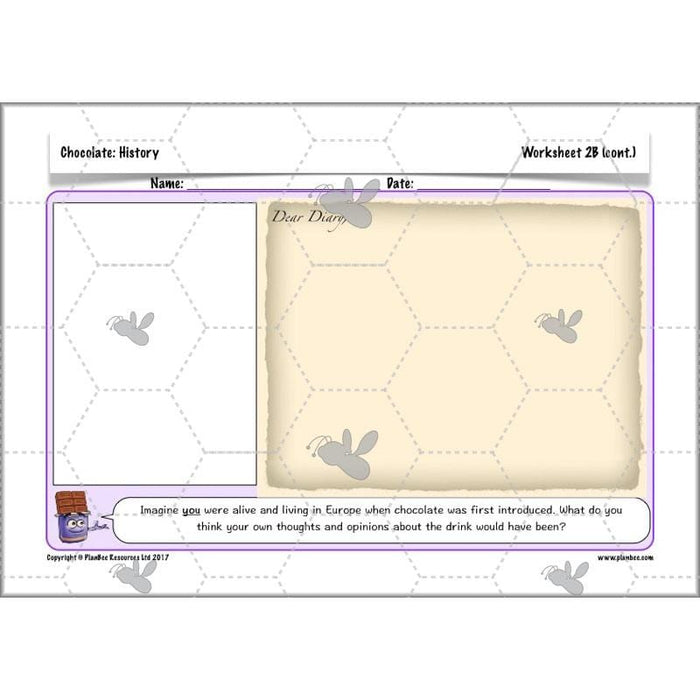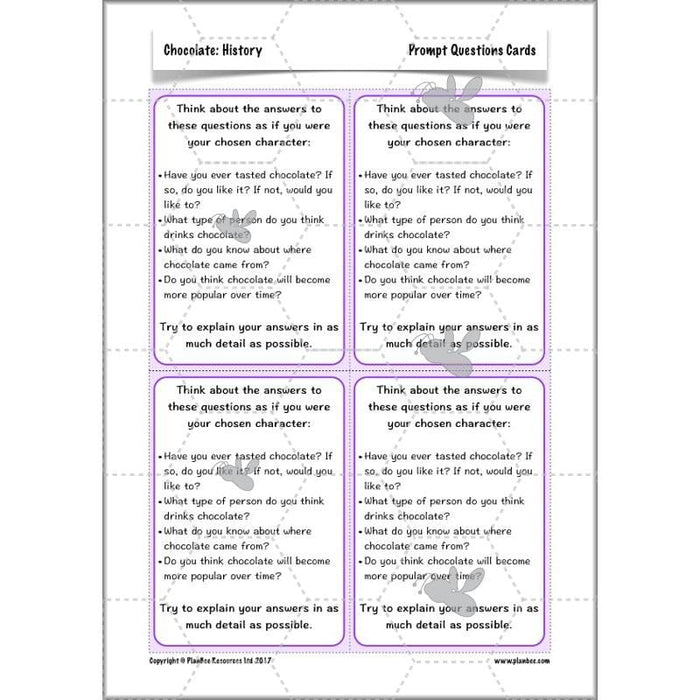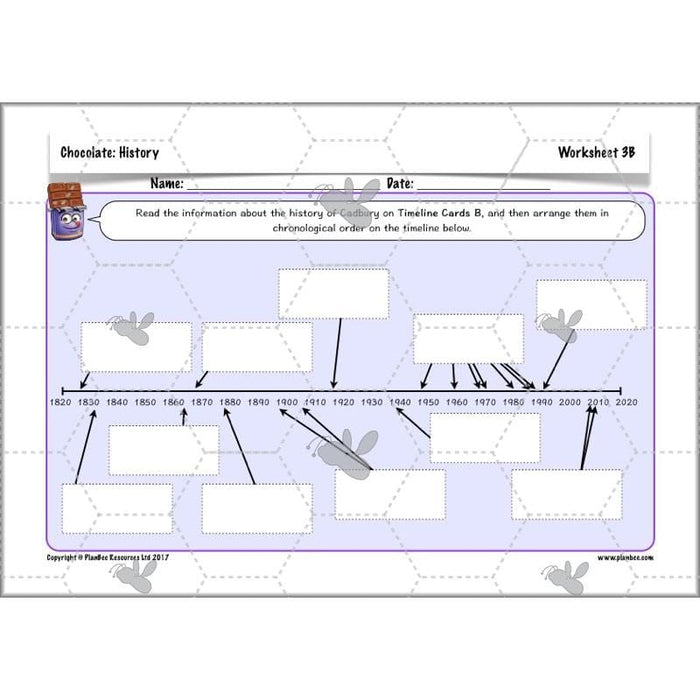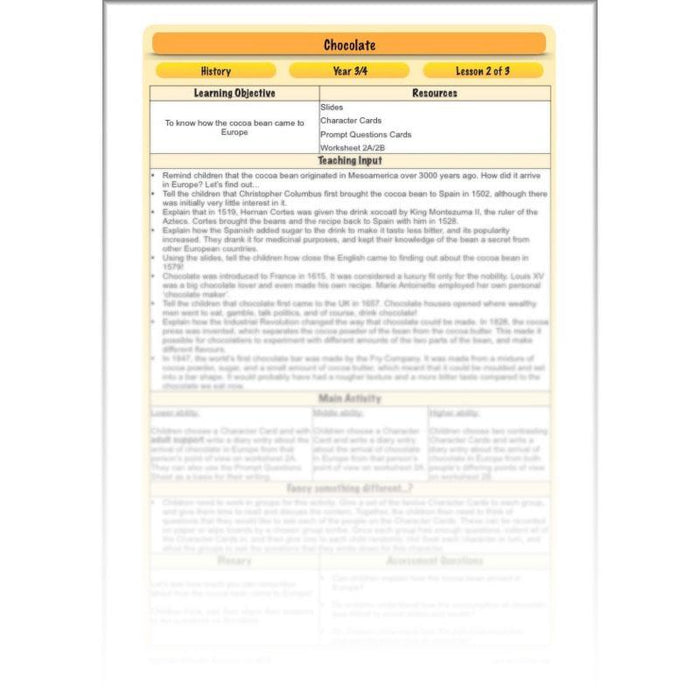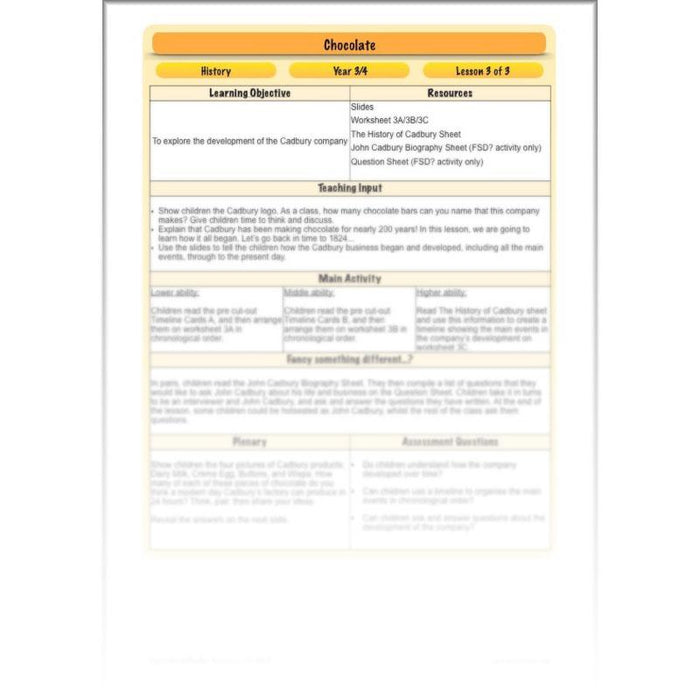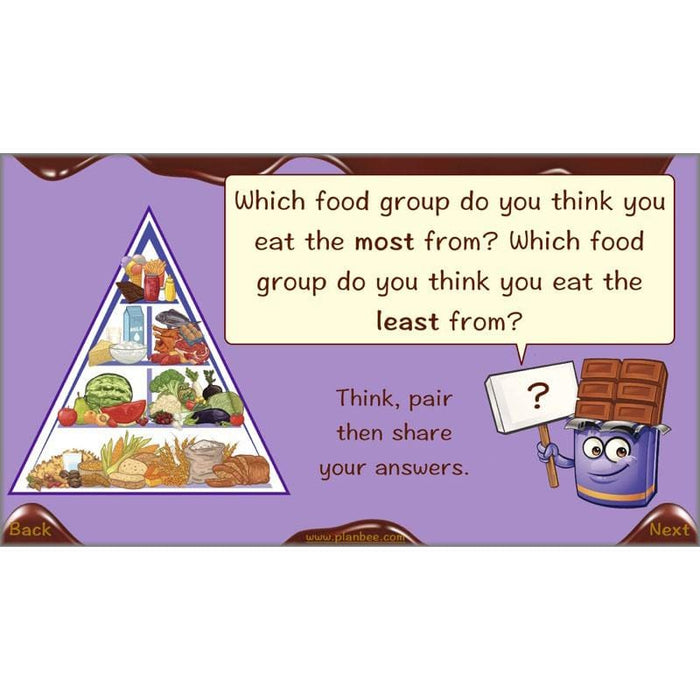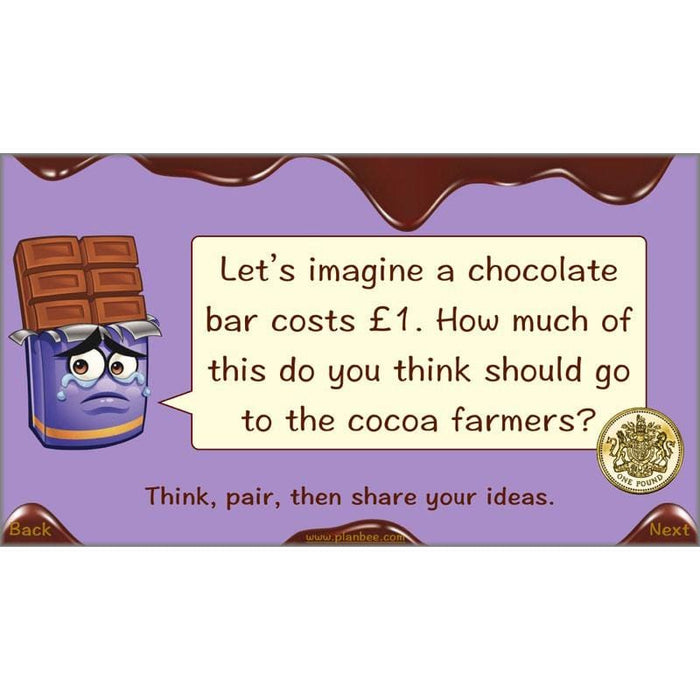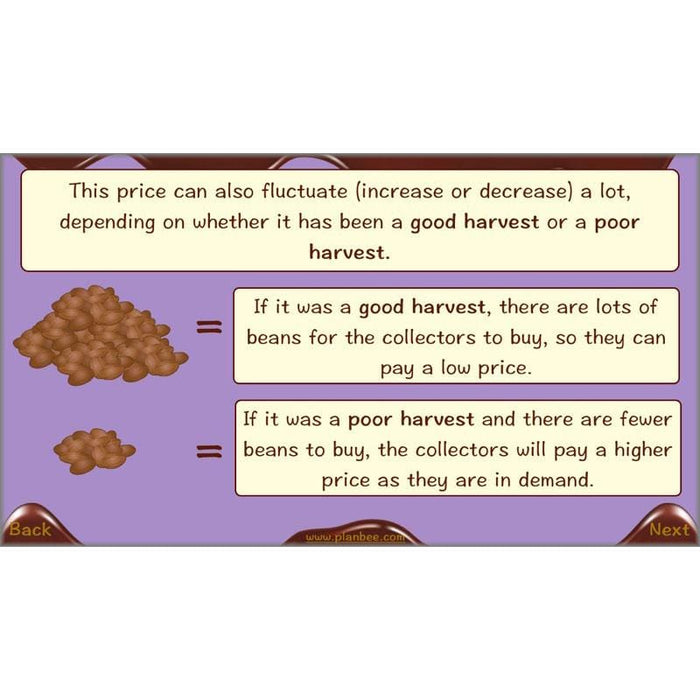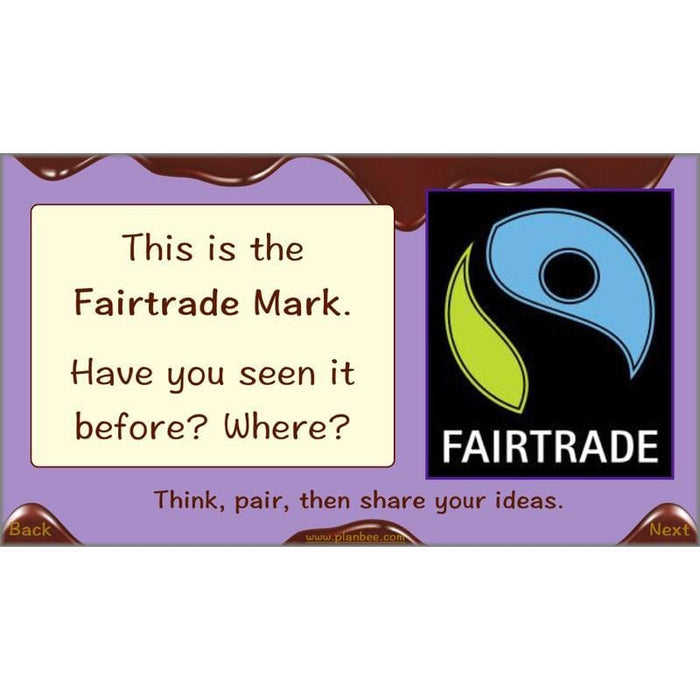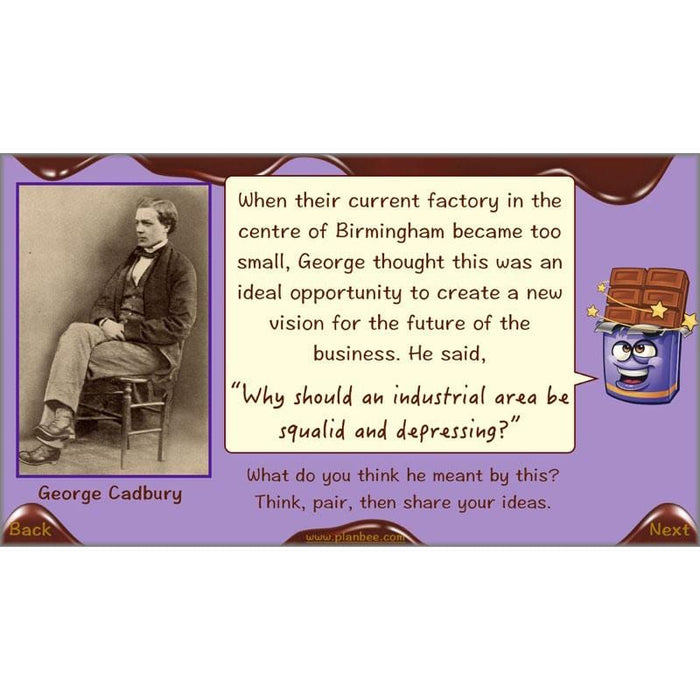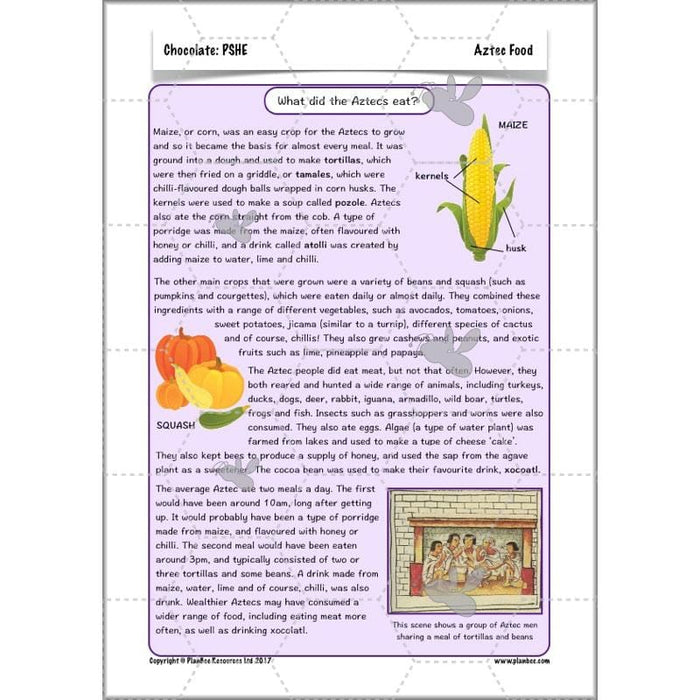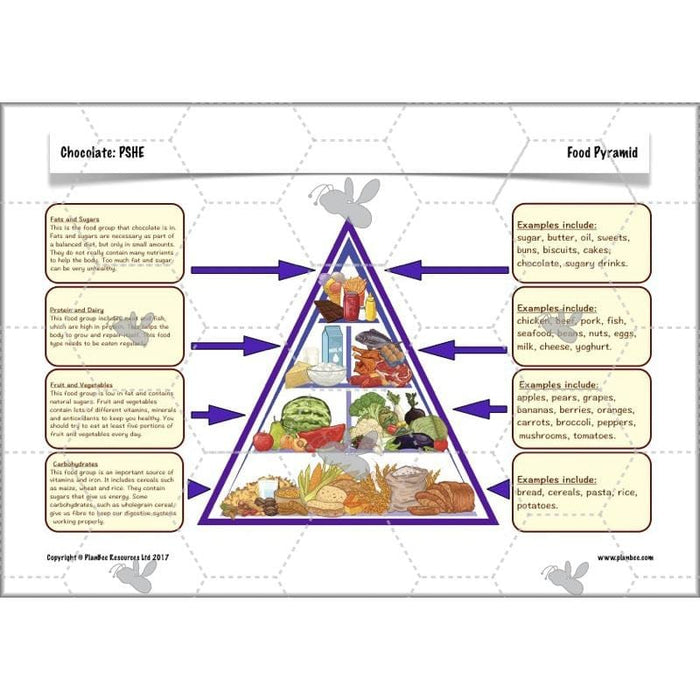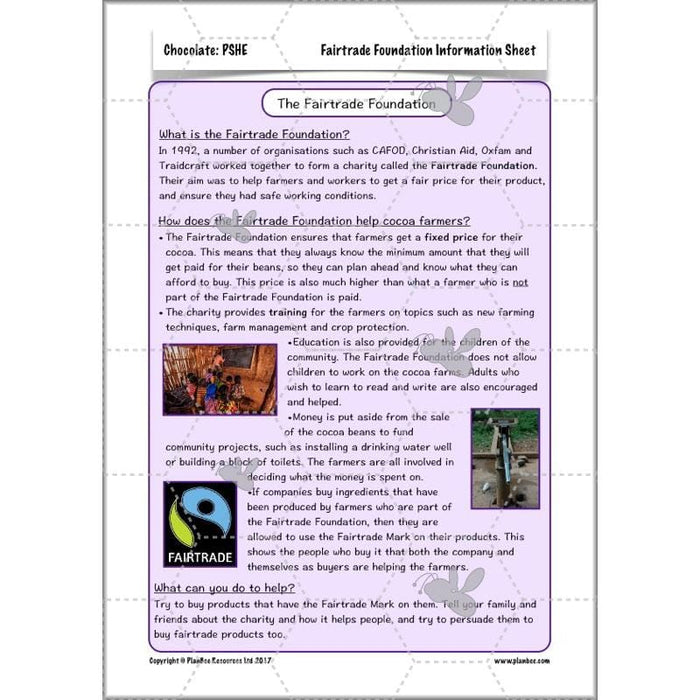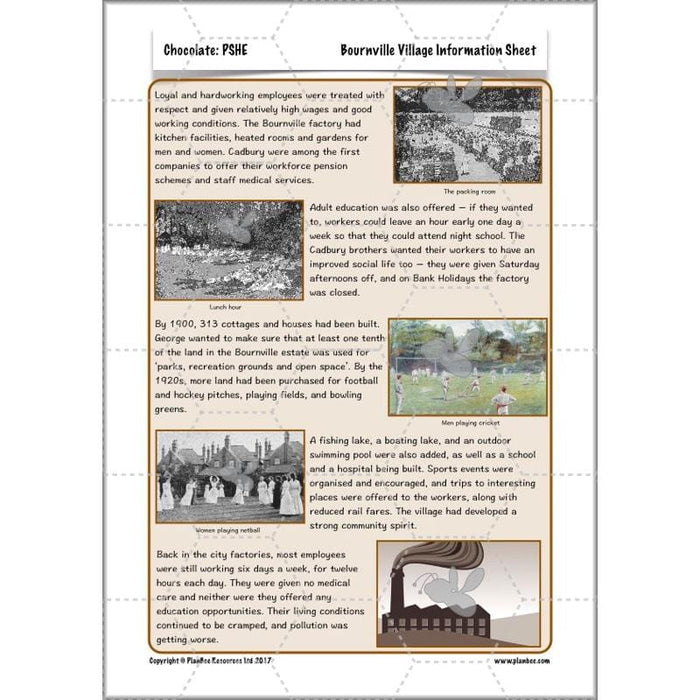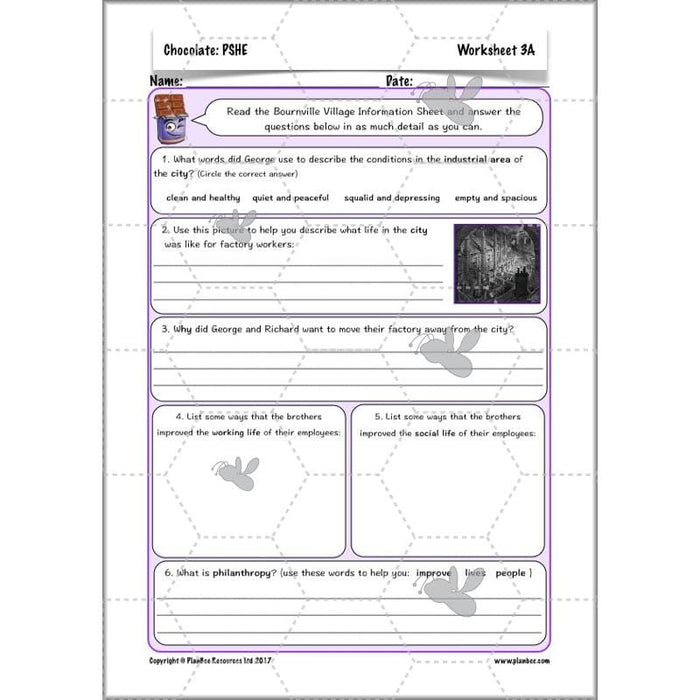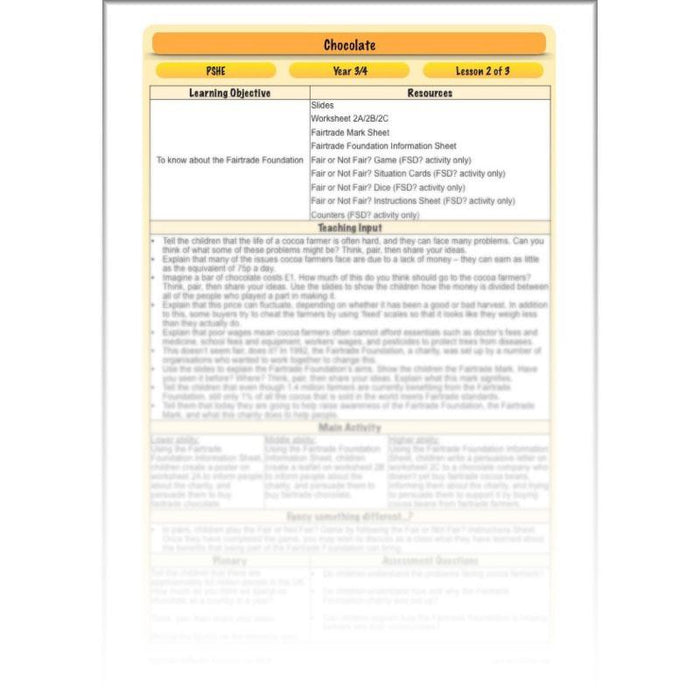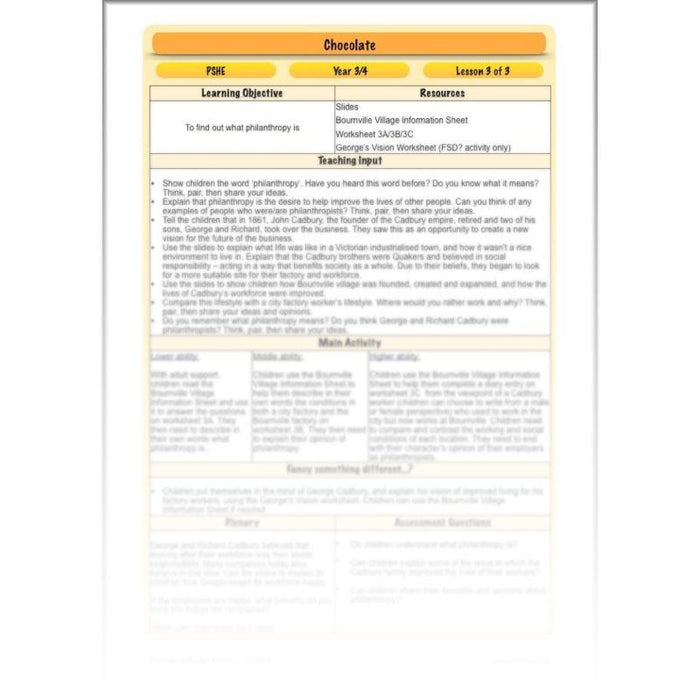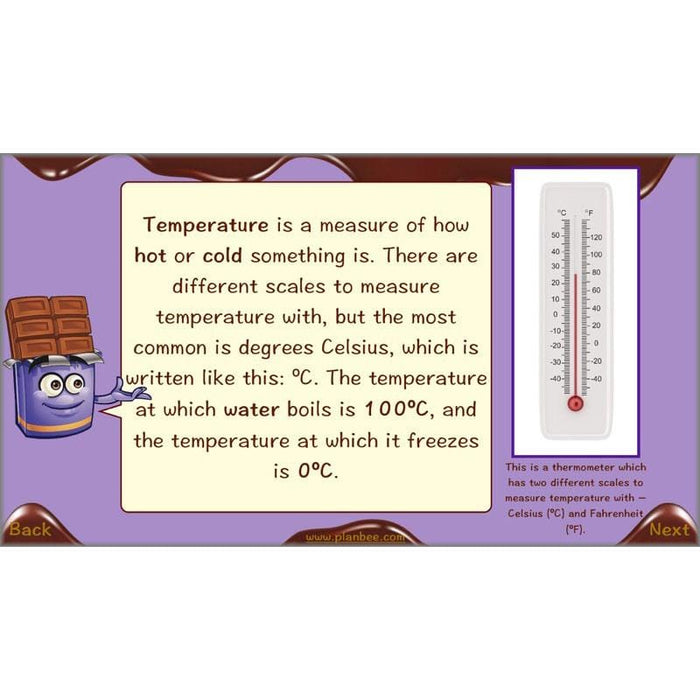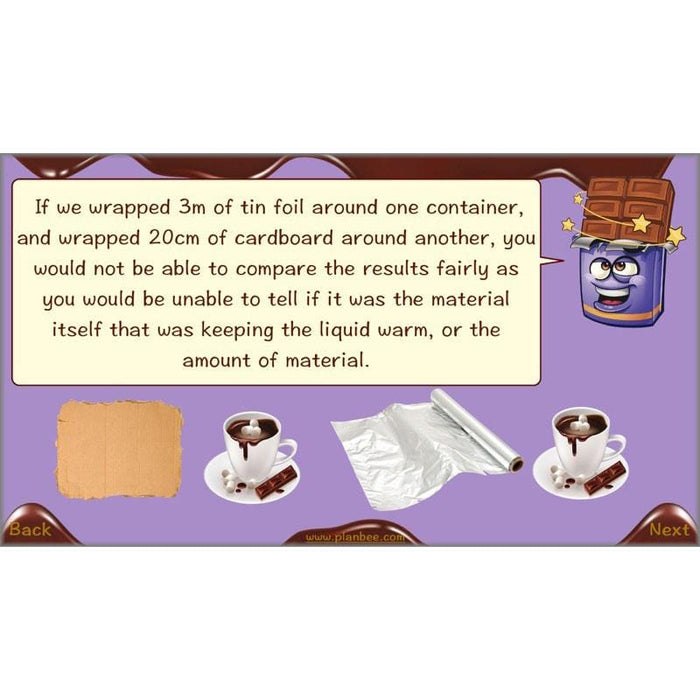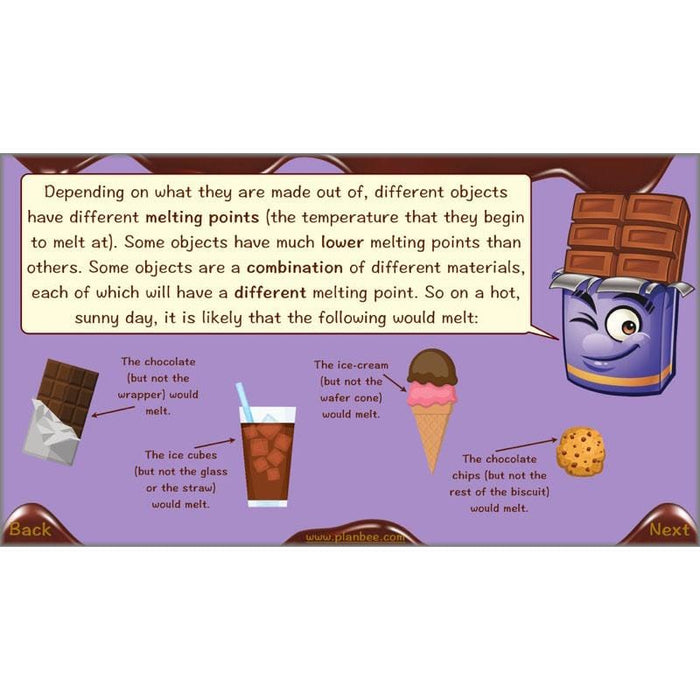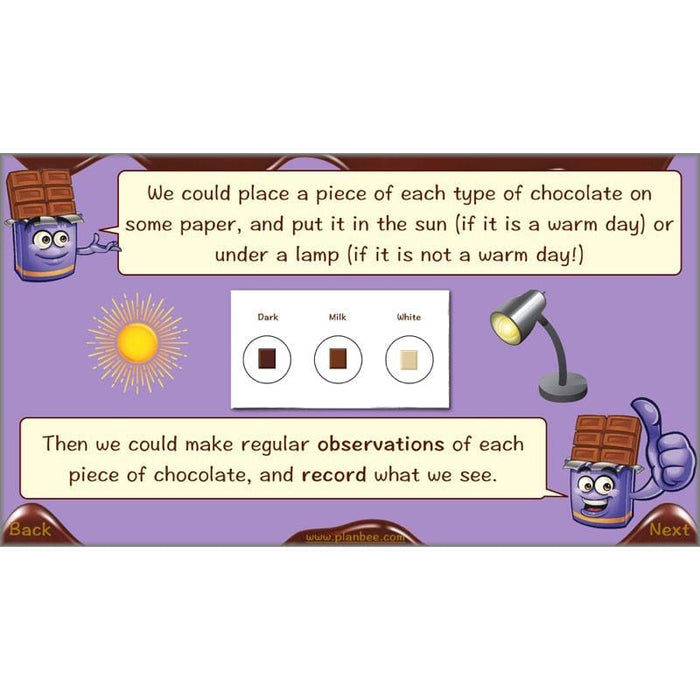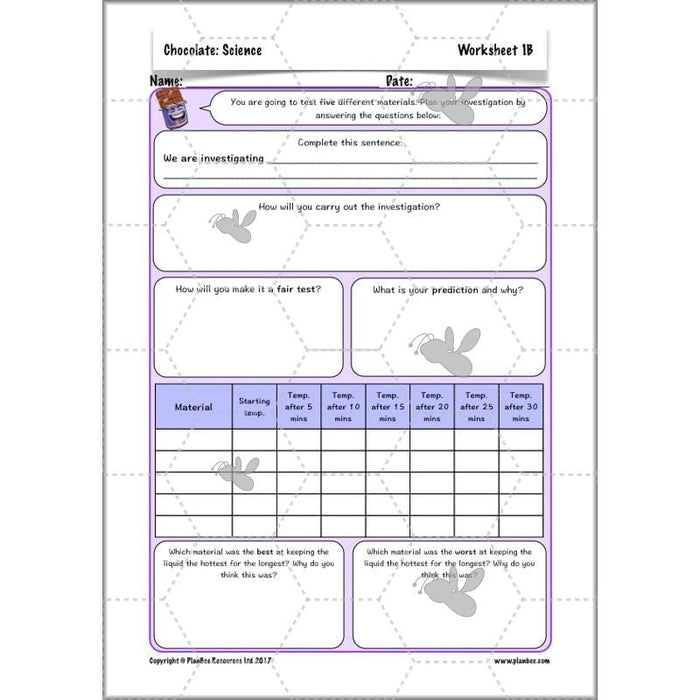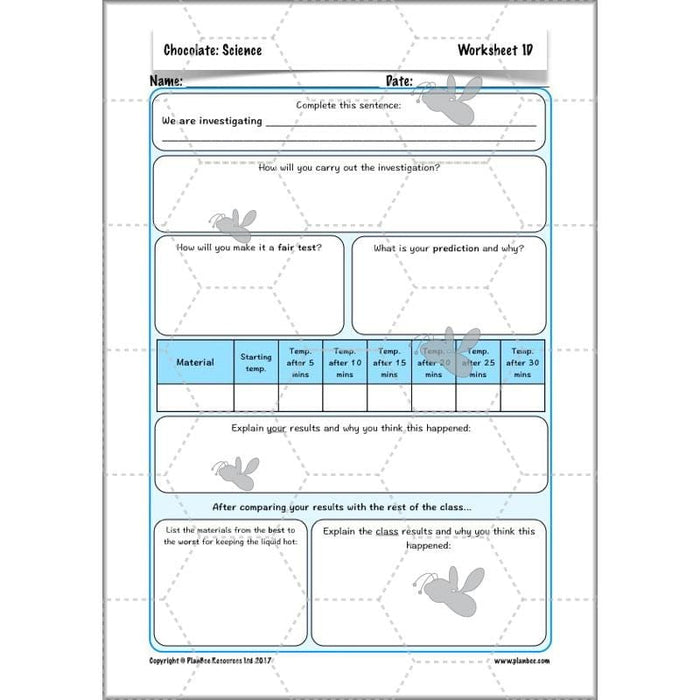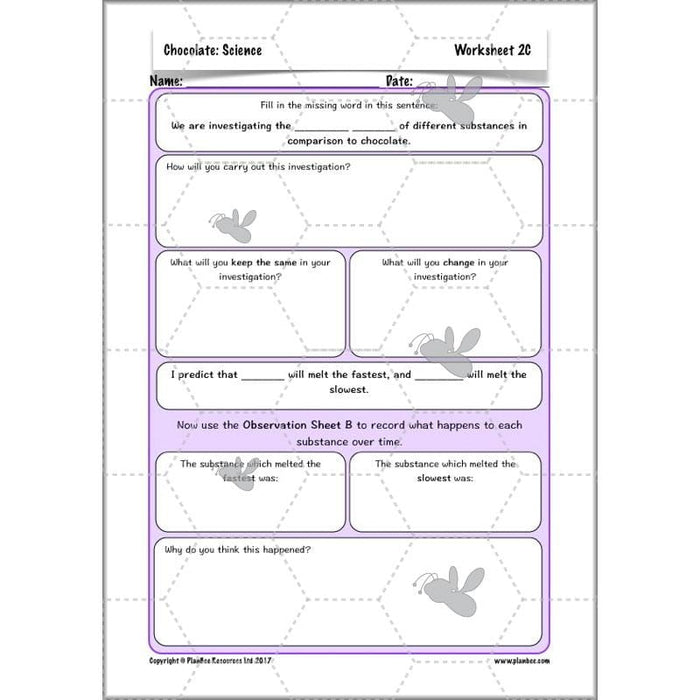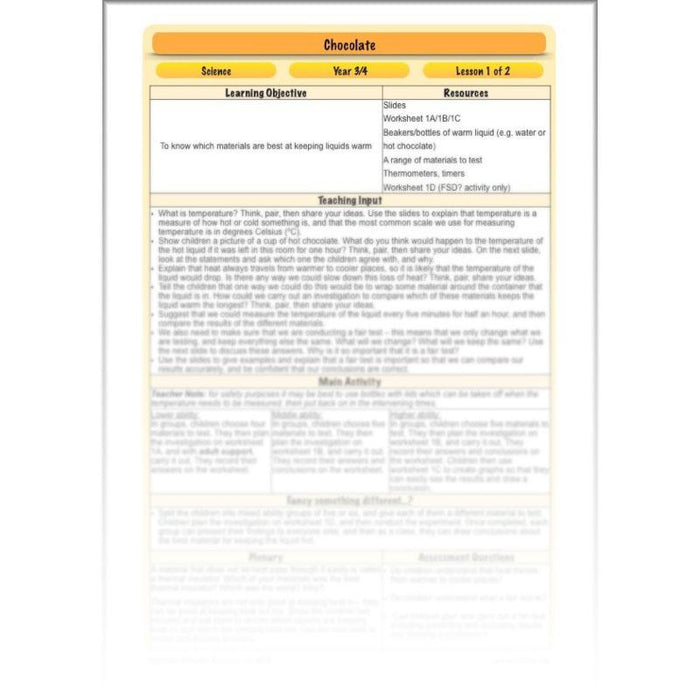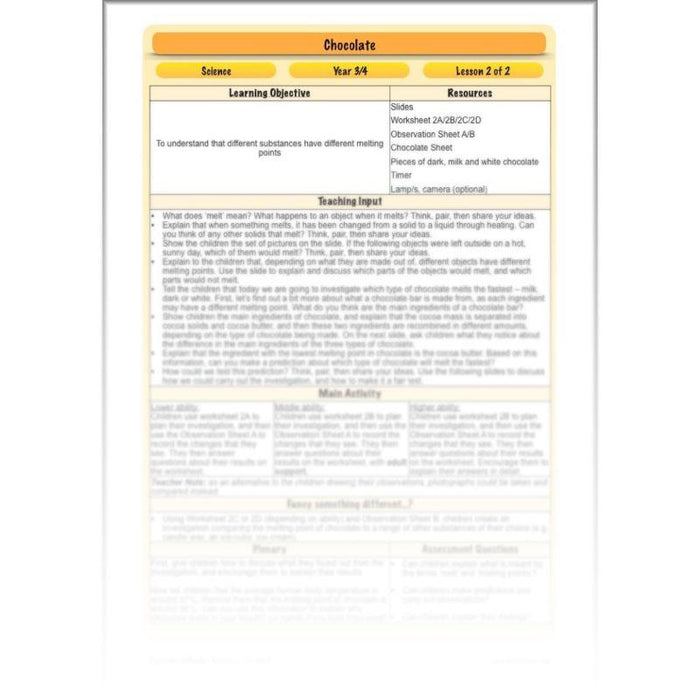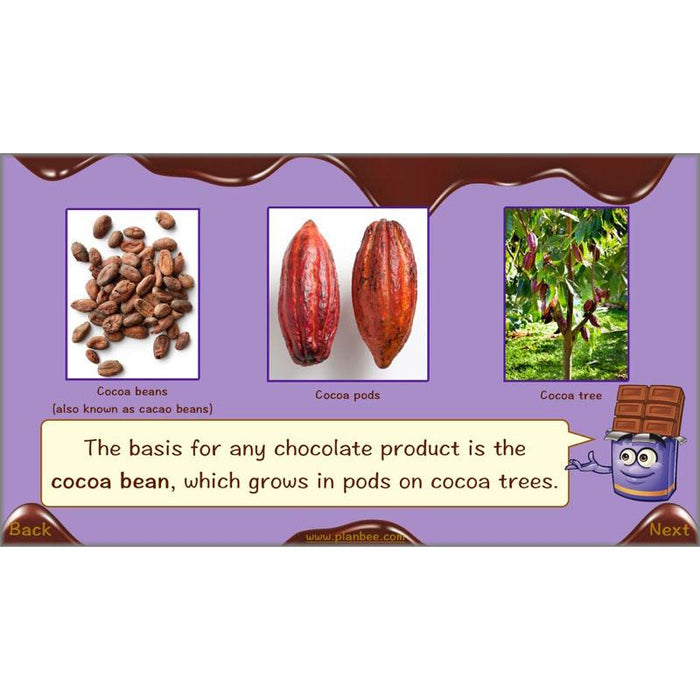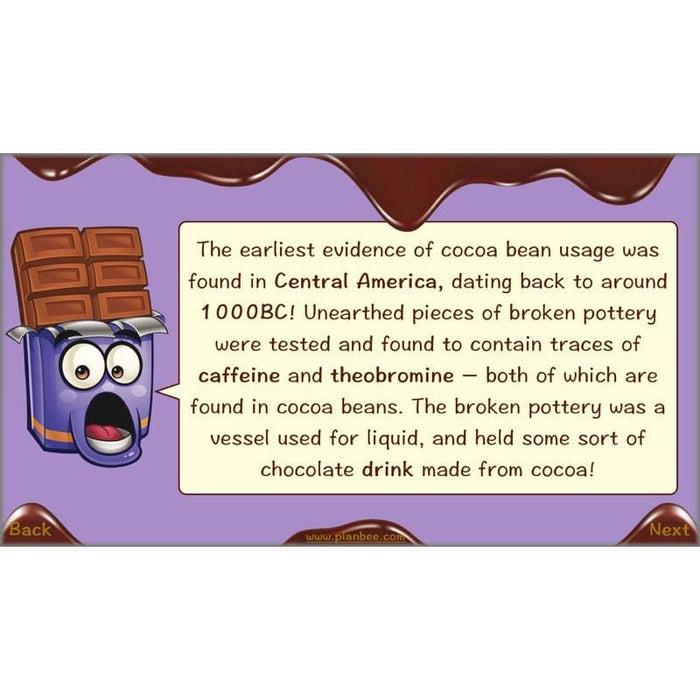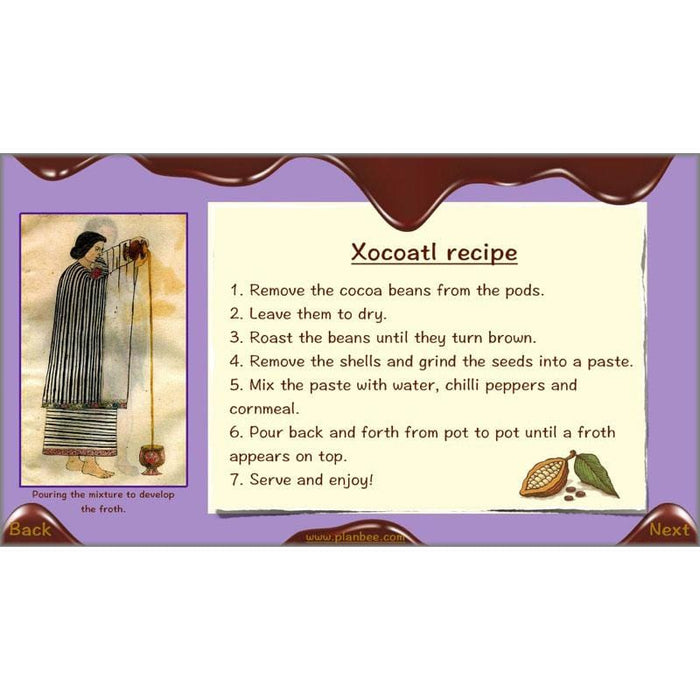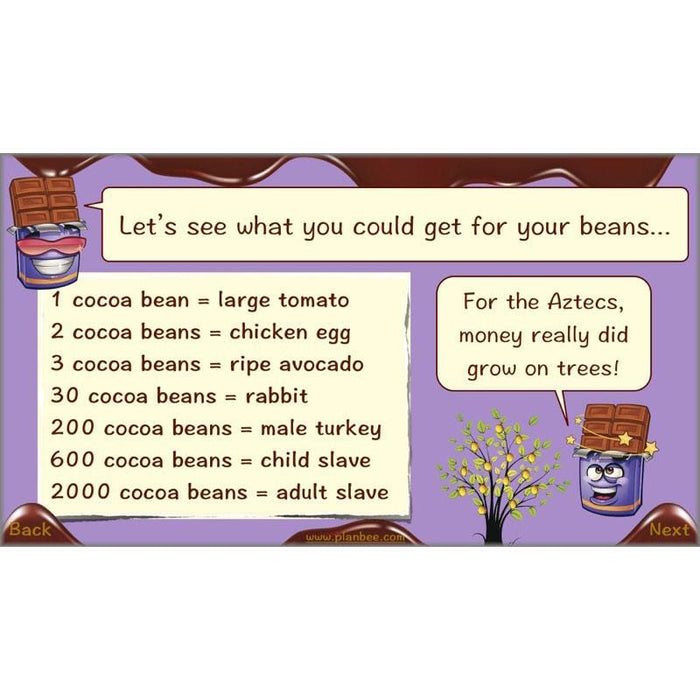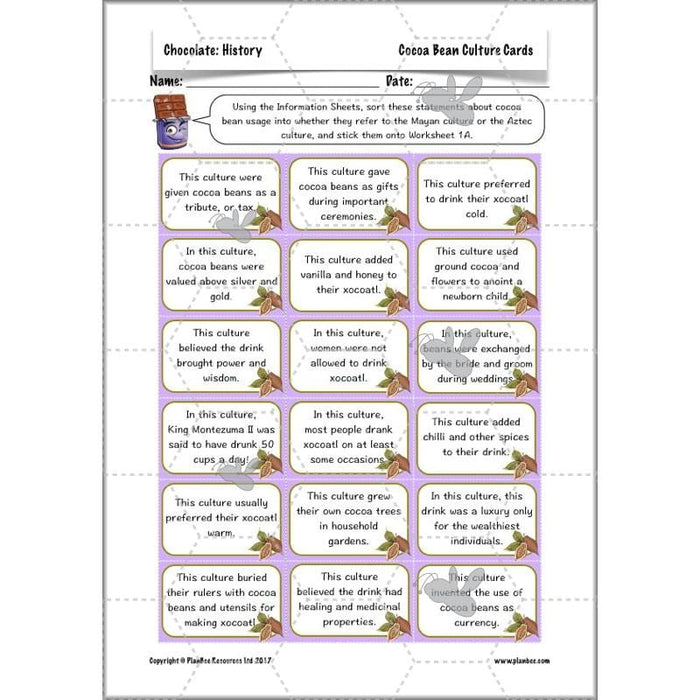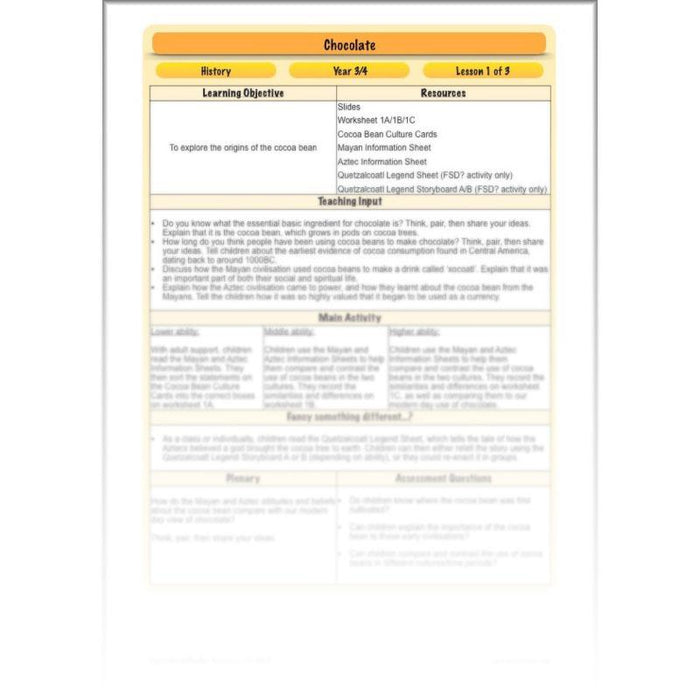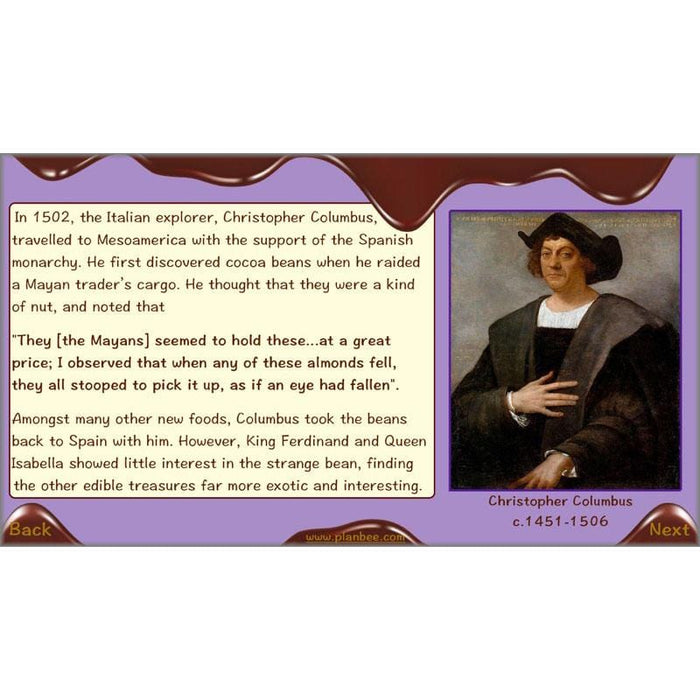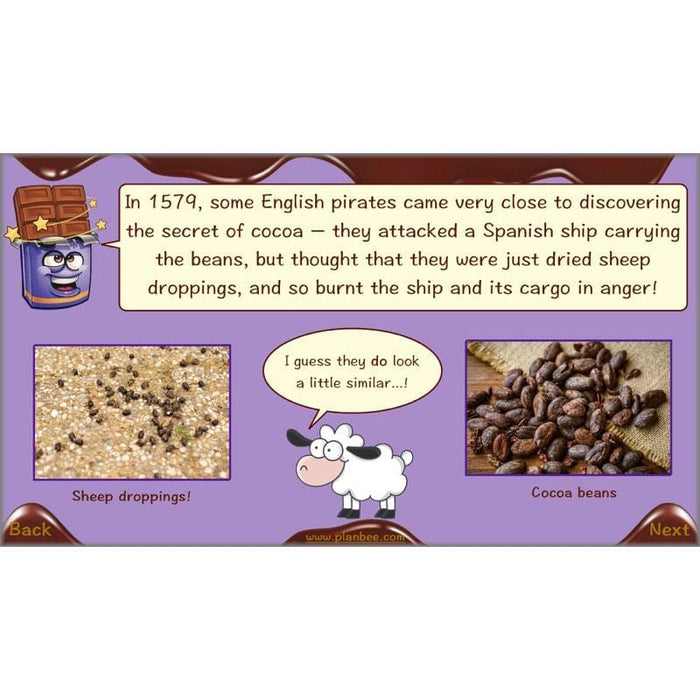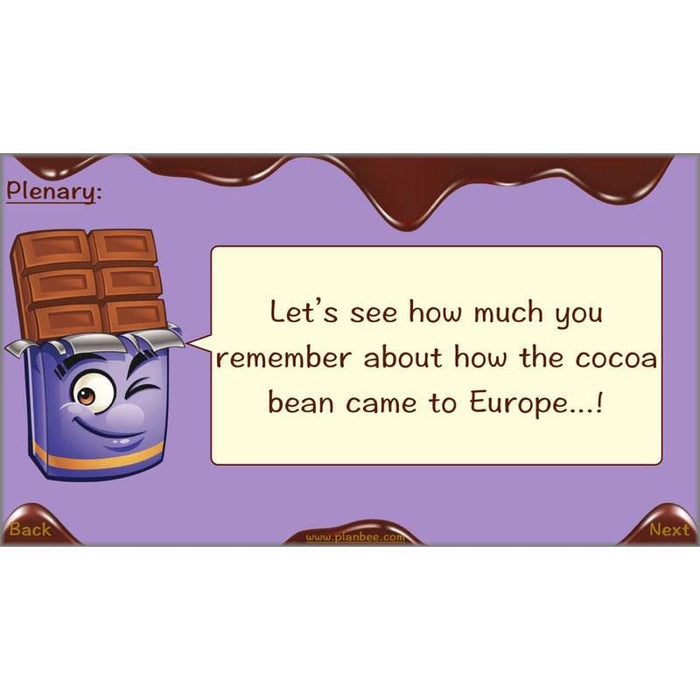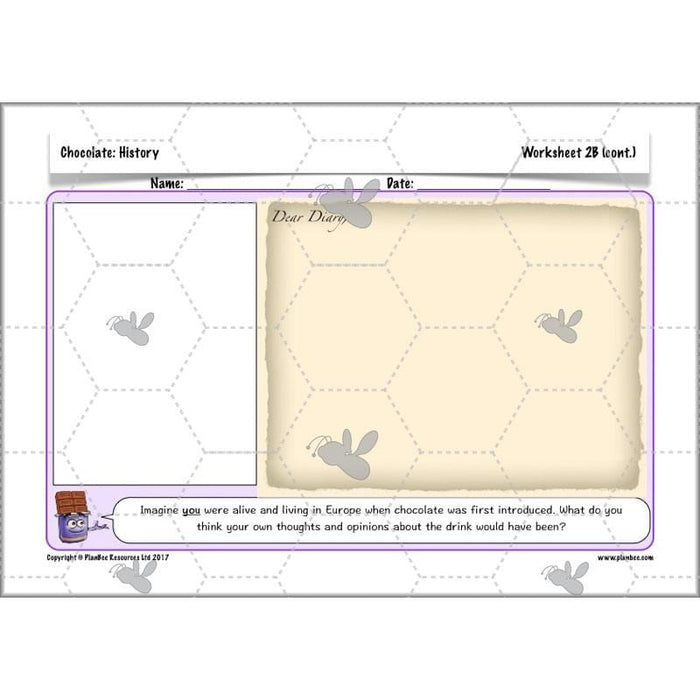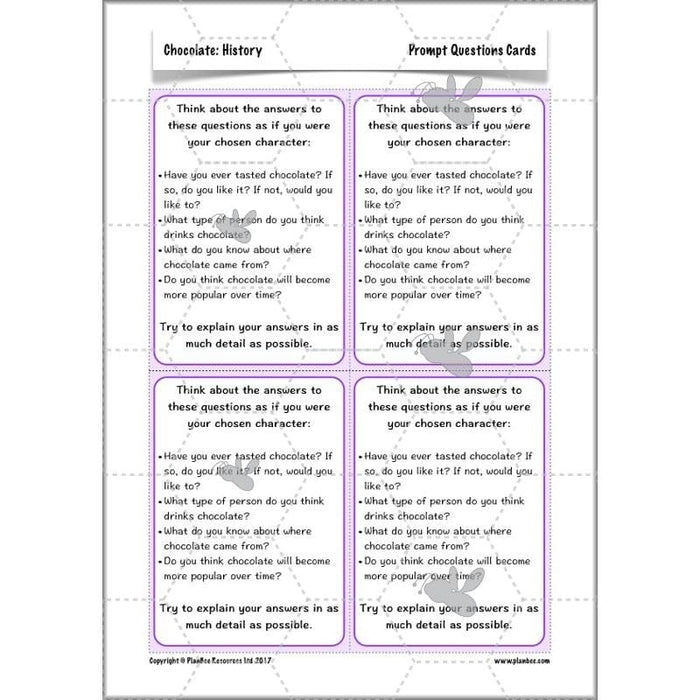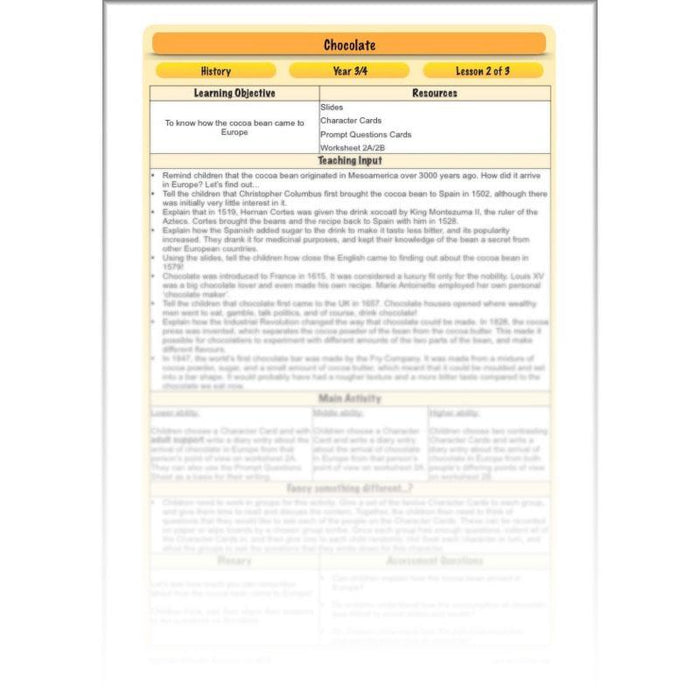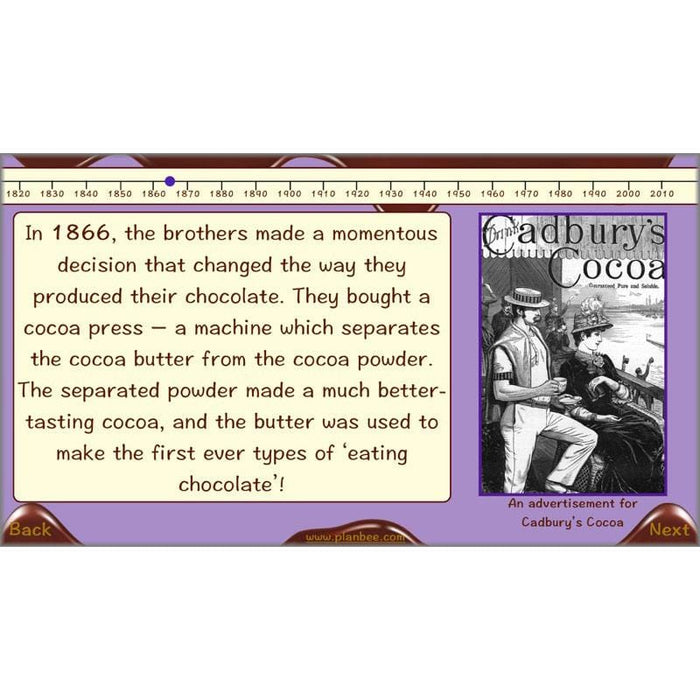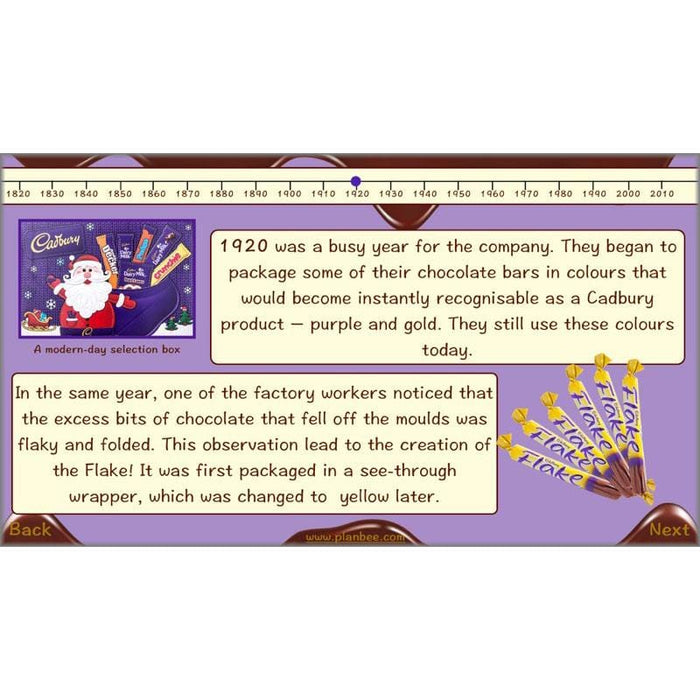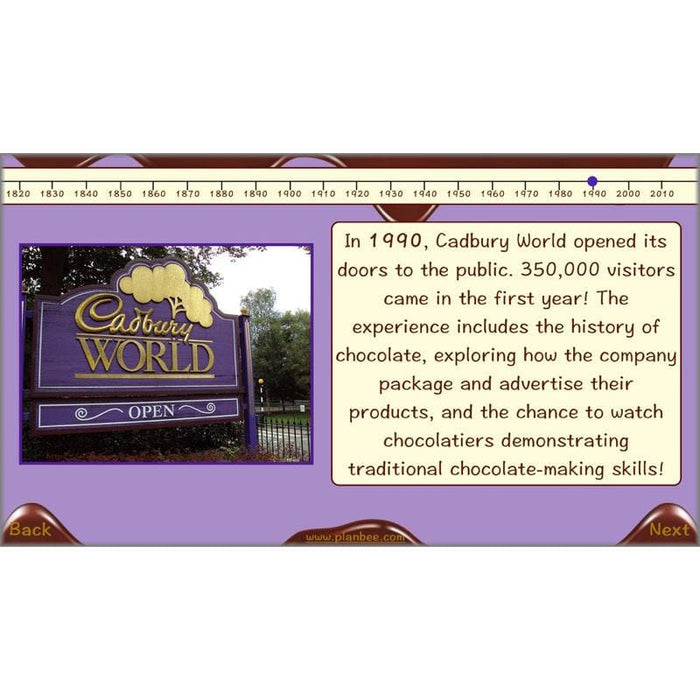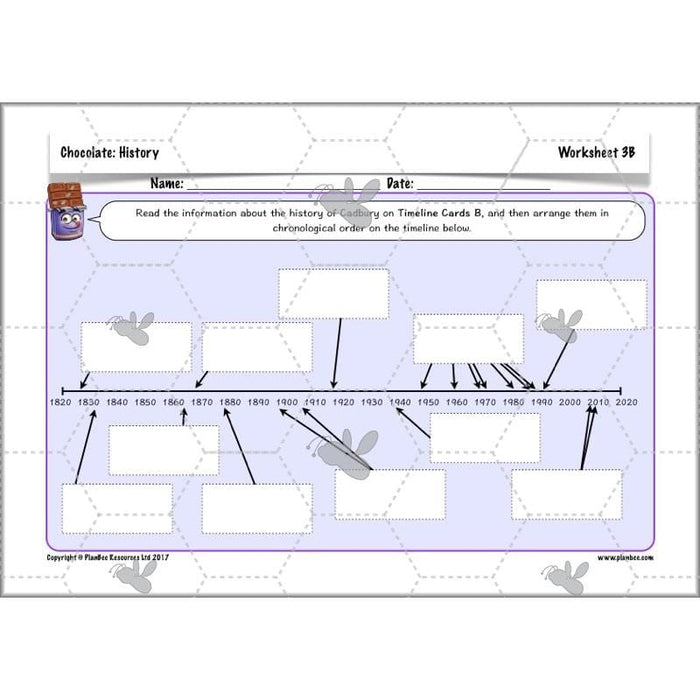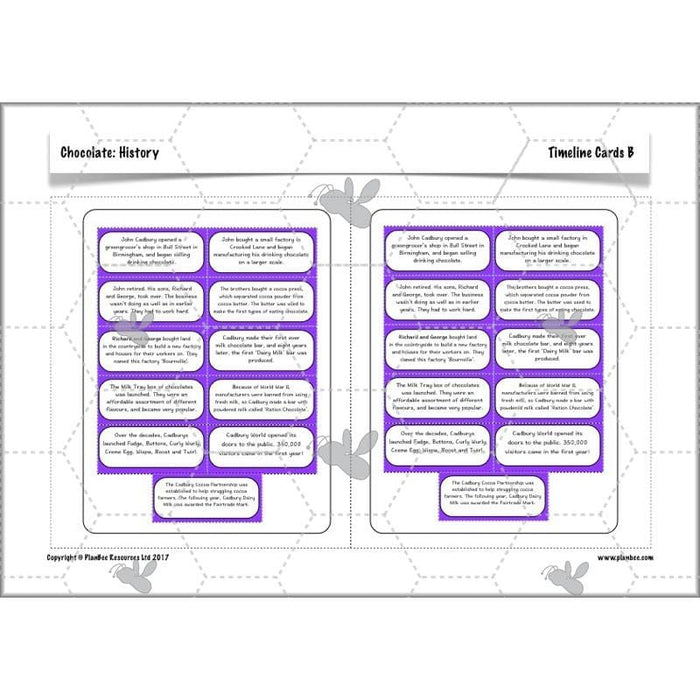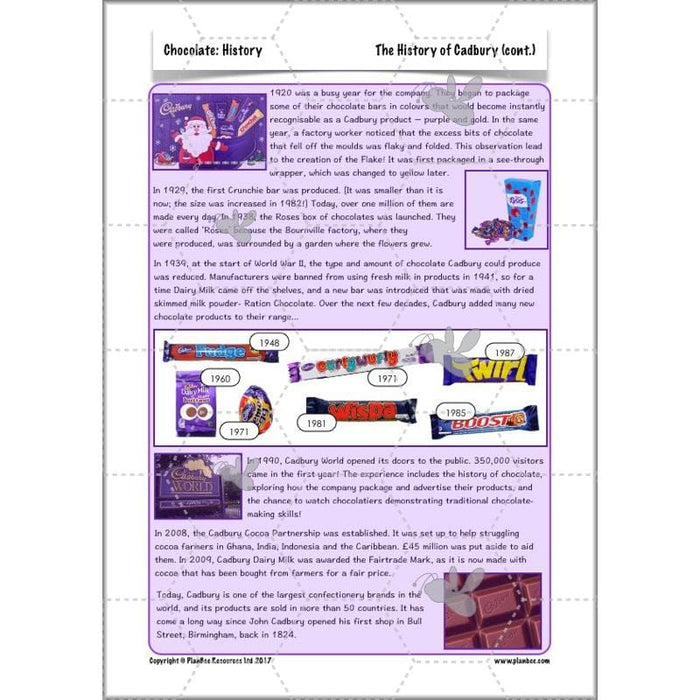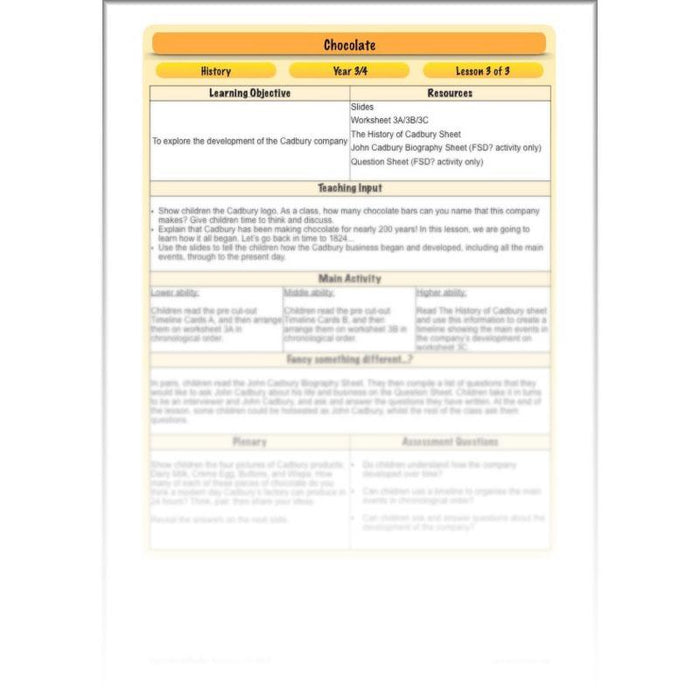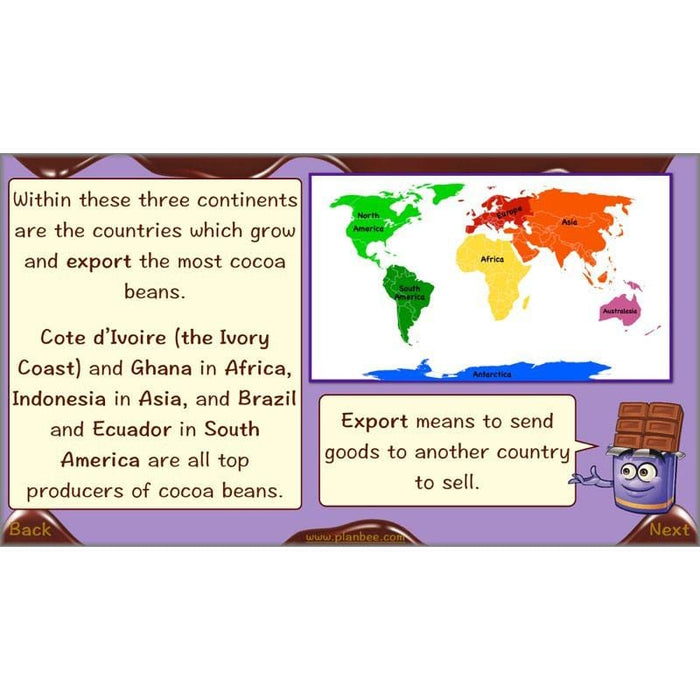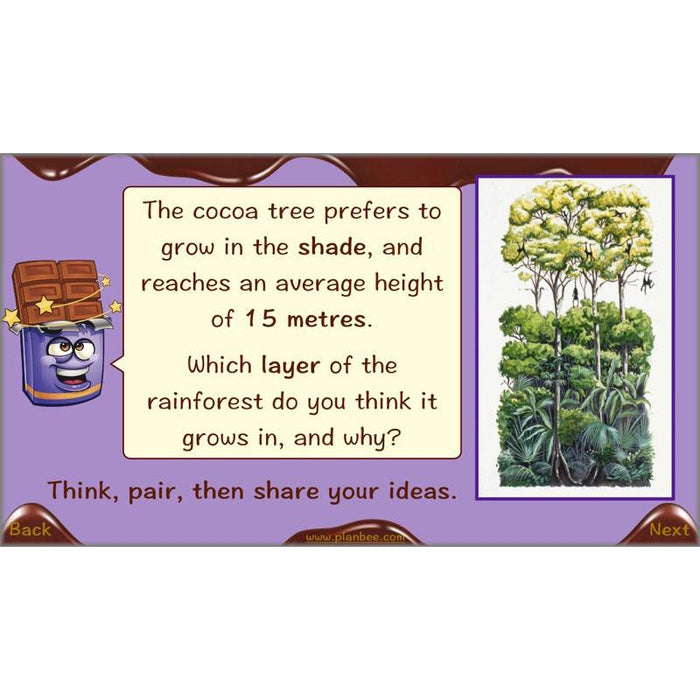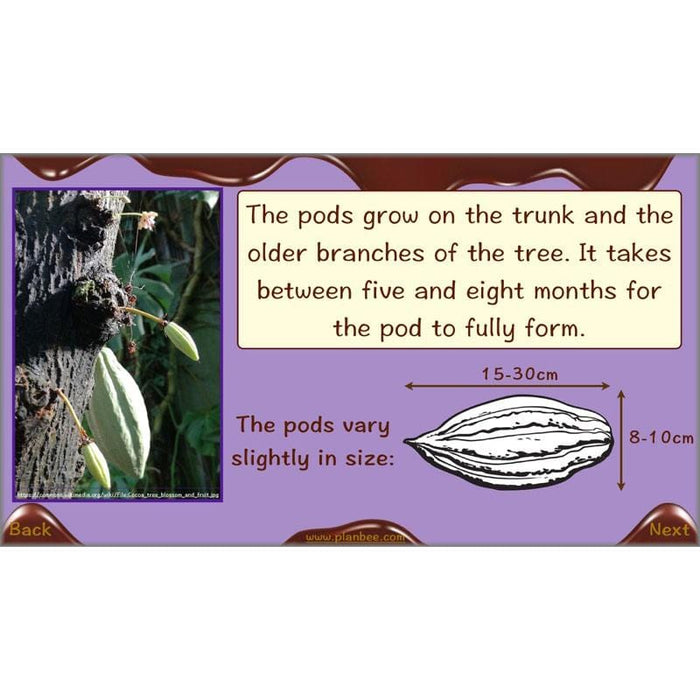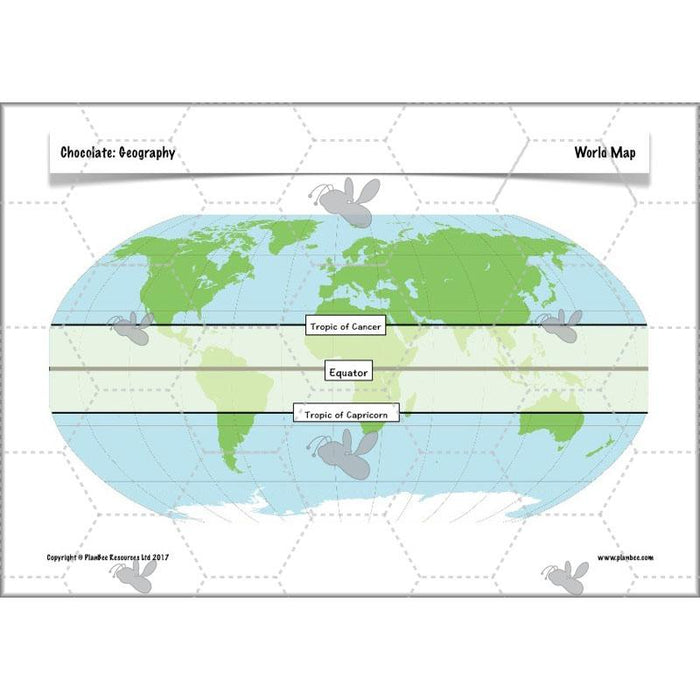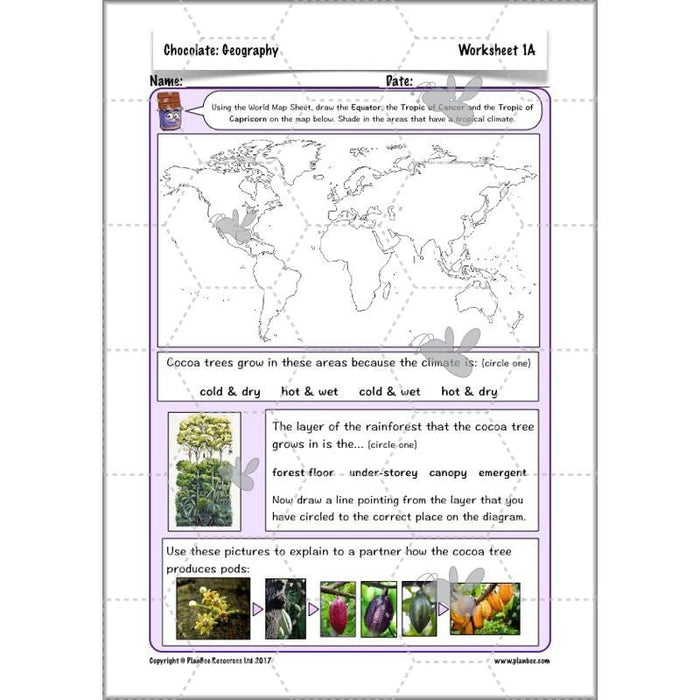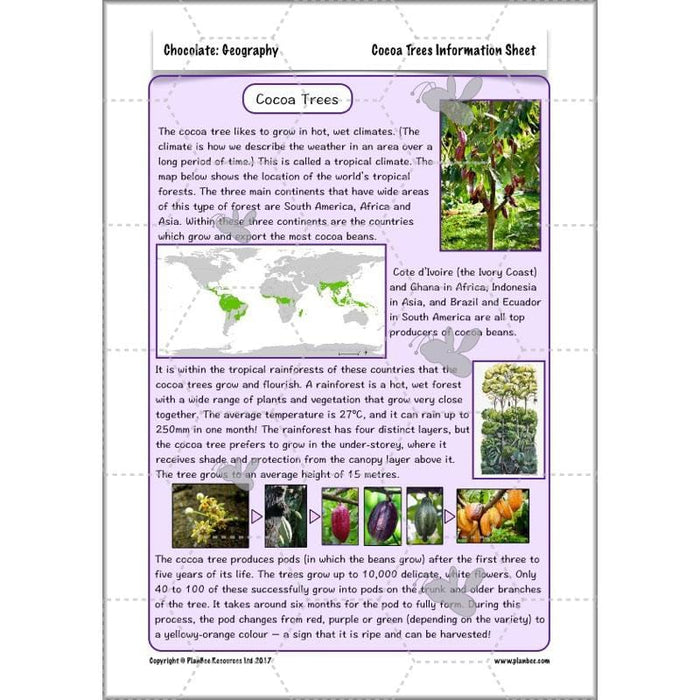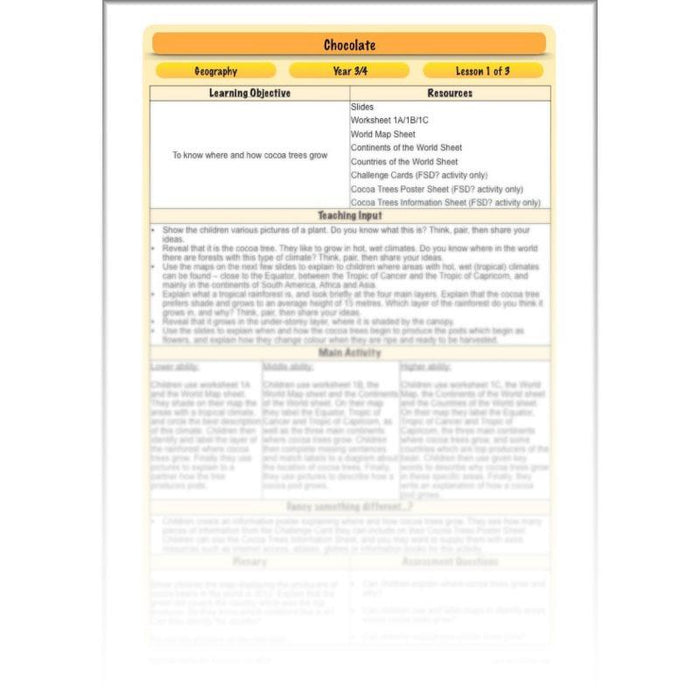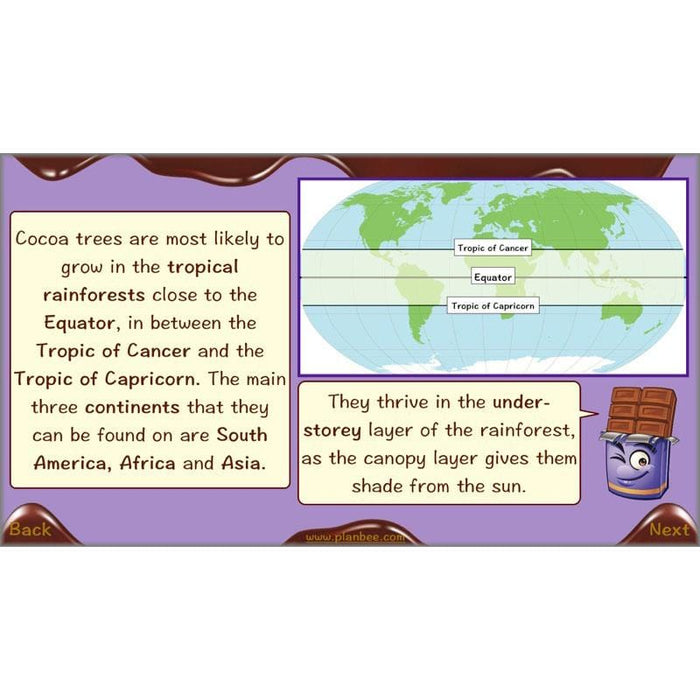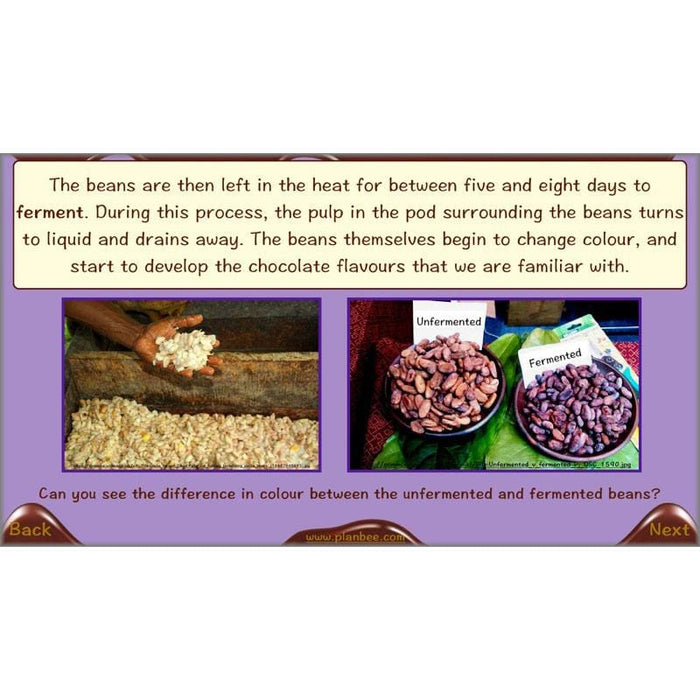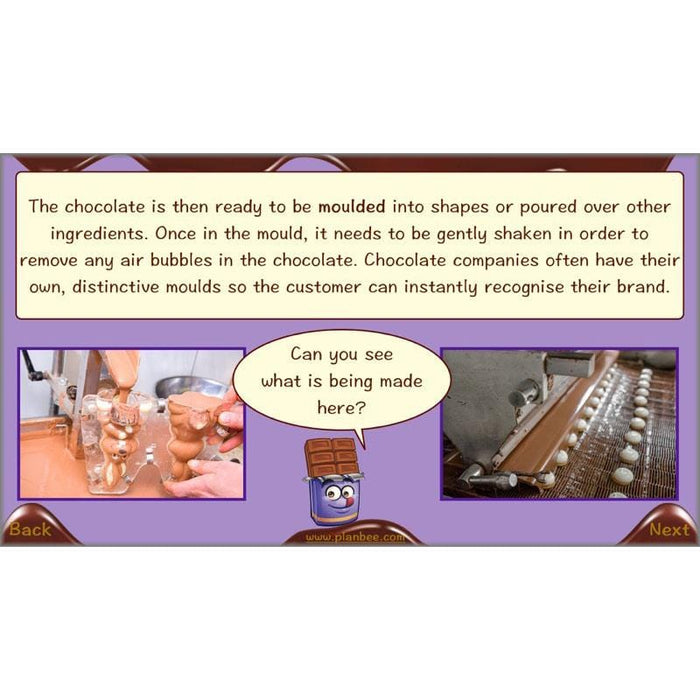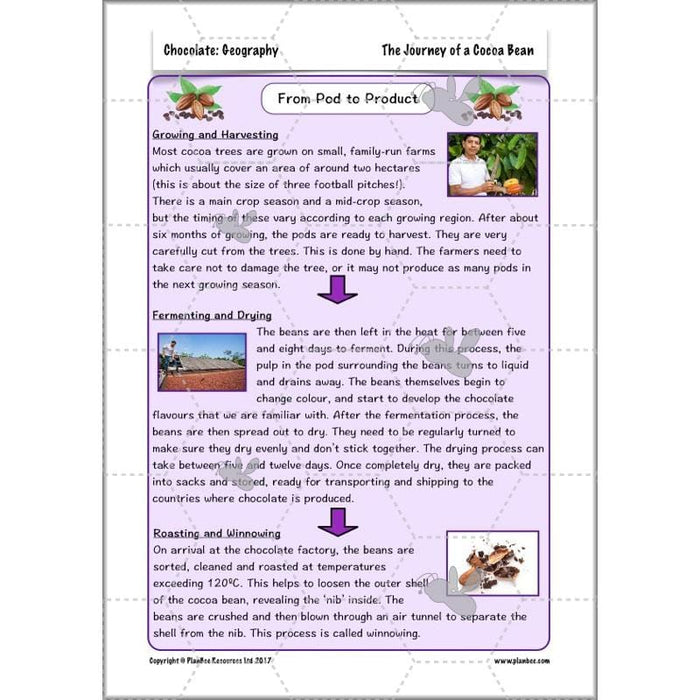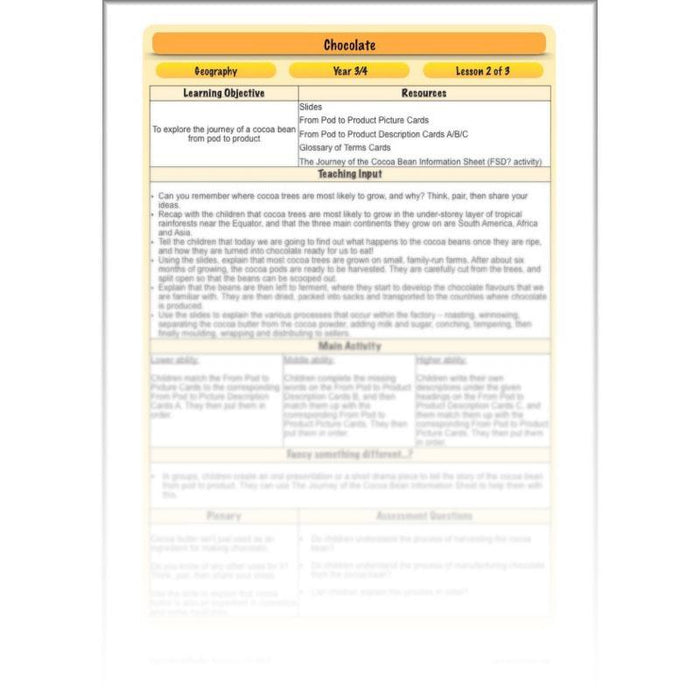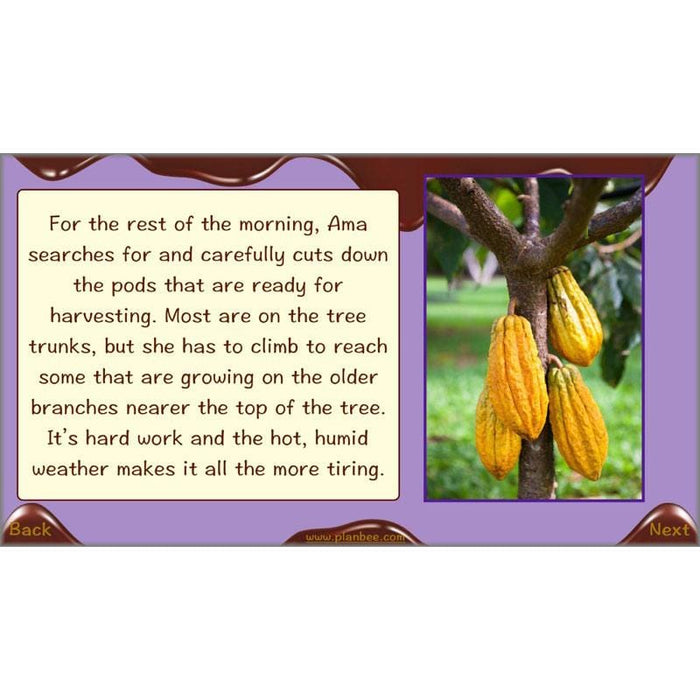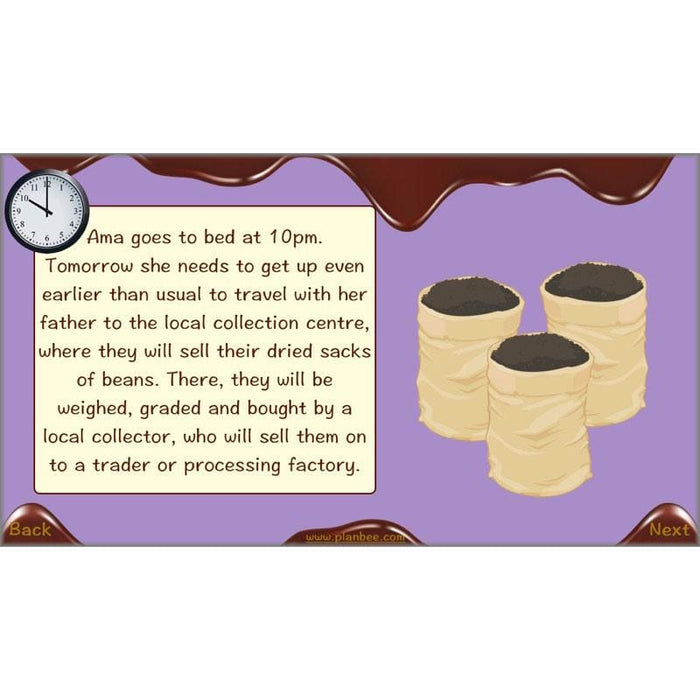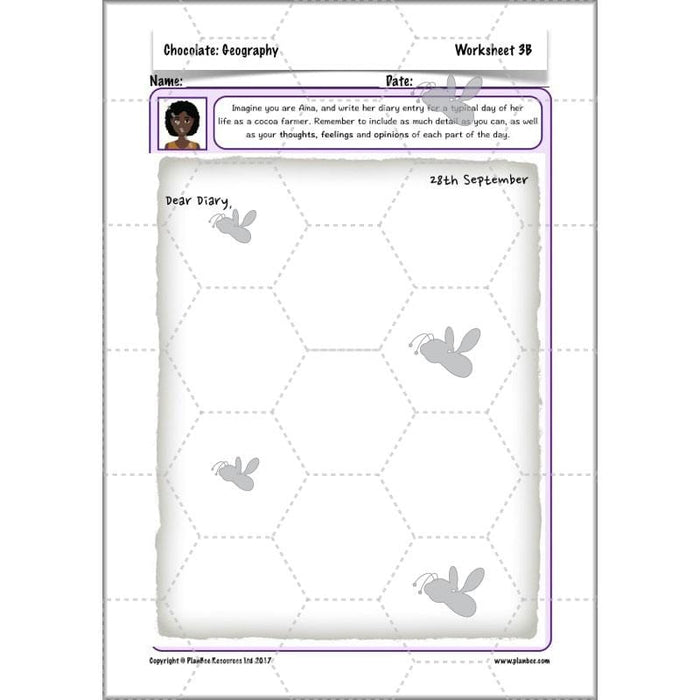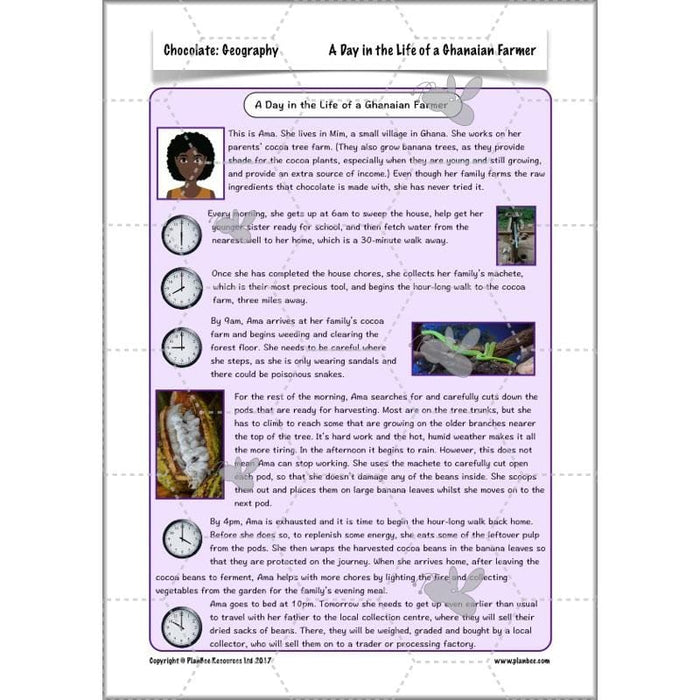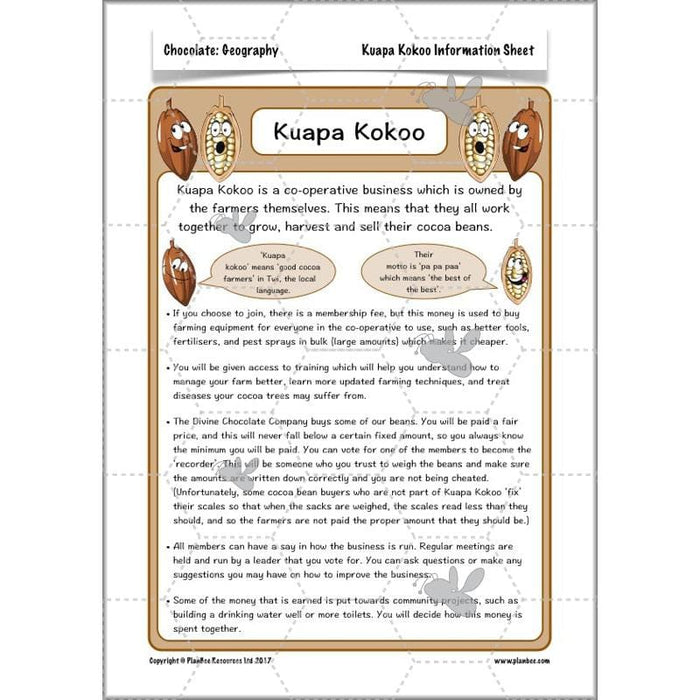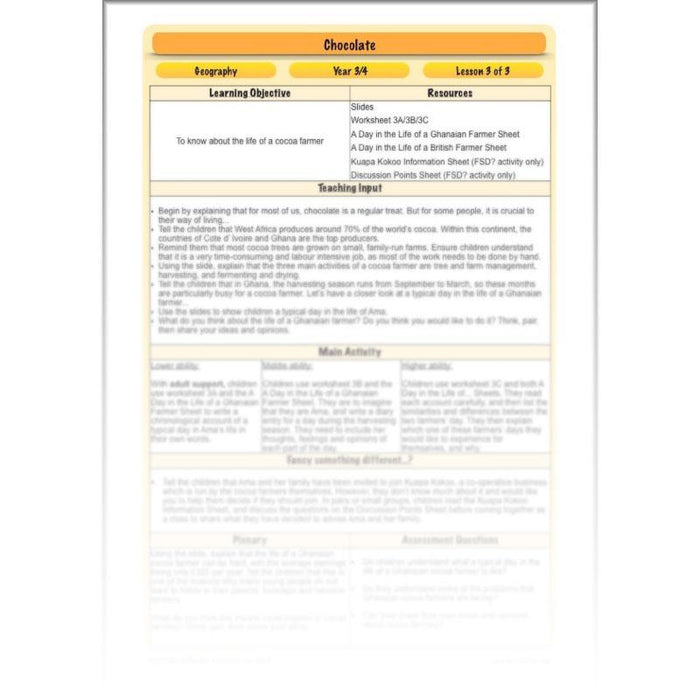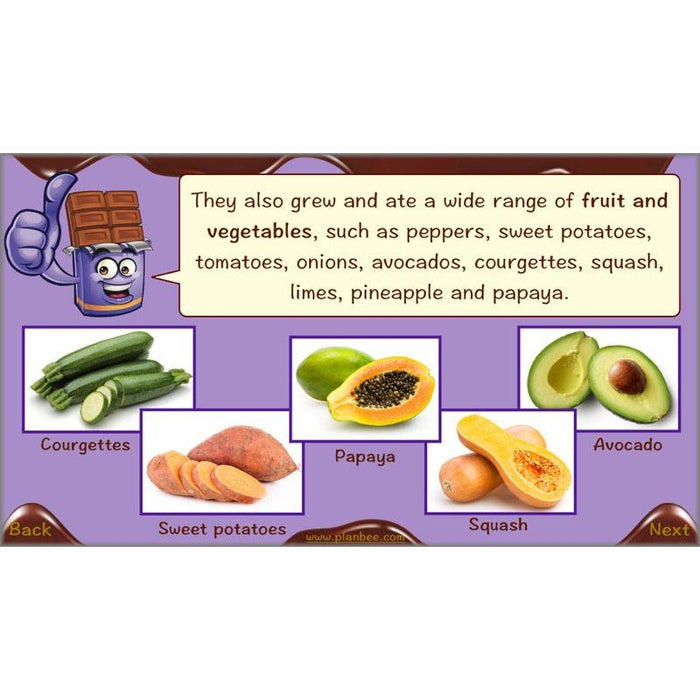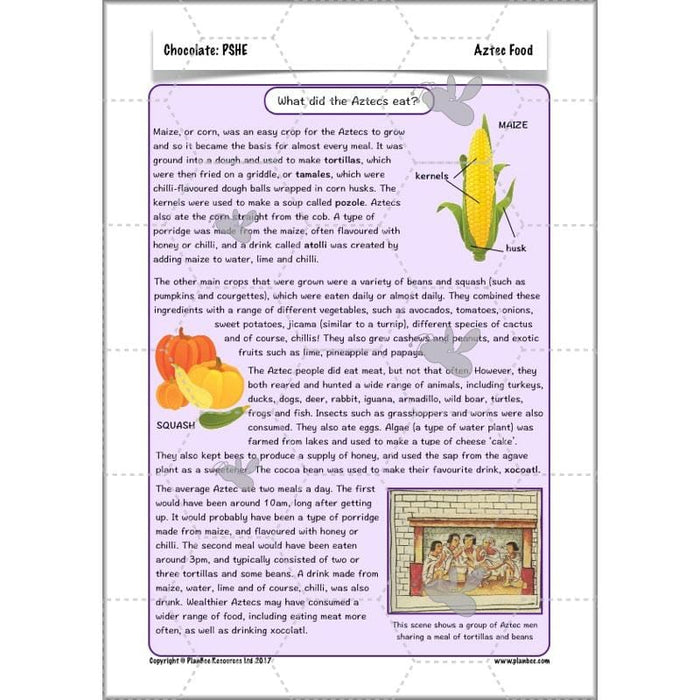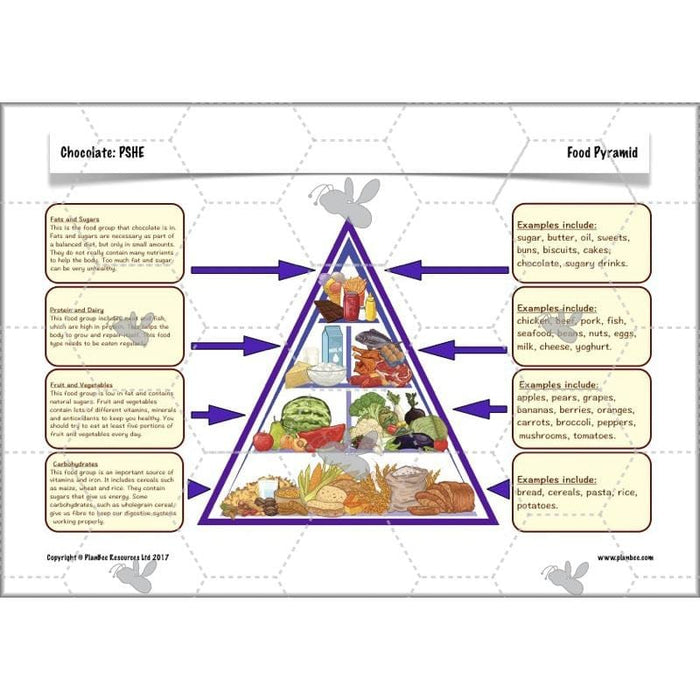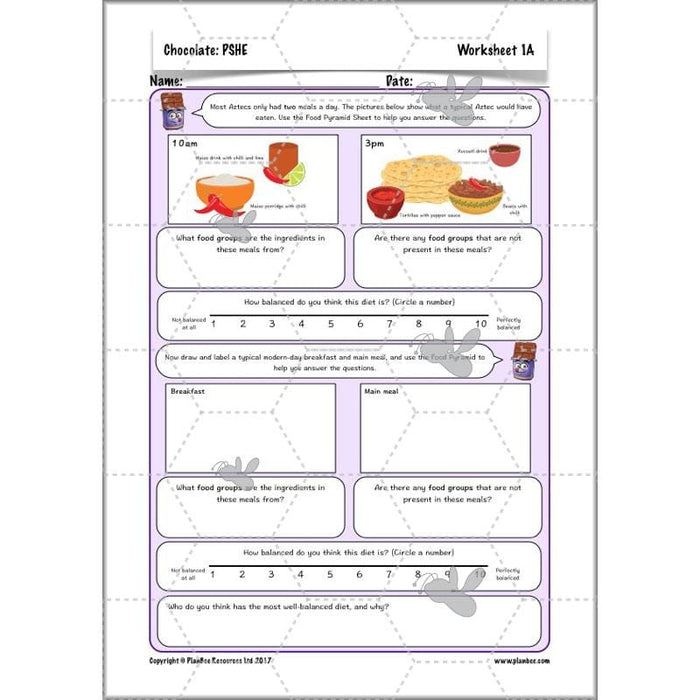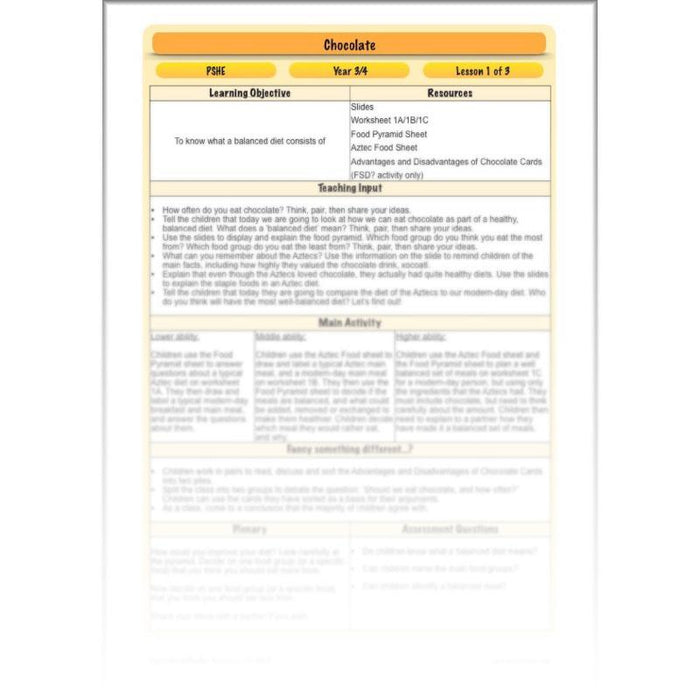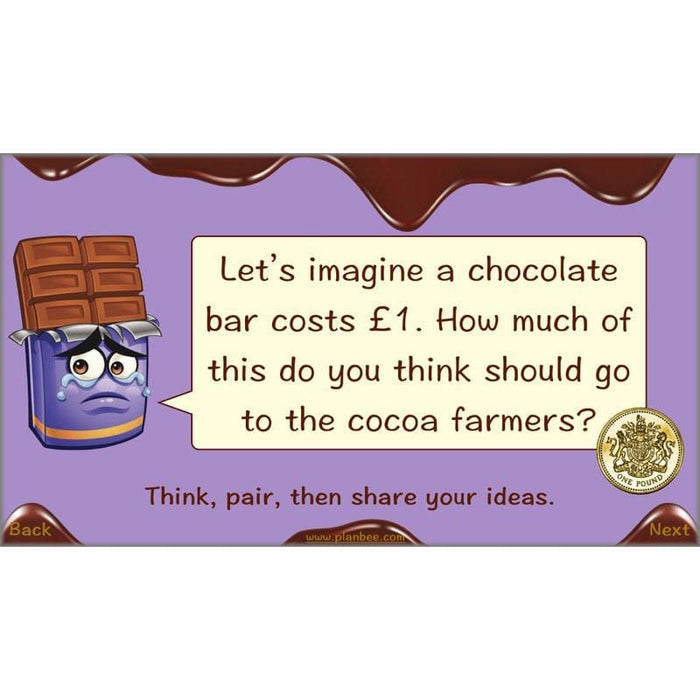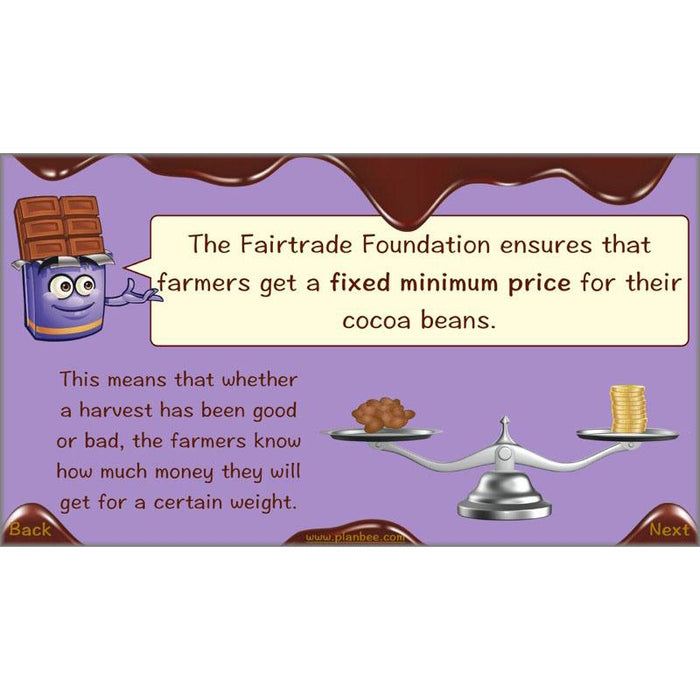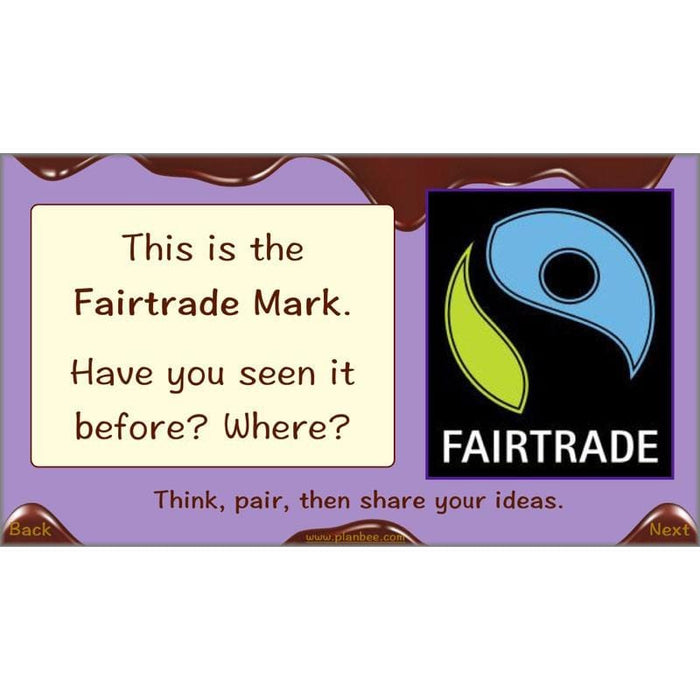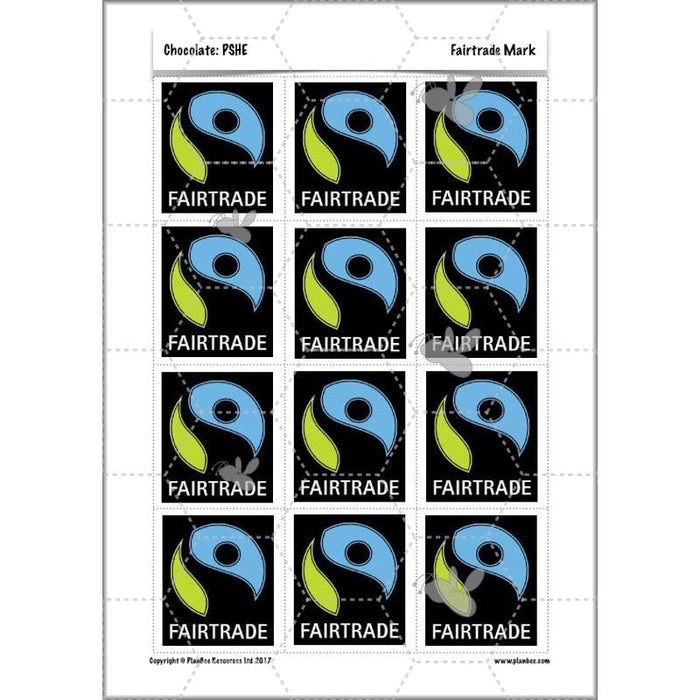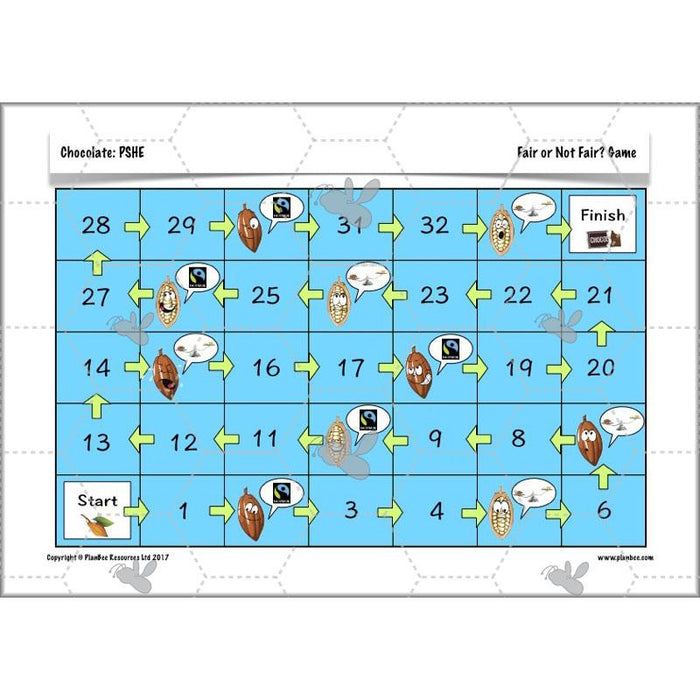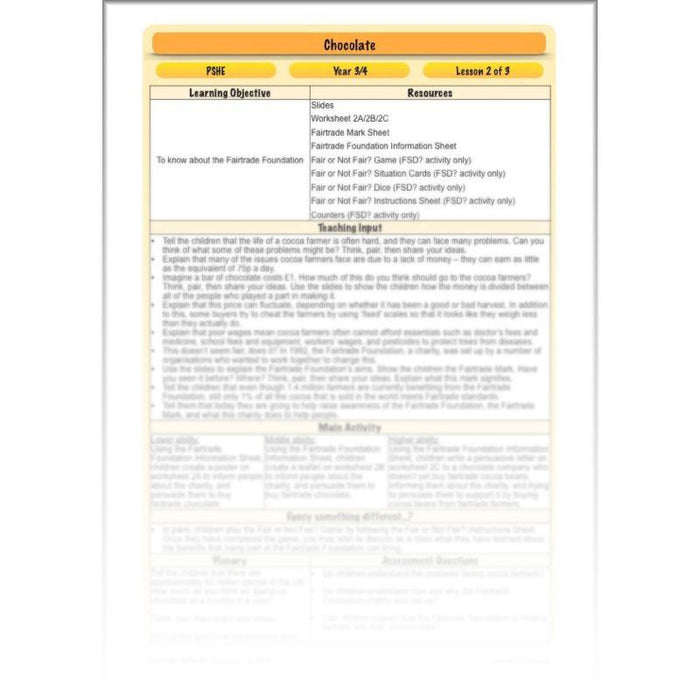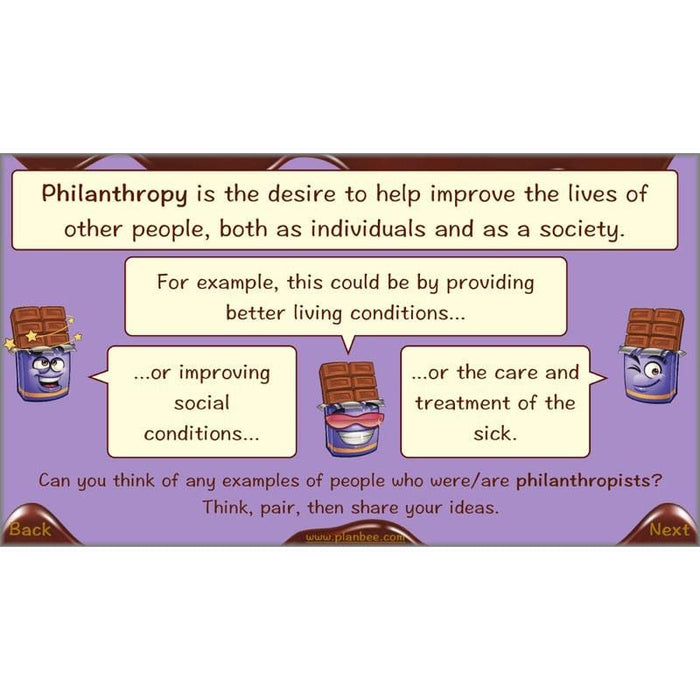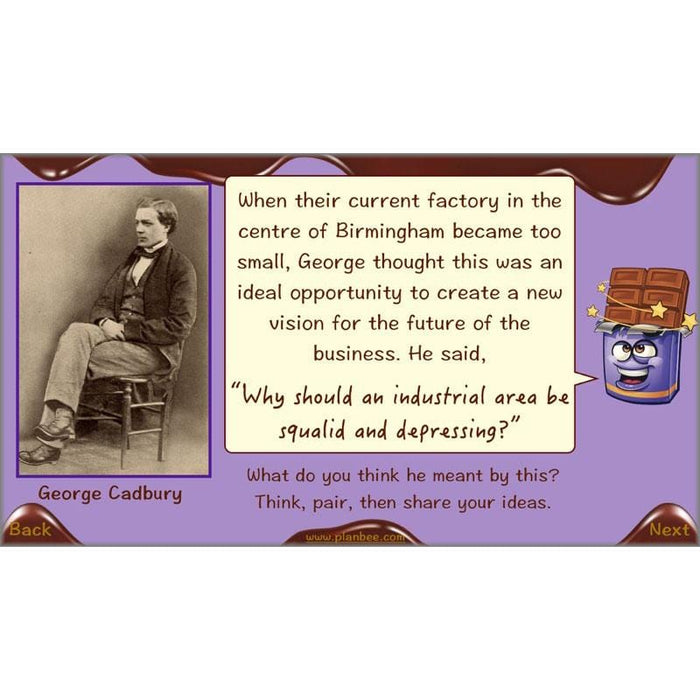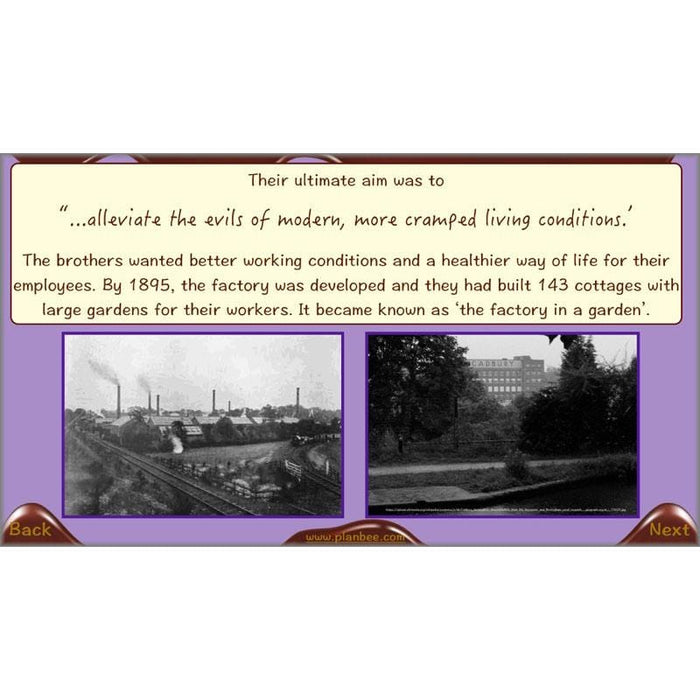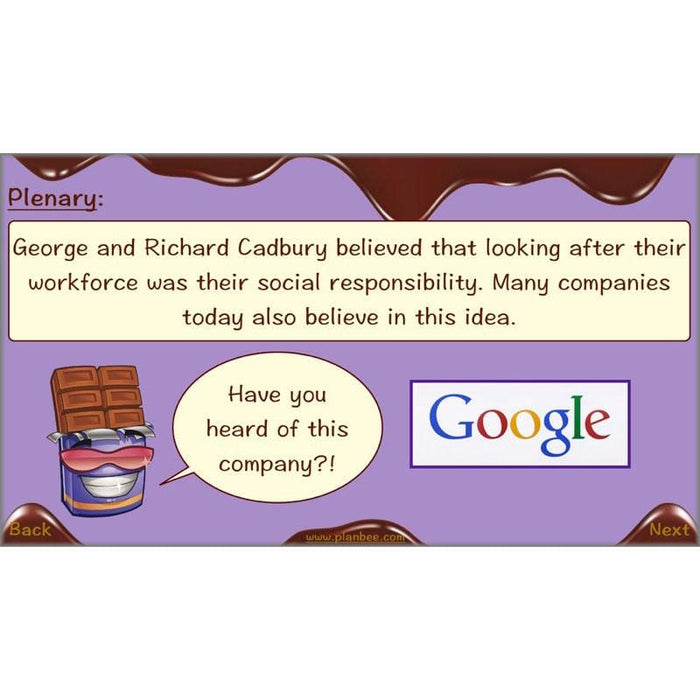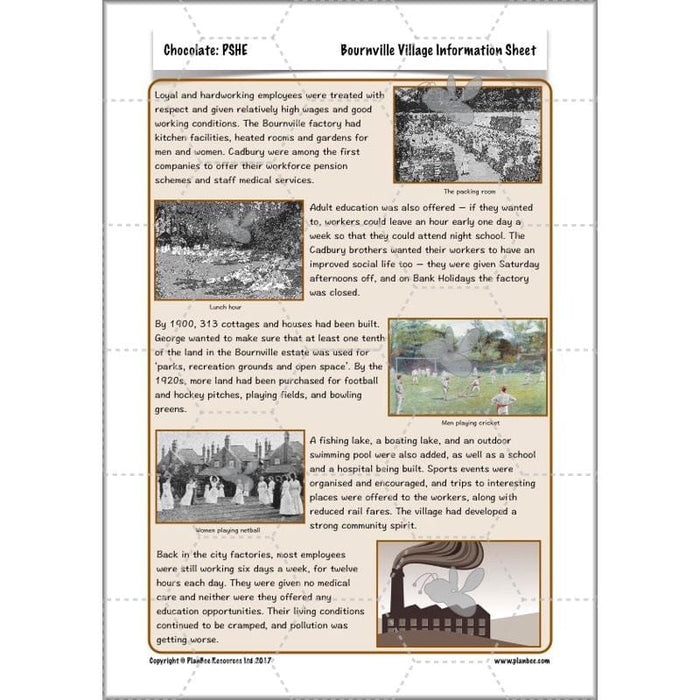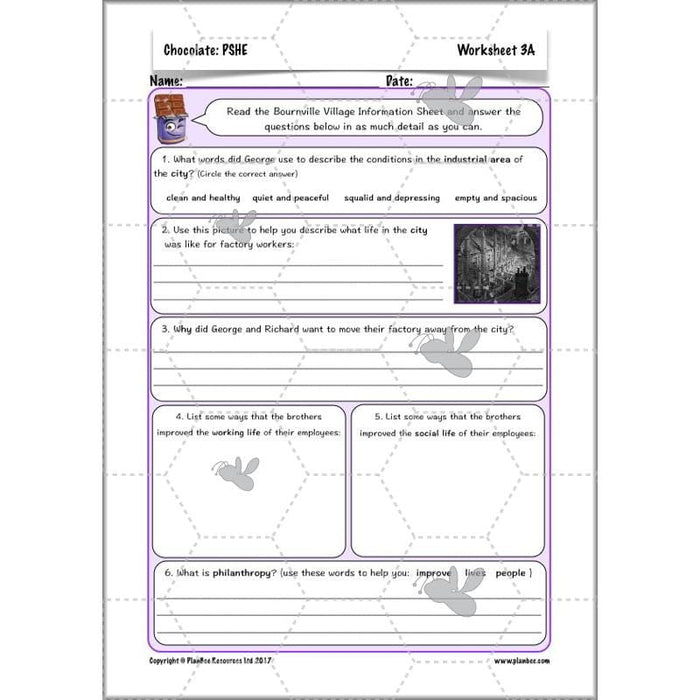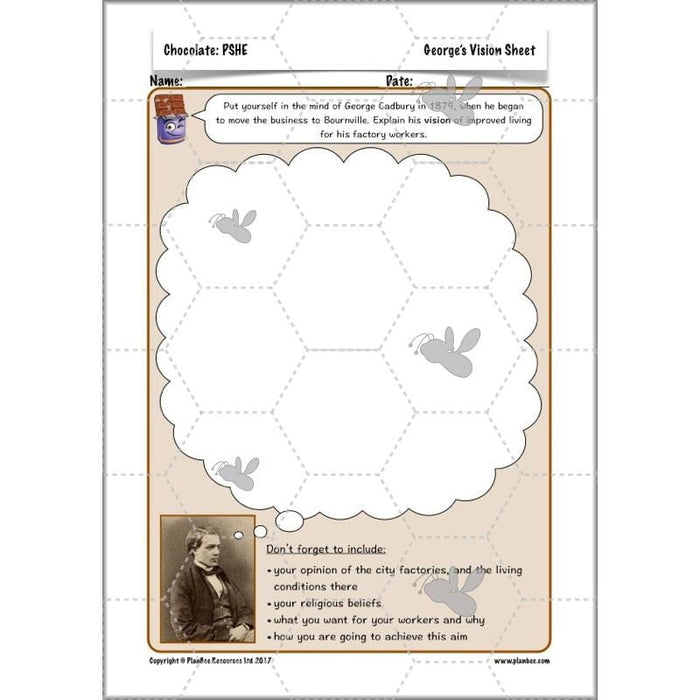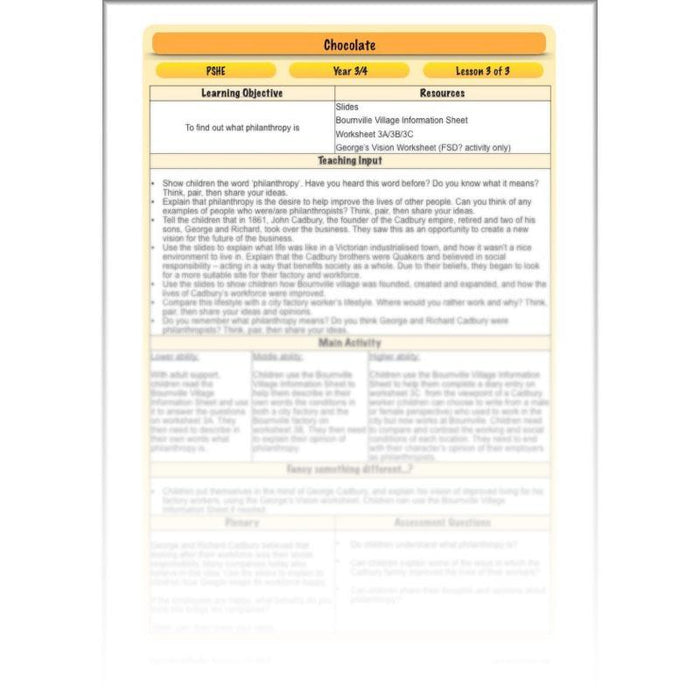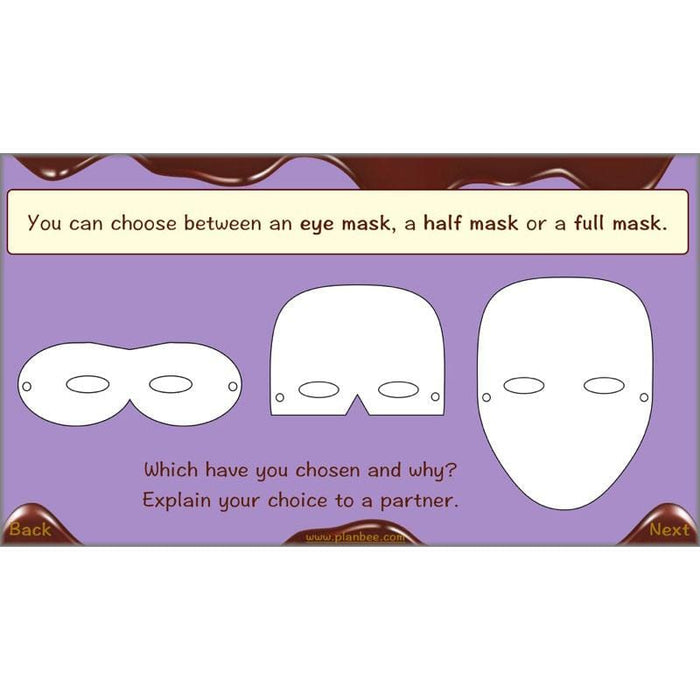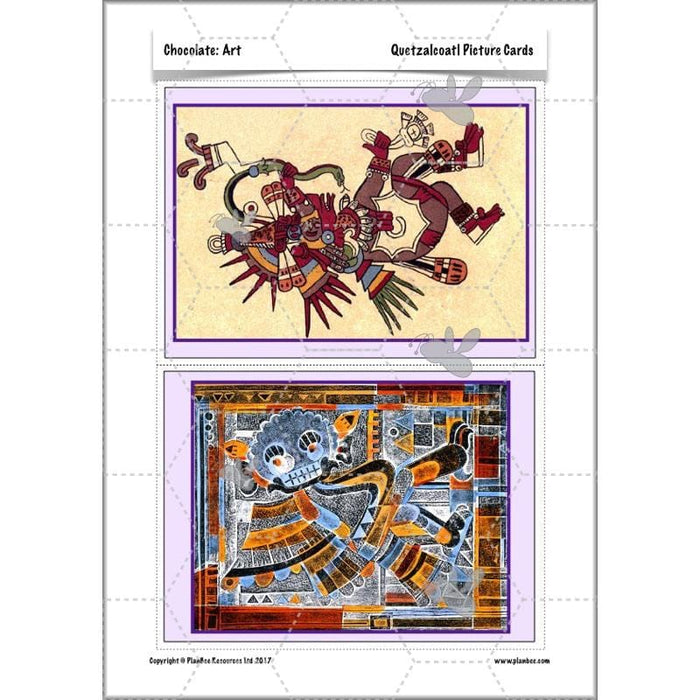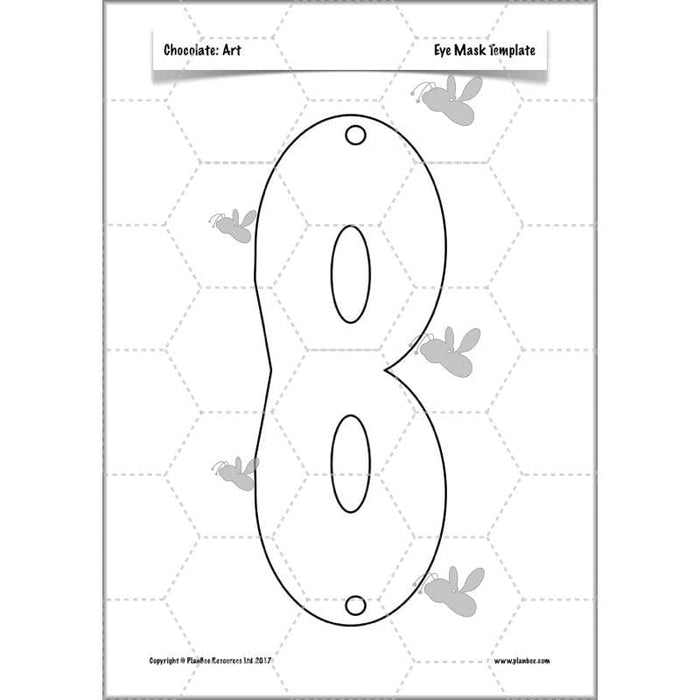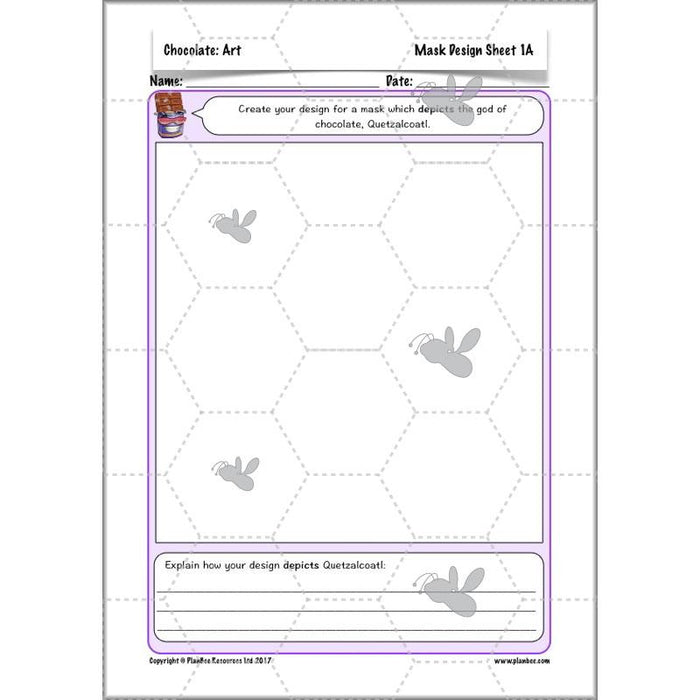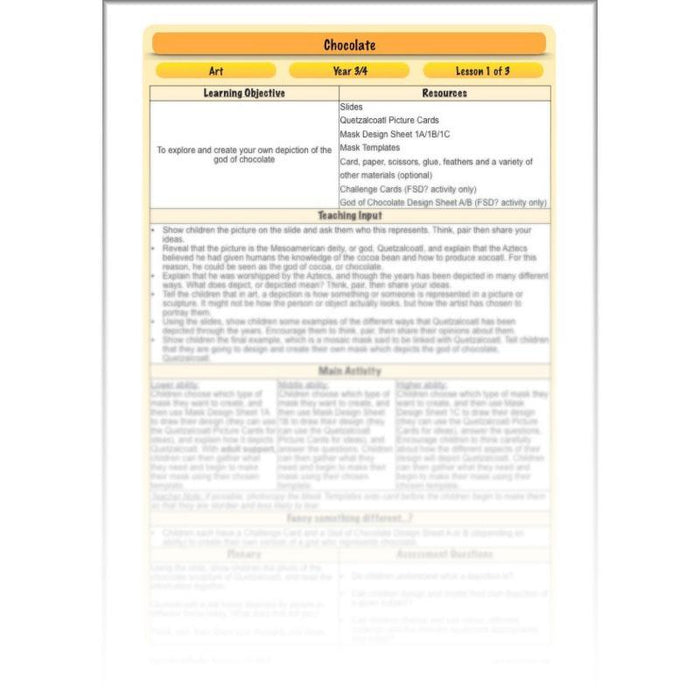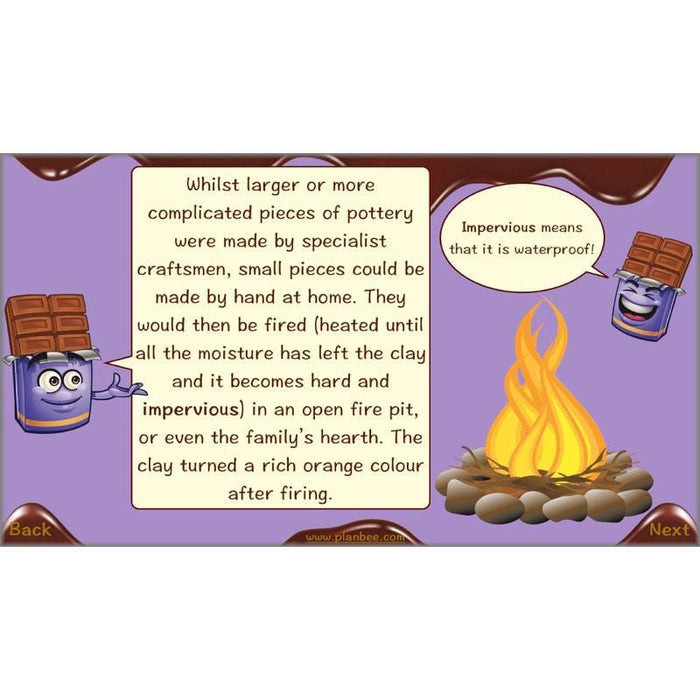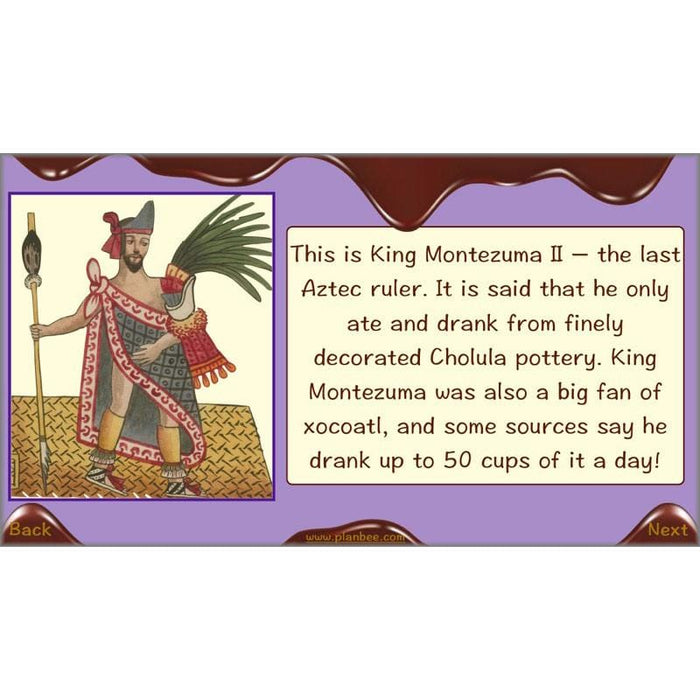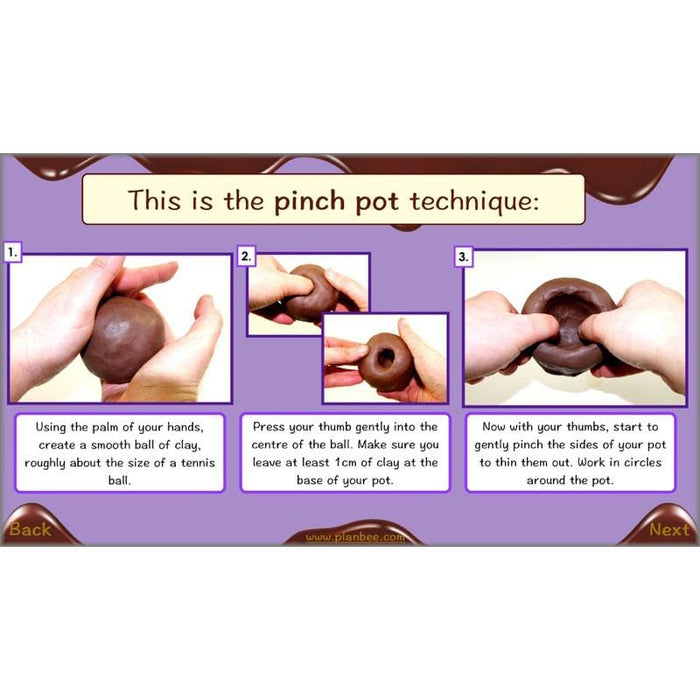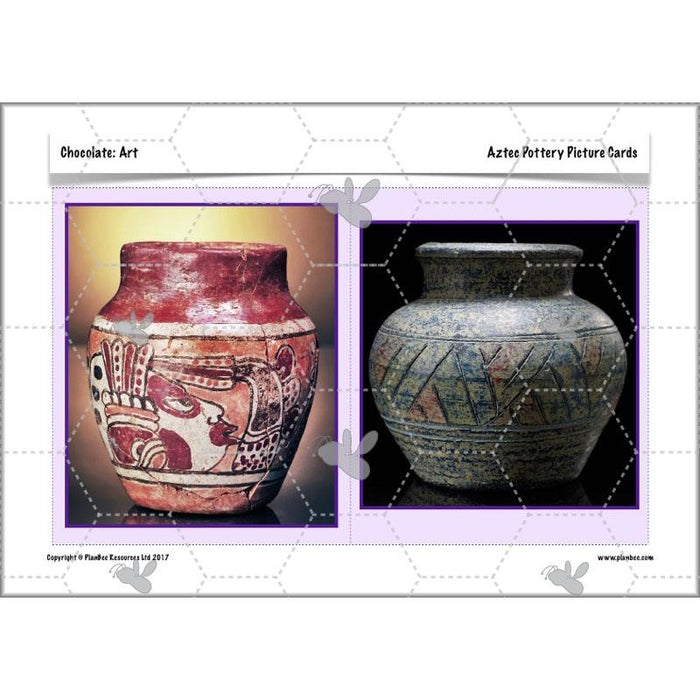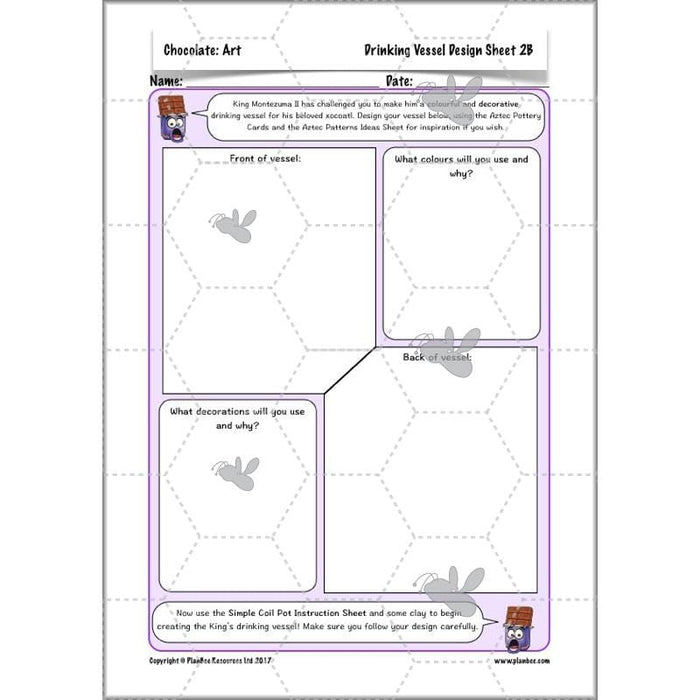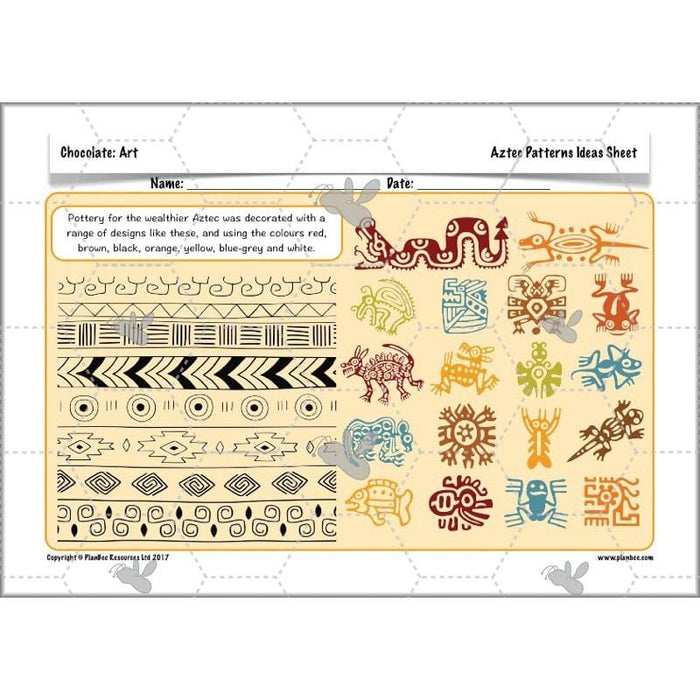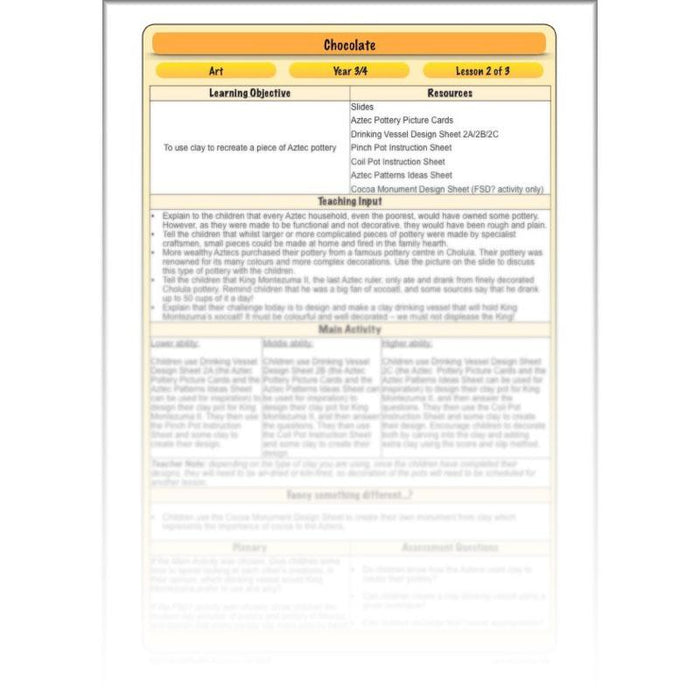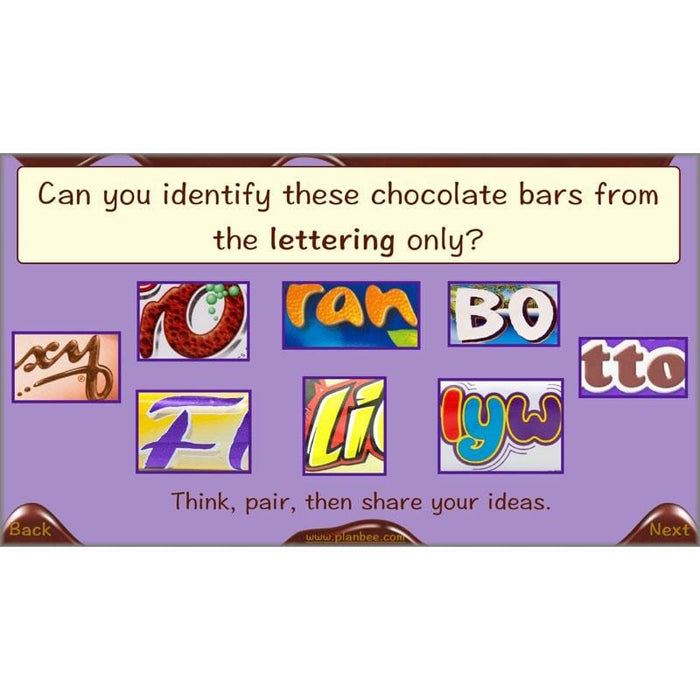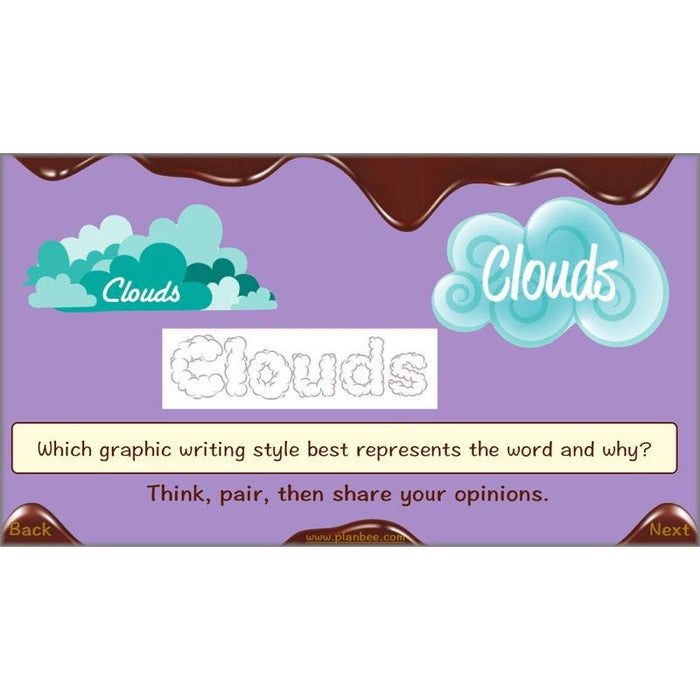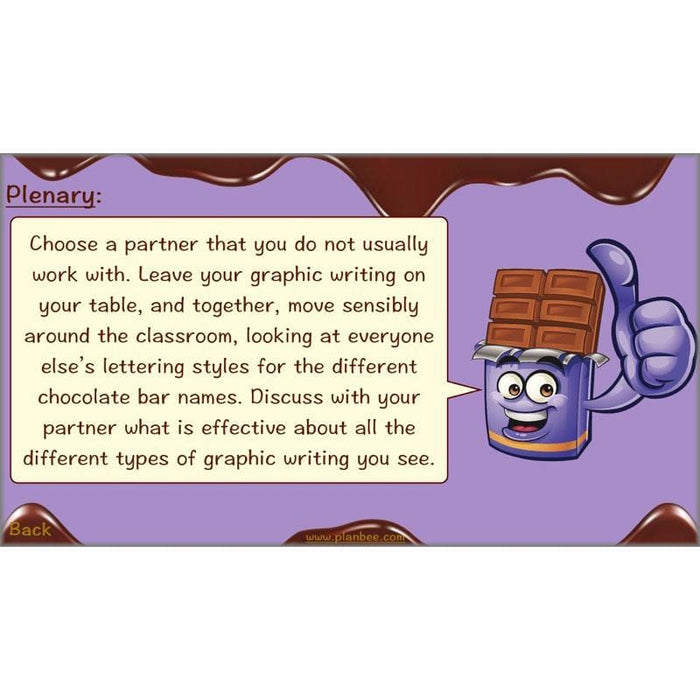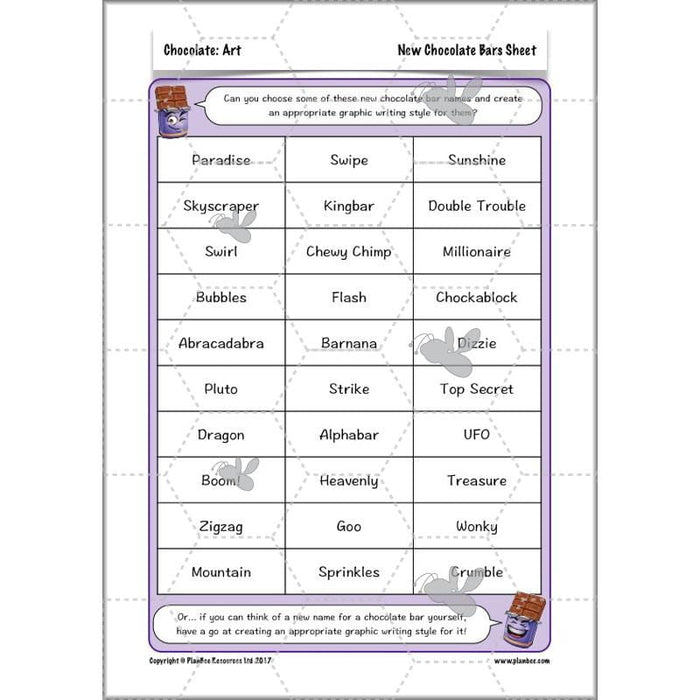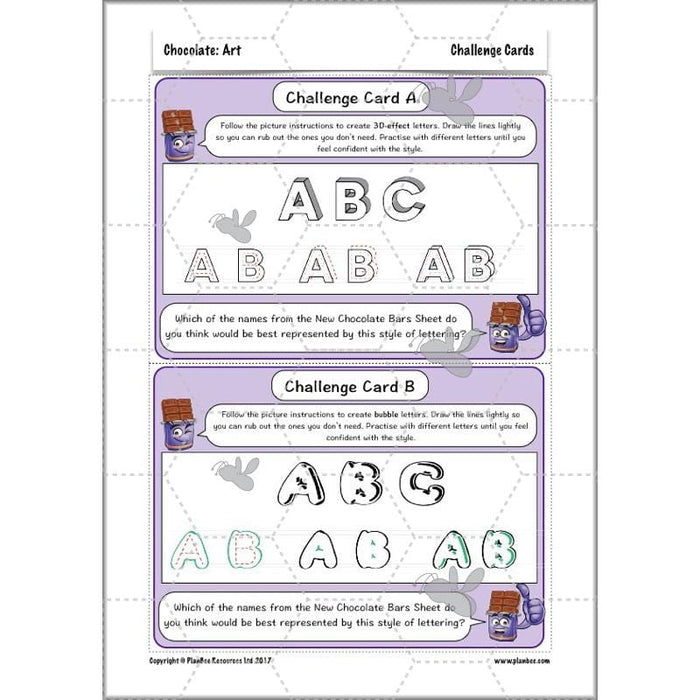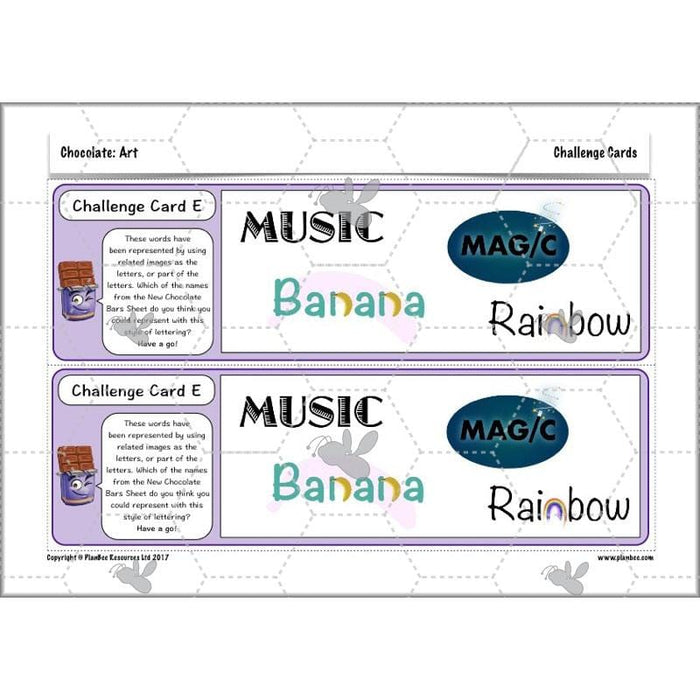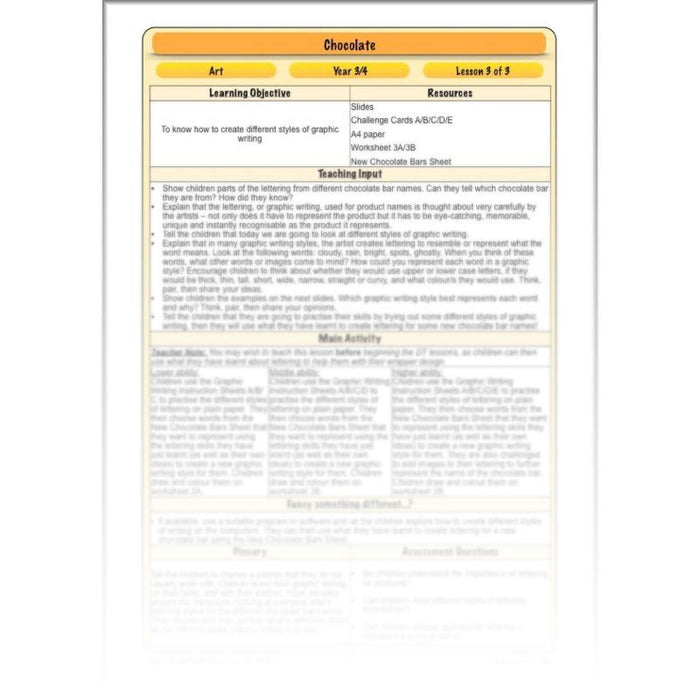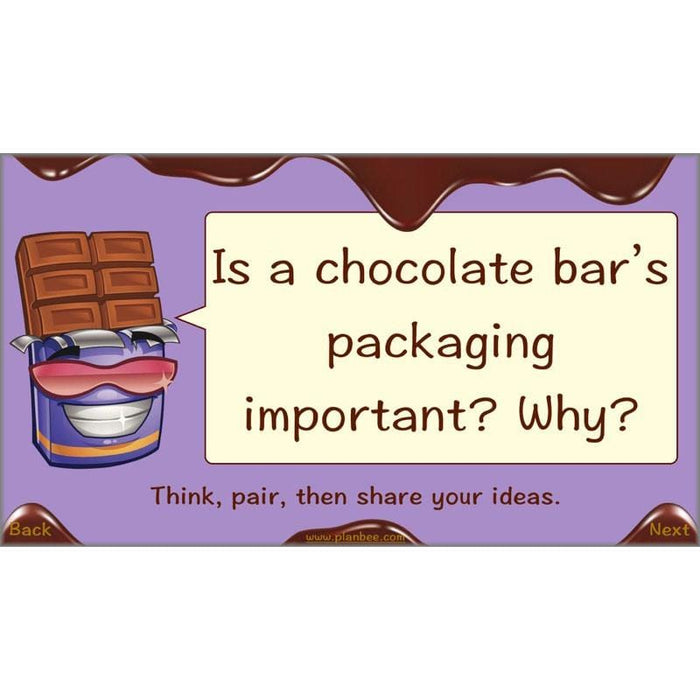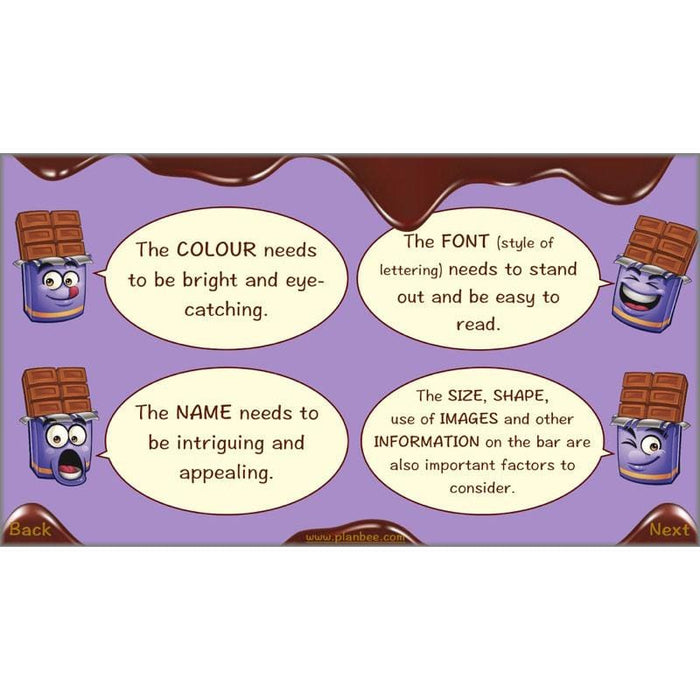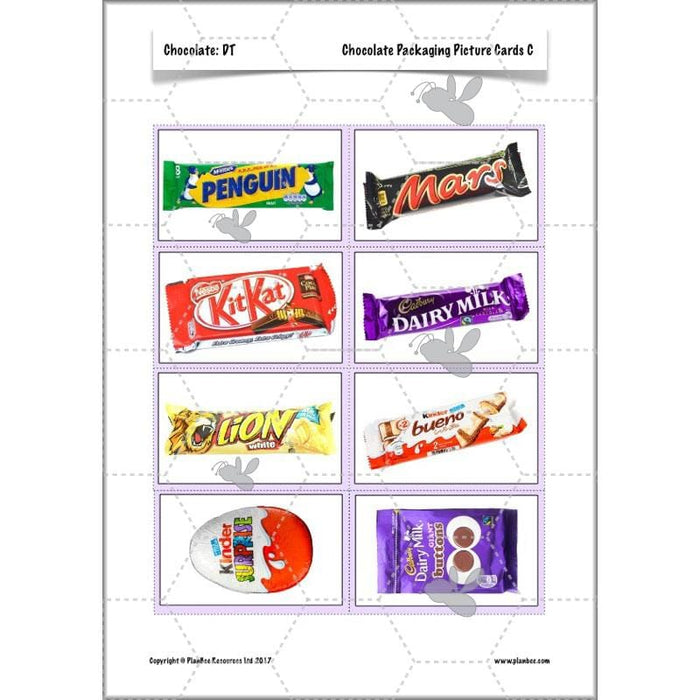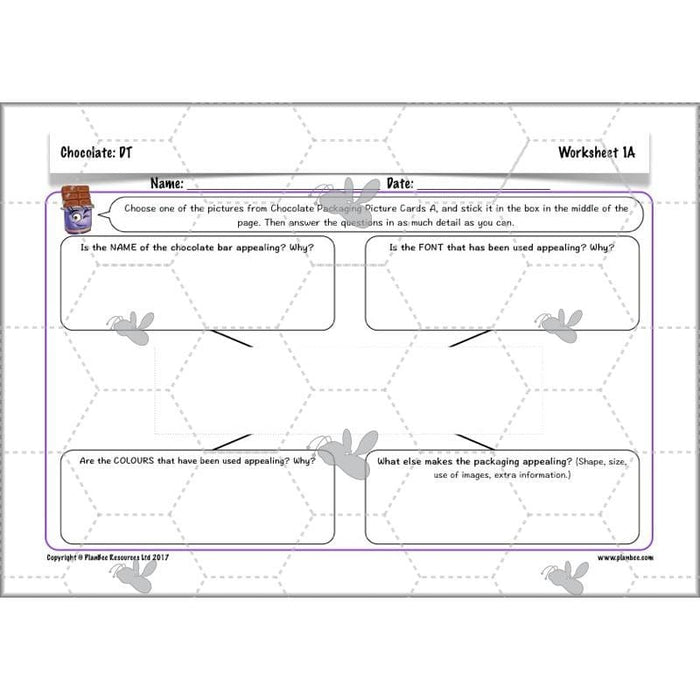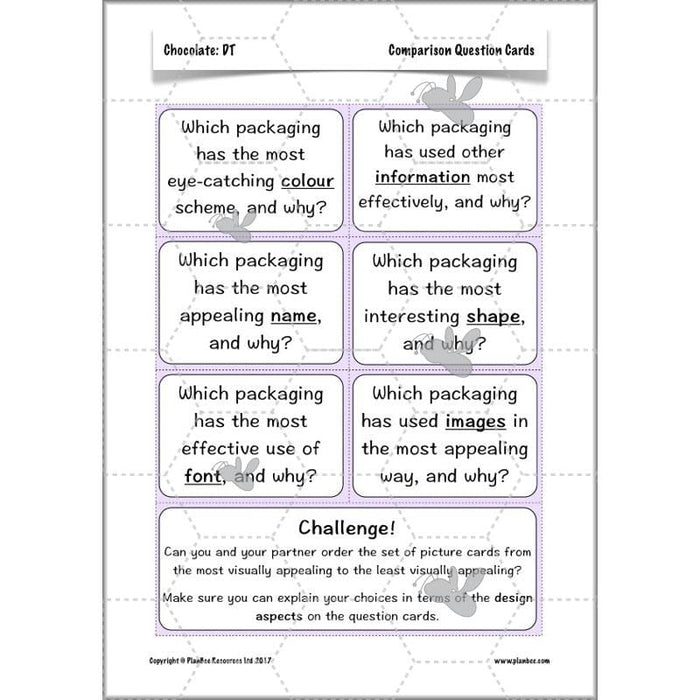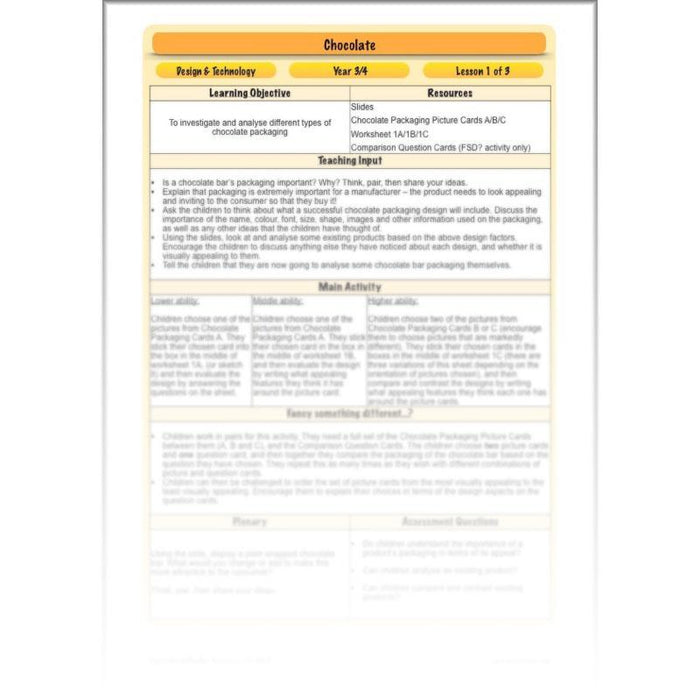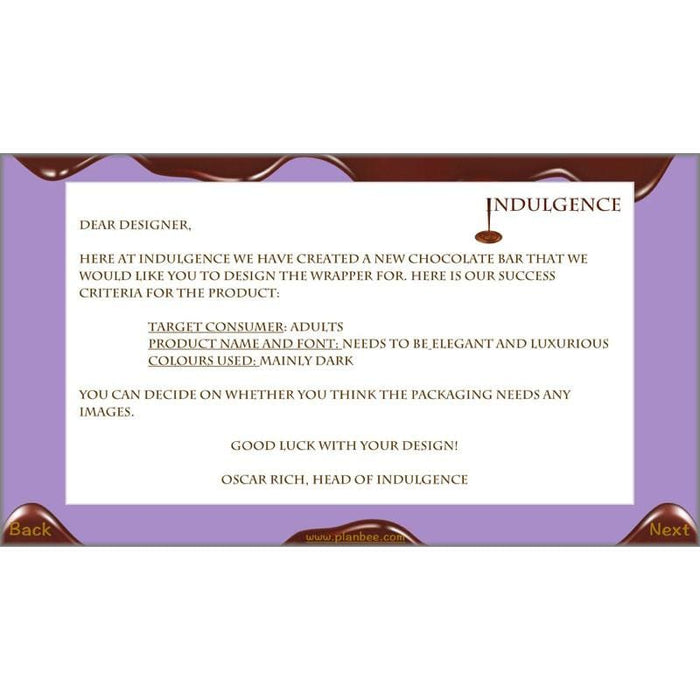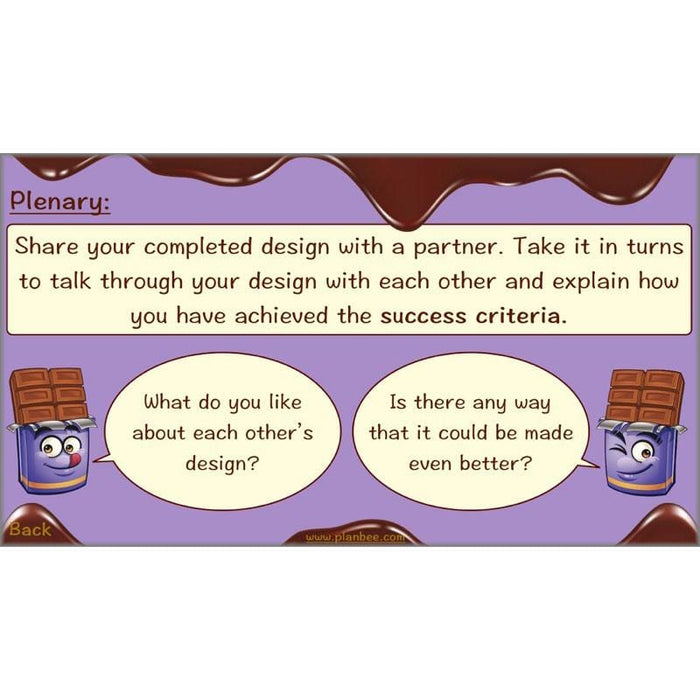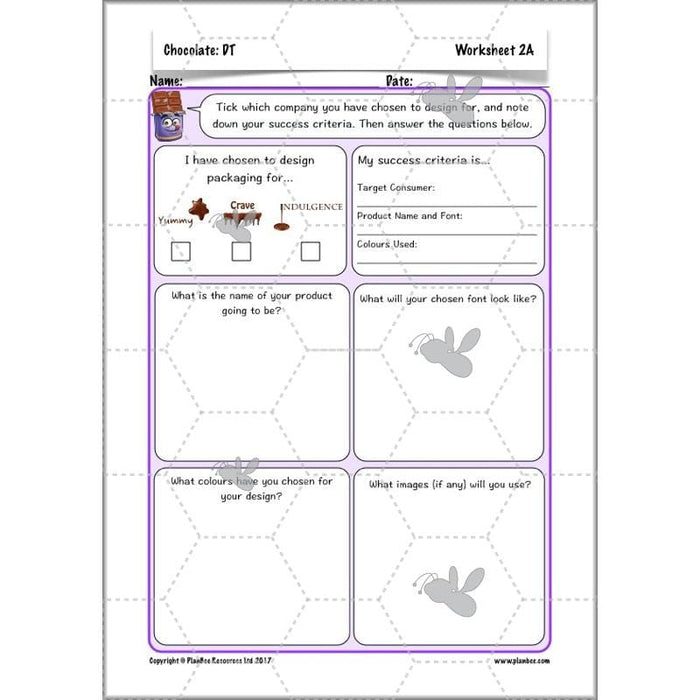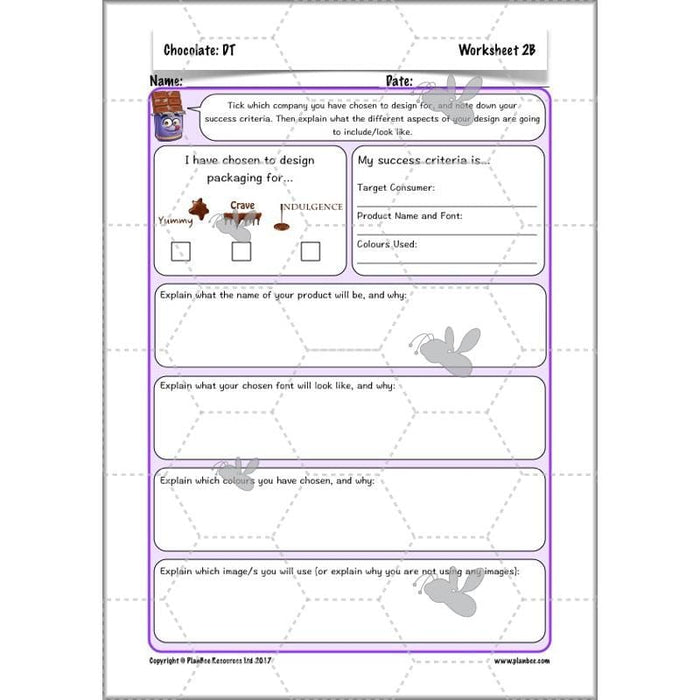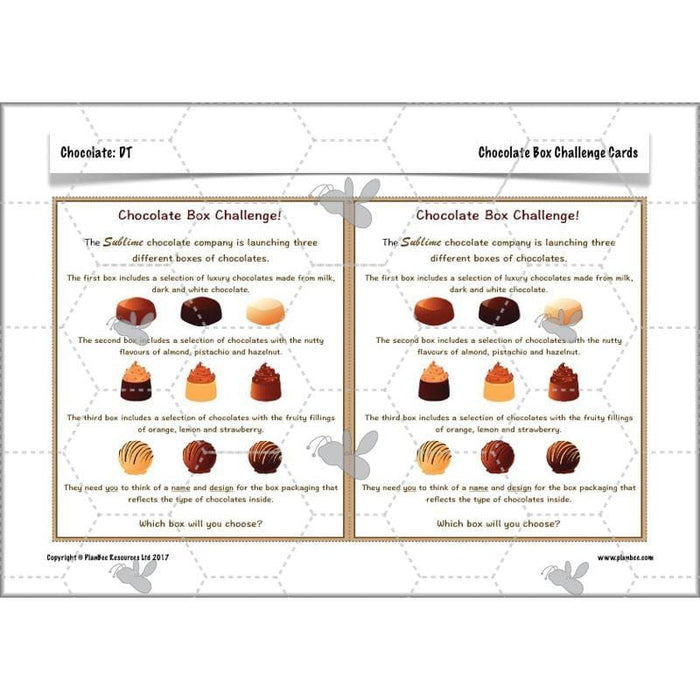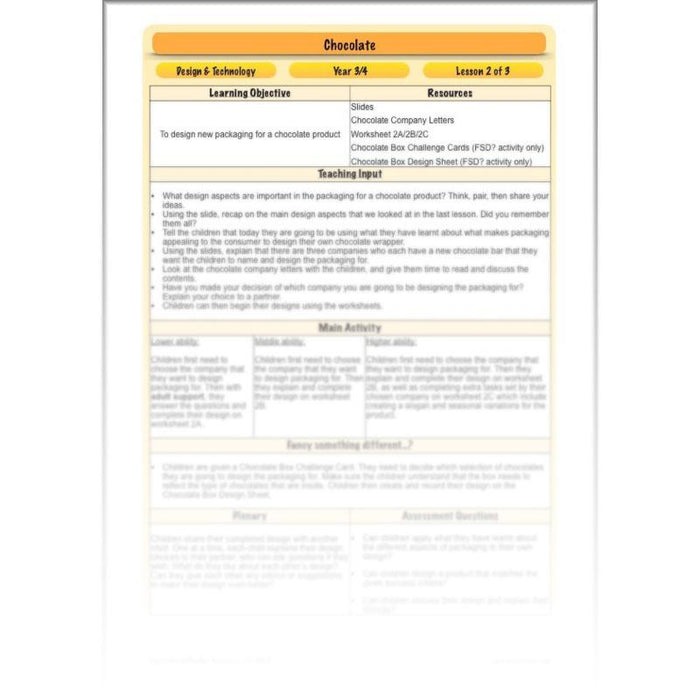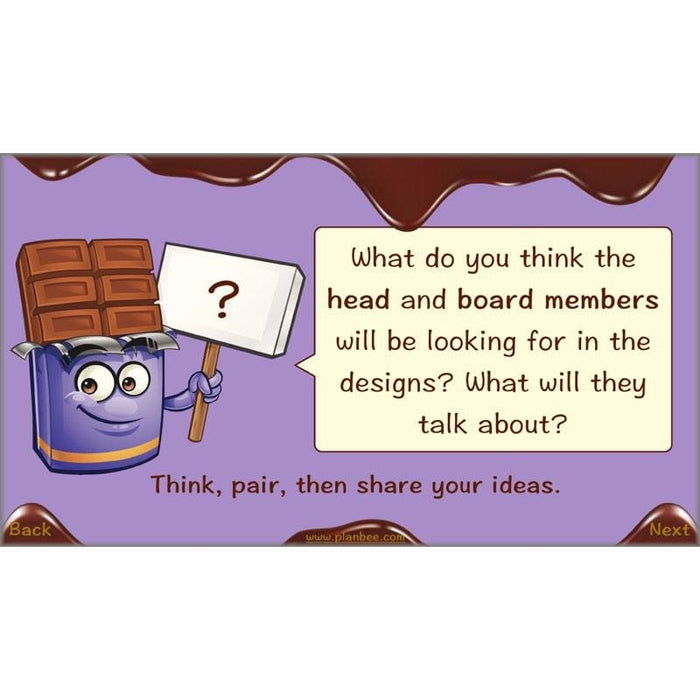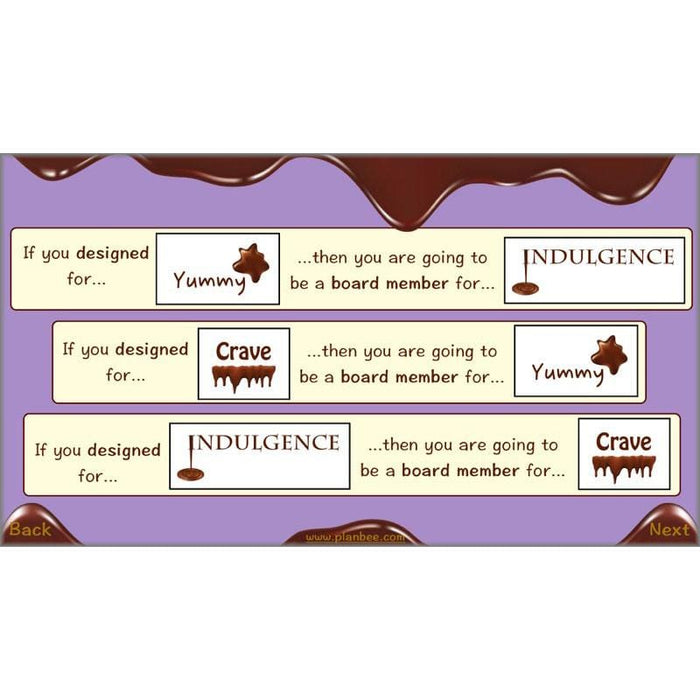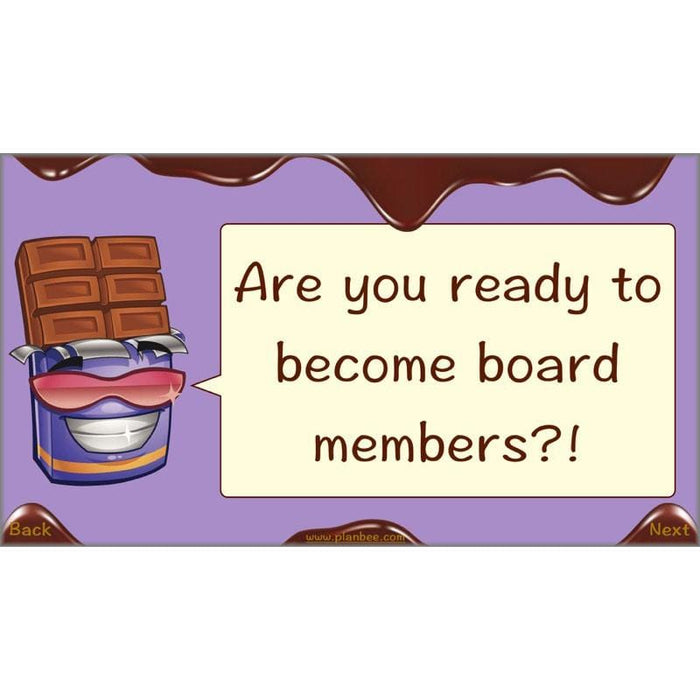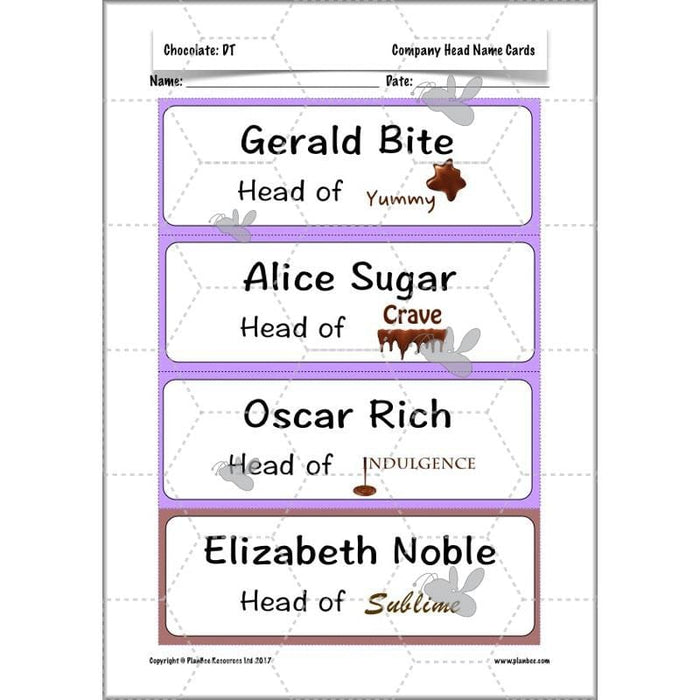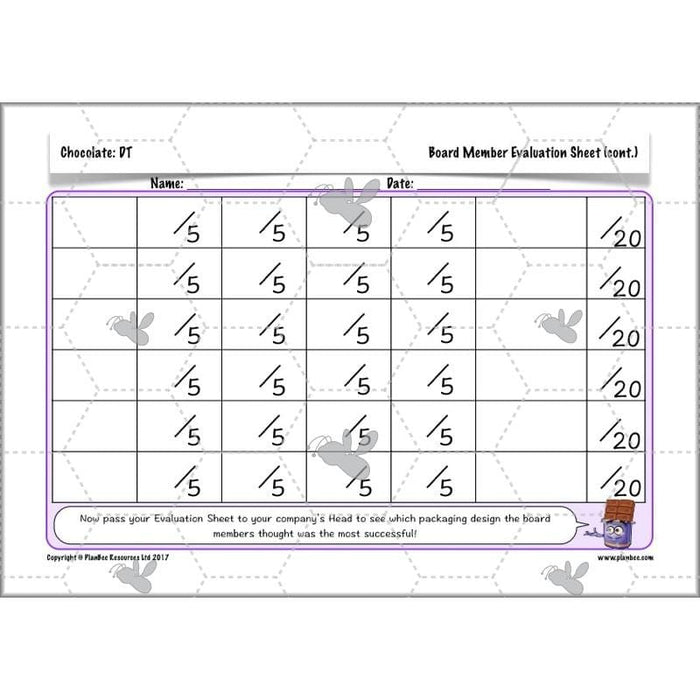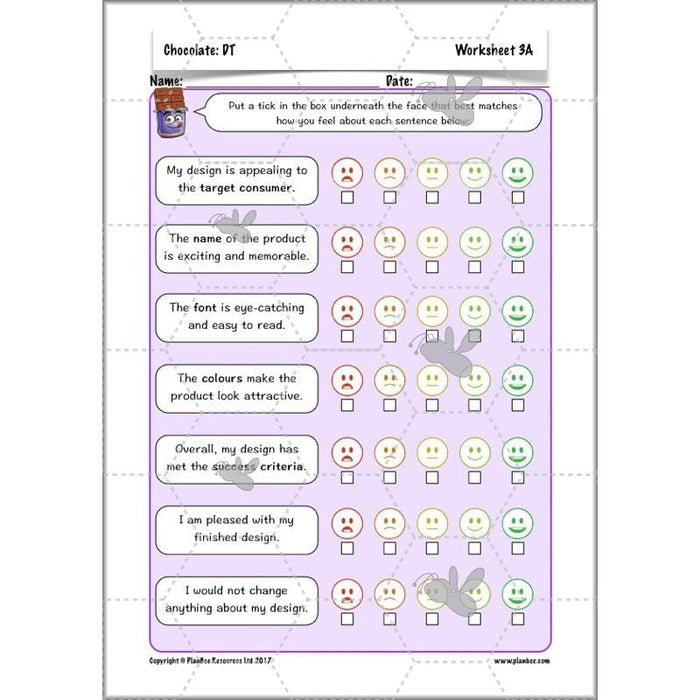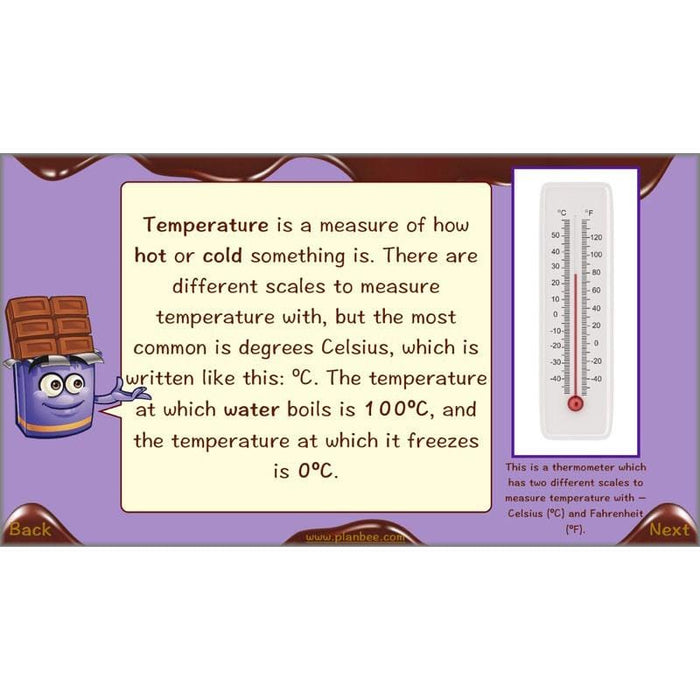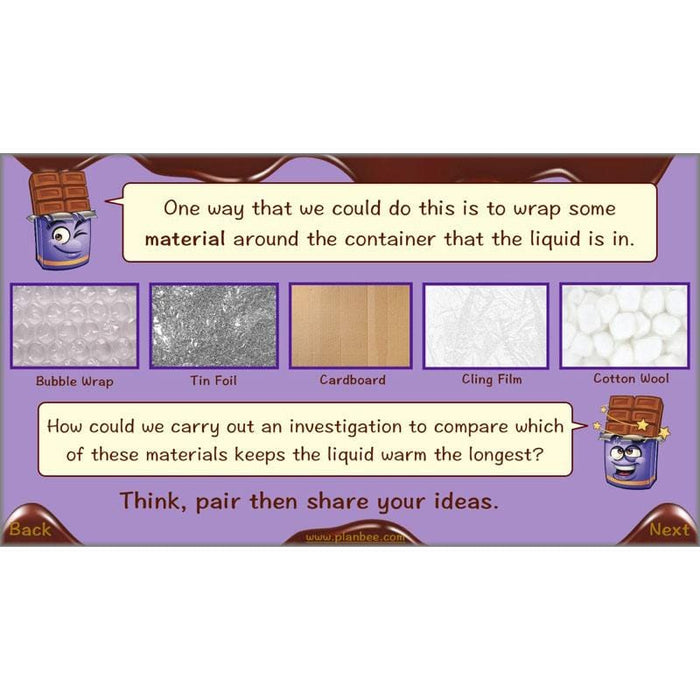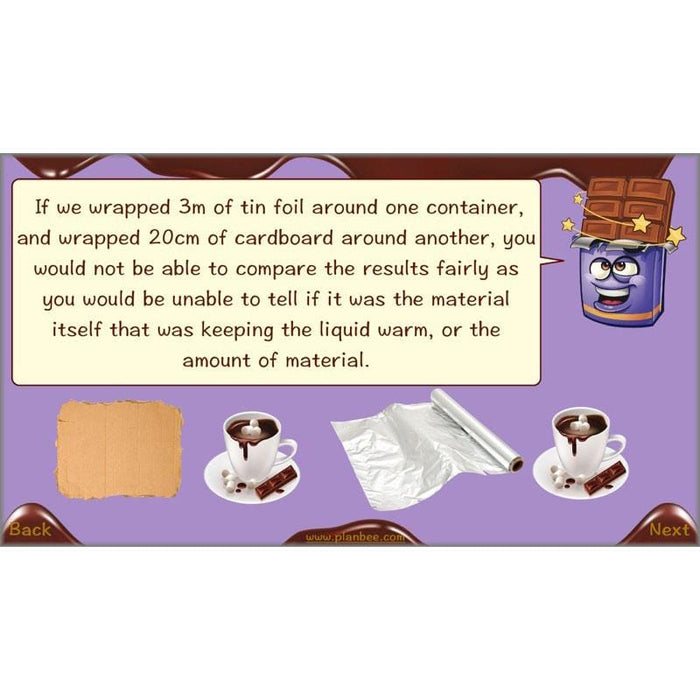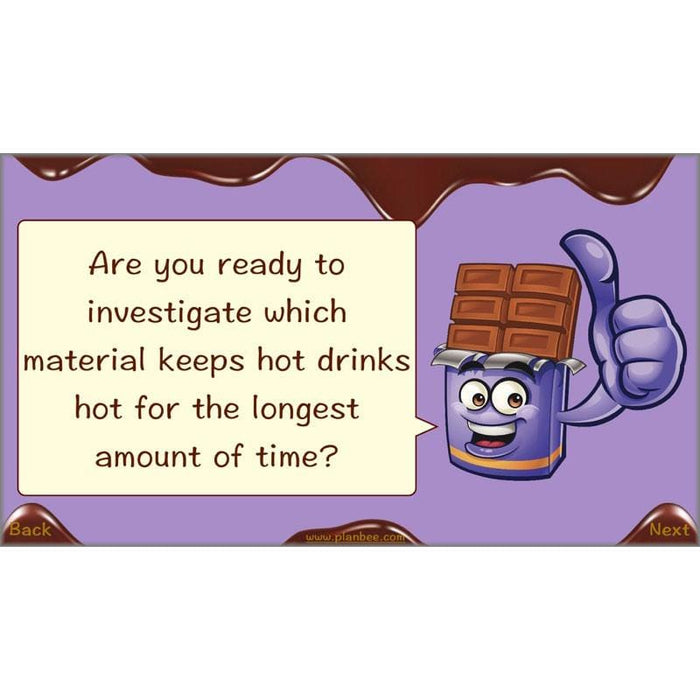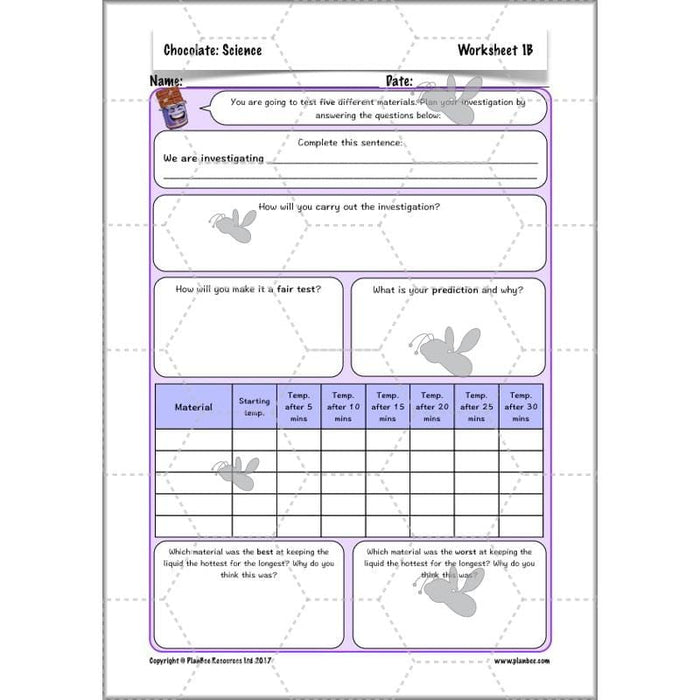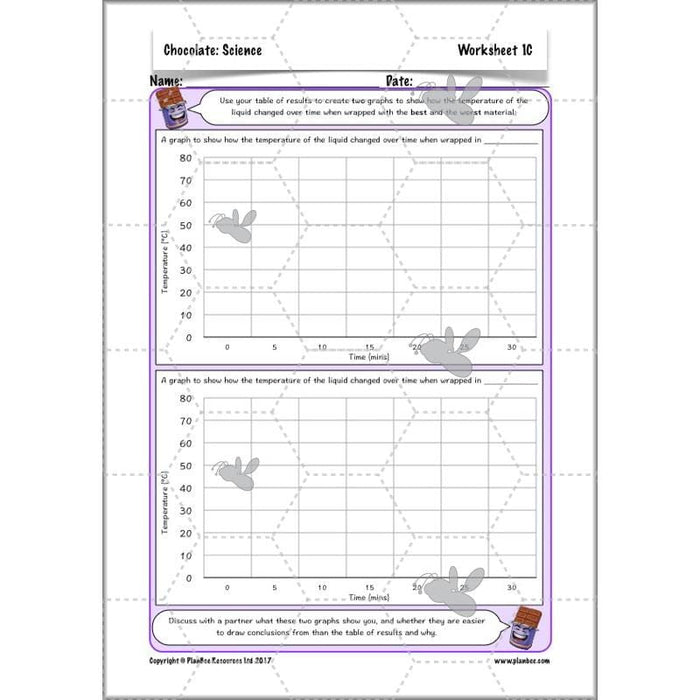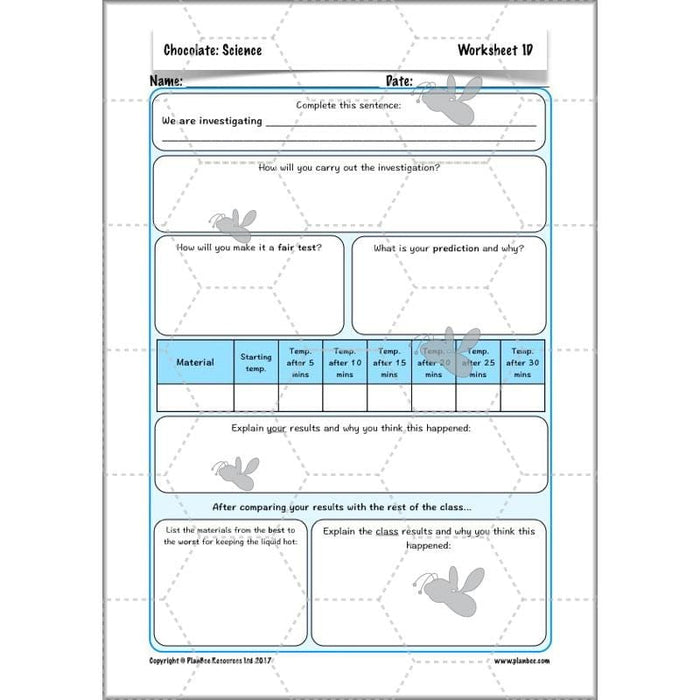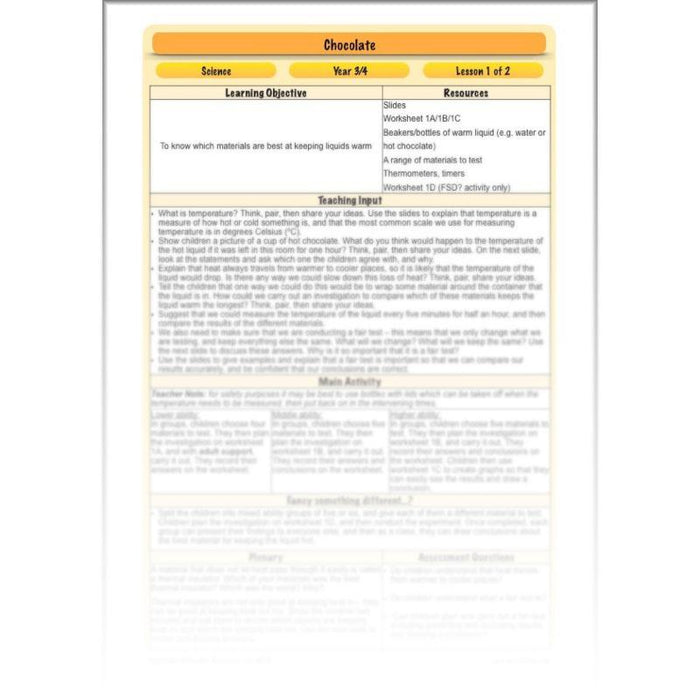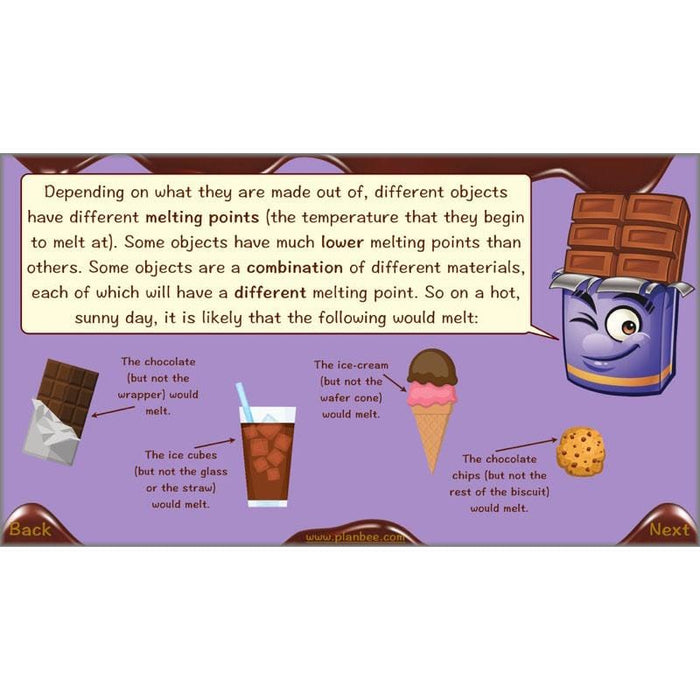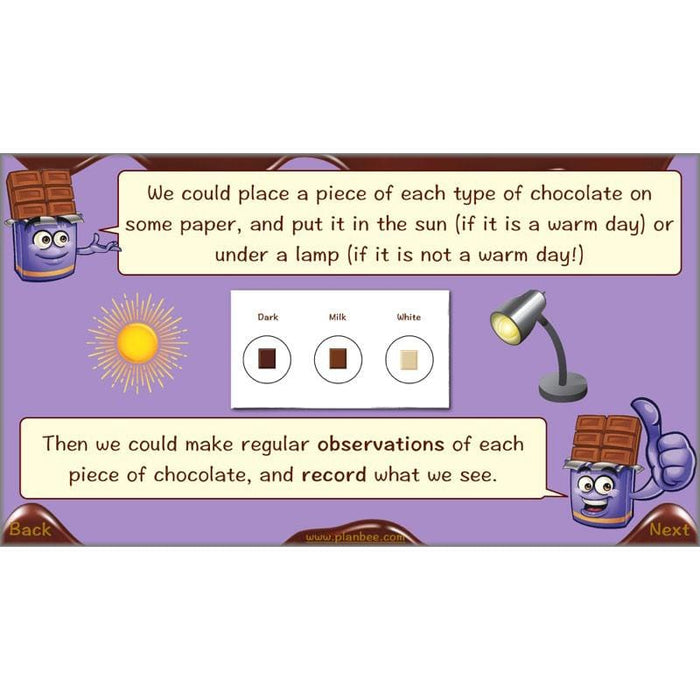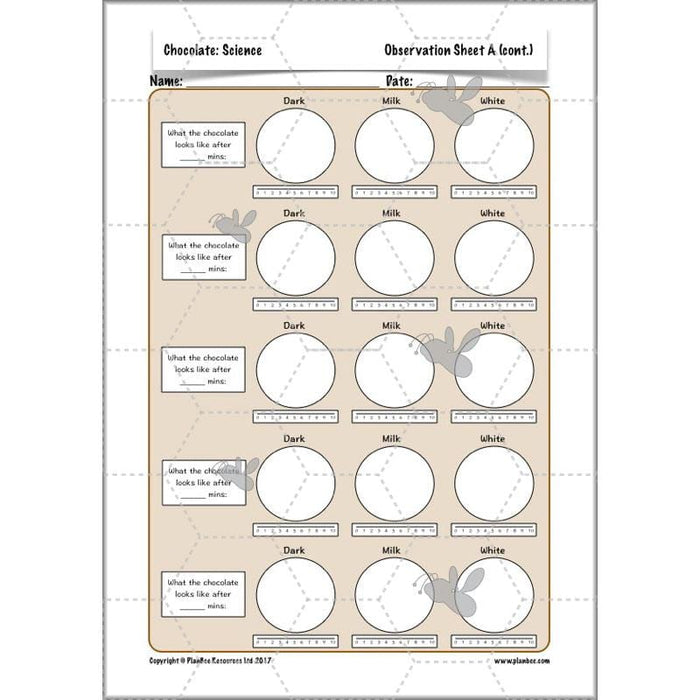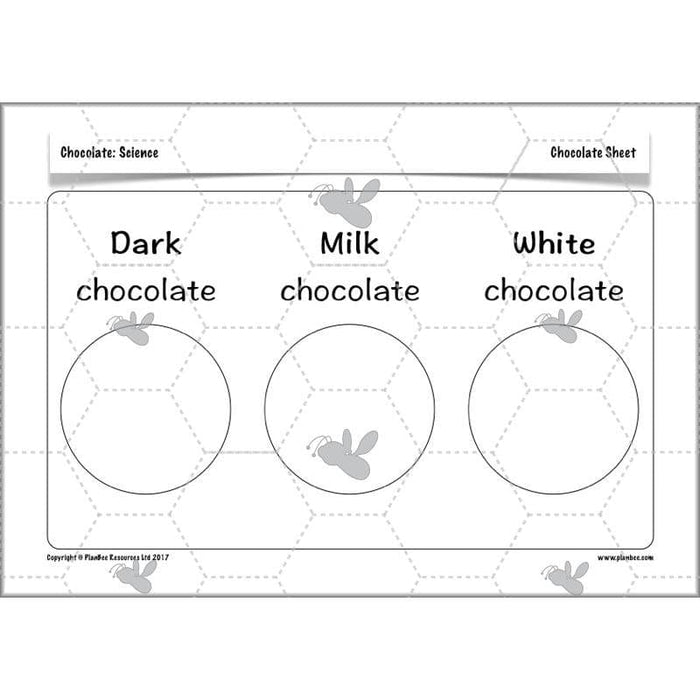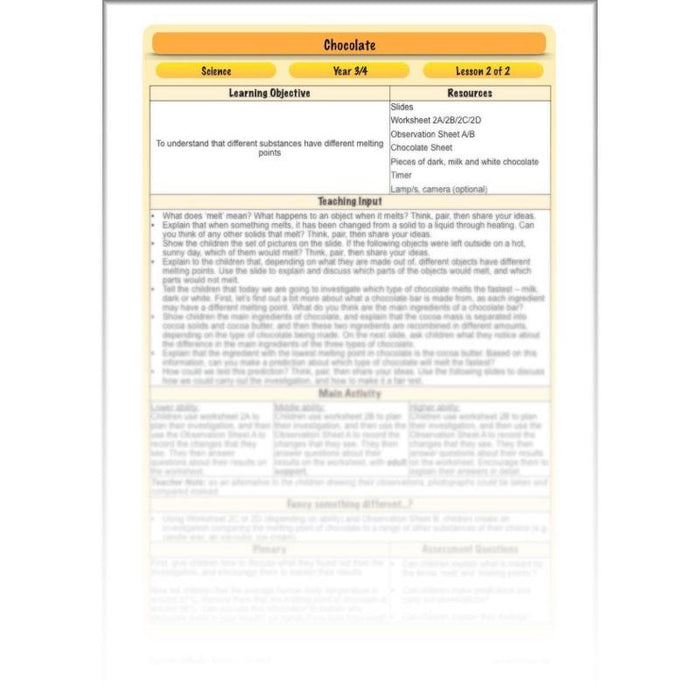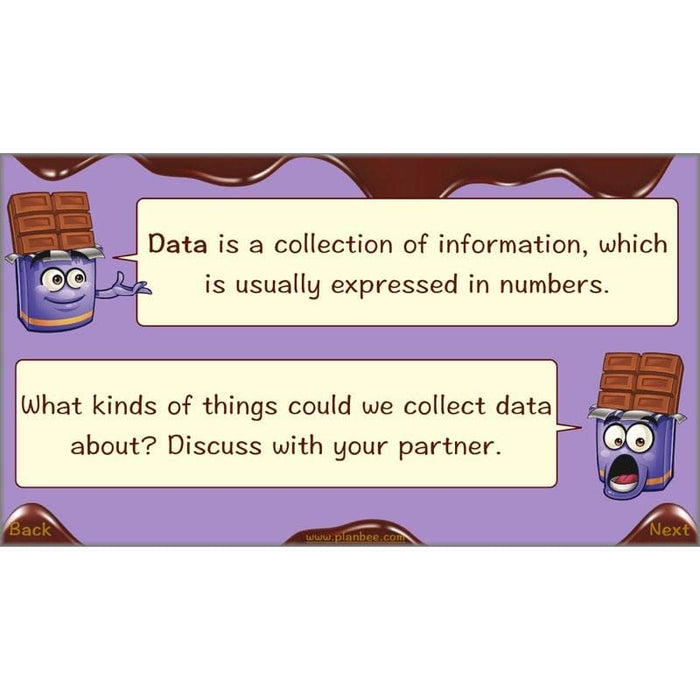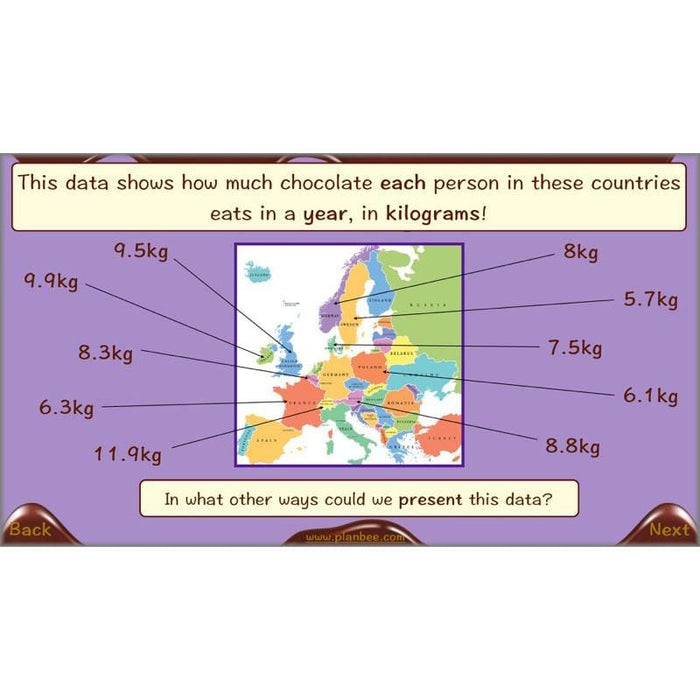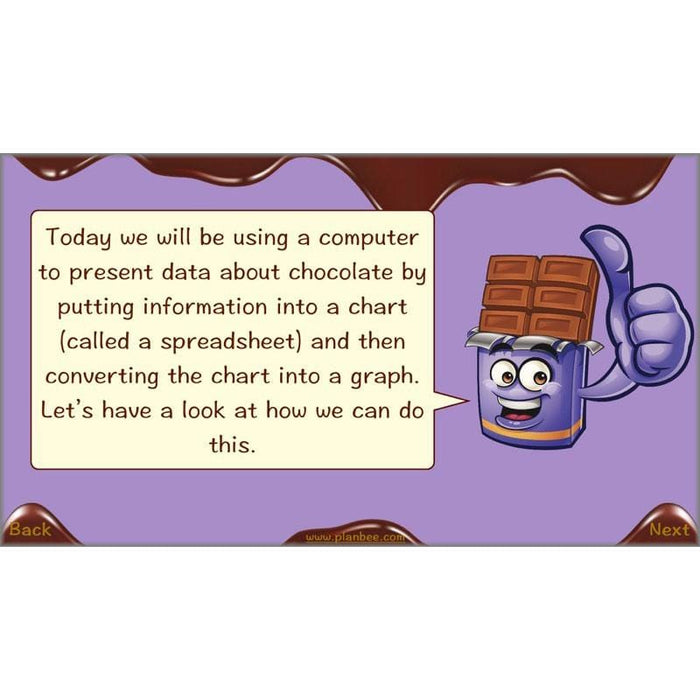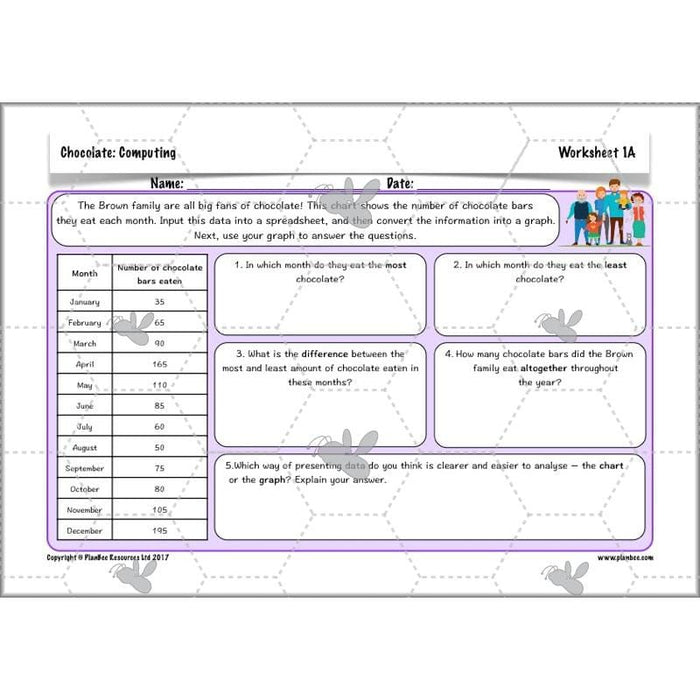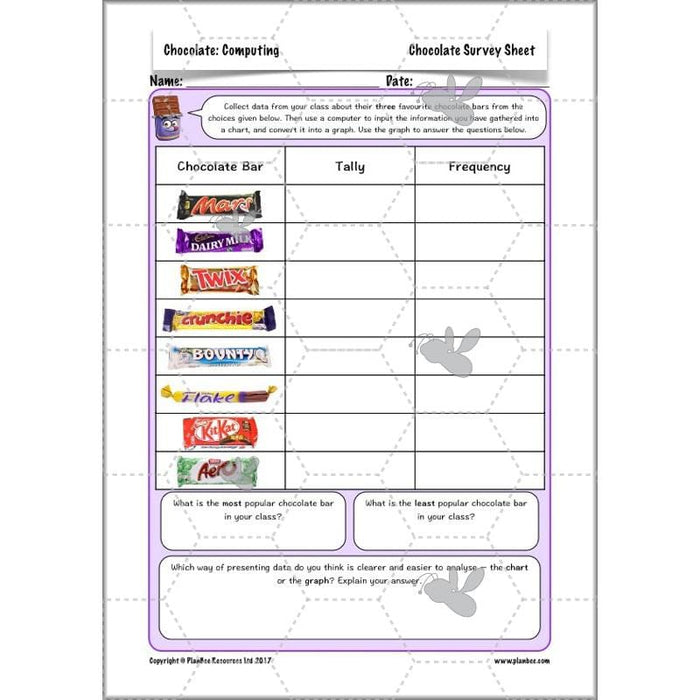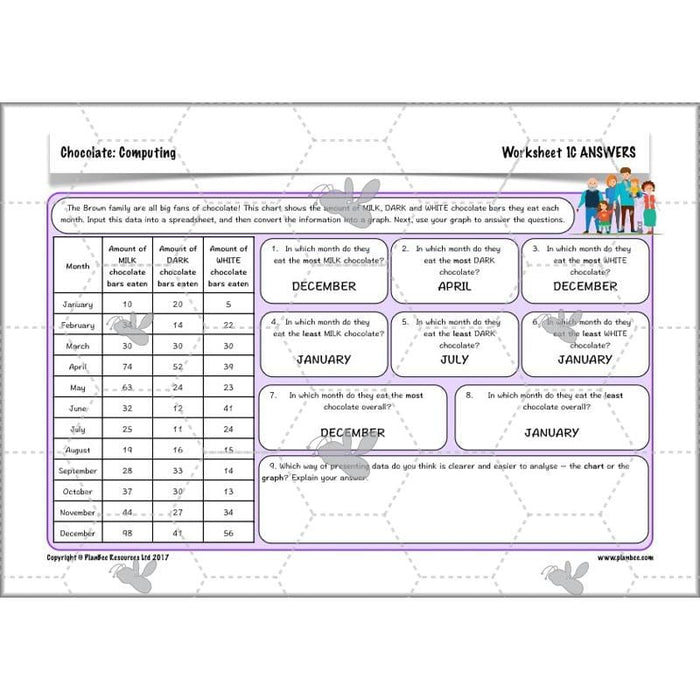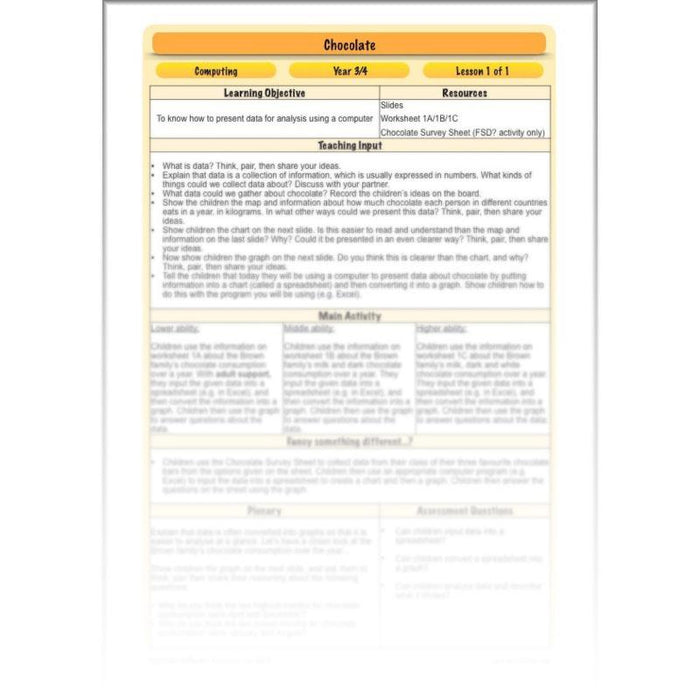With 18 individual lessons, each one including a detailed plan, engaging slides and a series of differentiated printable resources, ‘Chocolate’ KS2 series will immerse your class in all the different aspects of this highly popular treat, and make them eager for more...chocolate!
These three Chocolate Art lessons, forming part of our delicious Chocolate cross-curricular topic, give your KS2 children the chance to develop various artistic skills all through lots of chocolate-based projects!
Children will have the chance to design a mask to depict the god of chocolate, create an Aztec chocolate drinking vessel from clay, and design their own graphic writing for a new chocolate bar!
Each of these three Art lessons comes with all the planning and resources you need to deliver the lessons. There are detailed lesson plans, slideshows for each of the whole-class teaching inputs, differentiated activity ideas and a range of handy printable teaching resources.
Download a deliciously fun Computing lesson to use as part of your KS2 Chocolate topic! Children are challenged to input data about chocolate into a spreadsheet to then convert into a graph.
These three DT Chocolate lessons are a perfect way to embed some Design & Technology teaching into your Chocolate cross-curricular topic. Throughout these three lessons, your Year 3/4 children will explore chocolate packaging, design a new chocolate bar wrapper and evaluate the designing and making process.
Each of these three DT Chocolate lessons comes with all the resources you need to successfully teach these lessons, including a clear lesson plan with three-way differentiation plus an alternative activity, a slideshow for the whole-class input and a range of printable worksheets and other resources.
This series of three Chocolate Geography lessons for KS2 explores where in the world cocoa beans grow, the journey of a cocoa bean from pod to product and a day in the life of a cocoa farmer.
Each lesson comes fully prepared and ready to teach to your Year 3/4 children with a detailed lesson plan, an engaging and informative slideshow for the whole-class teaching input, differentiated activity ideas and a range of printable teaching resources, such as worksheets, picture cards, information sheets and much more!
These Chocolate History KS2 lessons will help your Year 3 or Year 4 children understand the early origins of chocolate and how it was used the the Aztecs and the Maya, how the cocoa bean came to Europe and gained popularity over the centuries, and finally how the Cadbury family grew and developed their own brand of chocolate during the Victorian era.
Each of these three Chocolate History KS2 lessons comes completely ready to download and teach to your class. Each downloadable lesson pack comes with a detailed lesson plan, a slideshow for the teaching input, differentiated activity ideas and a range of printable teaching resources to support children as they carry out their independent learning activities.
These three ready-to-teach PSHE lessons are a great way to get some PSHE teaching into your Chocolate topic! Throughout these lessons, your class will explore how much chocolate to eat (or not to eat!) as part of a healthy diet, find out what the Fairtrade Foundation is and explore philanthropy through the example of the Cadbury brothers.
Each of these three Chocolate PSHE lessons comes with a lesson plan that's easy to follow, a slideshow for the teaching input that's full of helpful information and questions to get your class thinking, and a range of printable teaching resources to help support your class as they carry out their differentiated activities.
These two Chocolate Science lessons are a great way to embed some science into your Chocolate cross-curricular topic!
Your KS2 children will explore thermal insulators to find out which materials are best at keeping a mug of hot chocolate warm for longest, as well as carrying out an experiment to find the melting point of chocolate.
Each of these two Chocolate Science lessons comes fully prepared and ready to deliver to your class. There are detailed lesson plans with three-way differentiation plus an alternative activity, informative slideshows for the teaching input and a range of handy printable teaching resources.
In this Aztec and Mayan Chocolate KS2 lesson, your Year 3 or Year 4 class will find out about the origins of cocoa beans. They will discover when and where they were first used to create a chocolate drink called xocoatl, and compare and contrast how two different cultures, the Aztecs and the Maya, used them.
This Aztec and Mayan Chocolate KS2 planning pack comes with a lesson plan, a slideshow for the whole class teaching input, differentiated ideas and a range of printable teaching resources to support your class as they learn about how the Maya and the Aztecs first used chocolate.
What's included:
- Lesson plan
- Slides
- Activity ideas
- Differentiated worksheets
- Cocoa Bean Culture Cards
- Mayan Information Sheet
- Aztec Information Sheet
- Quetzalcoatl Legend Sheet
- Quetzalcoatl Legend Storyboard A/B
In this ready-to-teach lesson, your Year 3 or Year 4 children will find out how the cocoa bean arrived in Europe. They will discover how it was initially used to make a luxurious drink for the wealthy, but after a time, the first eating chocolate was produced.
The included slideshow presentation for the teaching input goes through some key information about how chocolate first came to Europe and how it quickly spread in popularity. During their independent learning time, your class can then write a diary entry about the arrival of chocolate from the point of view of a particular historical character.
What's included:
- Lesson plan
- Slides
- Activity ideas
- Differentiated worksheets
- Character Cards
- Prompt Questions Cards
Explore the history of Cadbury with your KS2 class in this ready-to-teach lesson! The included slideshow presentation for the teaching input goes through a timeline of events in the development of the world-famous Cadbury brand, right from it's humble beginnings in 1824 right through to the 21st century.
During their independent learning time, children can either order events in the history of Cadbury on a timeline, or think of a list of questions they would like to ask John Cadbury, ready for a hot-seating activity.
This lesson comes fully prepared and ready to deliver to your Year 3 or Year 4 class, with a lesson plan, slideshow, differentiated activity ideas and a range of handy printable resources.
What's included:
- Lesson plan
- Slides
- Activity ideas
- Differentiated worksheets
- The History of Cadbury Sheet
- John Cadbury Biography Sheet
- Question Sheet
Where does cocoa grow? How do cocoa beans grow? What does a cocoa tree and a cocoa pod look like? Your KS2 children will find out the answers to all of these questions in the first Geography lesson of this series!
The included slideshow presentation for the teaching input goes through where in the world cocoa trees grow and what kind of climate they thrive in. It also looks at the four layers of the rainforest and teaches your class which layer cocoa trees grow in. Your Year 3/4 class will also learn about the process cocoa trees go through to grow cocoa pods.
During their independent learning time, your class can then put this knowledge to the test as they mark maps, explore diagrams and describe how a pod grows. Alternatively, they can create an information poster about cocoa trees.
What's included:
- Lesson plan
- Slides
- Activity ideas
- Differentiated worksheets
- World Map Sheet
- Continents of the World Sheet
- Countries of the World Sheet
- Challenge Cards
- Cocoa Trees Poster Sheet
- Cocoa Trees Information Sheet
In this Journey of a Cocoa Bean KS2 Geography lesson, your Year 3/4 children will find out how cocoa beans are harvested, dried, packed and transported to countries where chocolate is produced. They will discover the many different processes that the cocoa beans go through in order to turn them into chocolate.
During their independent activities, children can consolidate their understanding of the journey of a cocoa bean from pod to product through differentiated activities. Alternatively, they can create a presentation or short drama piece to represent the journey of the cocoa bean from bean to bar.
This lesson comes fully planned and ready to deliver to your class. There's a detailed lesson plan, a slideshow for the whole-class teaching input, differentiated activity ideas and a range of helpful printable teaching resources.
What's included:
- Lesson plan
- Slides
- Activity ideas
- Differentiated worksheets
- From Pod to Product Picture Cards
- From Pod to Product Description Cards A/B/C
- Glossary of Terms Cards
- The Journey of the Cocoa Bean Information Sheet
In this Cocoa Farmers lesson for KS2 children, your class will first recap which countries produce cocoa beans, before finding out about the daily life of a Ghanaian cocoa farmer.
The included slideshow presentation goes through an example of a day in the life of a cocoa farmer, which children are then encouraged to share their thoughts and feelings about. They can then create a diary entry as a Ghanaian farmer, or compare and contrast a cocoa farmer’s day with a British farmer’s day.
This Cocoa Farmers lesson provides all the resources you need to deliver this lesson, including an easy-to-follow lesson plan, a slideshow, differentiated activity ideas and a range of printable teaching resources.
What's included:
- Lesson plan
- Slides
- Activity ideas
- Differentiated worksheets
- A Day in the Life of a Ghanaian Farmer Sheet
- A Day in the Life of a British Farmer Sheet
- Kuapa Kokoo Information Sheet
- Discussion Points Sheet
In this Balanced Diet KS2 lesson plan, your children will develop their understanding of what a balanced diet is by looking at a food pyramid, and find out how much chocolate is a healthy daily amount.
Children will also discover what a typical Aztec diet used to consist of, and then compare it with our modern day food to see who has the most well-balanced diet.
This Balanced Diet KS2 planning pack for Year 3 or Year 4 comes with an easy-to-follow lesson plan, a slideshow for the teaching input, differentiated activity ideas and a range of printable teaching resources.
What's included:
- Lesson plan
- Slides
- Activity ideas
- Differentiated worksheets
- Food Pyramid Sheet
- Aztec Food Sheet
- Advantages and Disadvantages of Chocolate Cards
In this Fairtrade Foundation KS2 PSHE lesson, your Year 3/4 children will find out about the difficulties that cocoa farmers face. They will discover how a charity called the Fairtrade Foundation was set up in order to help farmers with some of these problems.
Children will create posters, leaflets and letters to inform people about the charity, and try to persuade them to support it by buying fair trade chocolate.
This Fairtrade Foundation lesson pack contains all the resources you need to deliver this thought-provoking lesson, including a detailed lesson plan, a slideshow for the whole-class input, differentiated activity ideas and a range of printable teaching resources.
What's included:
- Lesson plan
- Slides
- Activity ideas
- Differentiated worksheets
- Fairtrade Mark Sheet
- Fairtrade Foundation Information Sheet
- Fair or Not Fair? Game, Situation Cards, Dice and Instruction Sheet
In this philanthropy lesson plan pack, your KS2 children will find out how Richard and George Cadbury built Bournville, a ‘factory in a garden’, in order to improve their employees’ working and social lives.
Children will discuss and share their opinion of philanthropy before answering questions or completing diary entries about how workers’ lives at Bournville were changed for the better.
This Philanthropy lesson provides an easy-to-follow lesson plan, a slideshow for the whole-class teaching input, differentiated activity ideas and a range of handy printable teaching resources.
What's included:
- Lesson plan
- Slides
- Activity ideas
- Differentiated worksheets
- Bournville Village Information Sheet
- George’s Vision Worksheet
In this lesson, children will find out about the Aztec god of chocolate, Quetzalcoatl. They will see that he has been depicted in many different ways. Children are given the chance to create their own depiction of Quetzalcoatl by designing and making a mask. Alternatively, they can design and create their very own god of chocolate!
This God of Chocolate lesson contains all the planning and resources you need to deliver this lesson. There's an easy-to-follow lesson plan, a slideshow for the teaching input, differentiated activity ideas and a range of handy printable teaching resources.
What's included:
- Lesson plan
- Slides
- Activity ideas
- Quetzalcoatl Picture Cards
- Mask Design Sheets
- Mask Templates
- Challenge Cards
- God of Chocolate Design Sheet
In this Aztec Pottery Art lesson for children in Year 3 or Year 4, your class will discover how Aztecs made and decorated their pottery. The included slideshow presentation for the teaching input looks at some examples of Aztec pottery before showing some simple step-by-step photos to show how to make a pinch pot from clay, and how to decorate the basic shape in the Aztec style.
They will then be challenged to have a go for themselves, designing and making a clay vessel for the Aztec leader, King Montezuma, to drink his xocoatl from! In the alternate activity, children can create a monument from clay which represents the importance of cocoa to the Aztecs.
This Aztec Pottery Art lesson is fully planned and ready for you to deliver to your class. There's a clear lesson plan, a colourful slideshow for the teaching input, differentiated activity ideas and a range of handy printable teaching resources.
What's included:
- Lesson plan
- Slides
- Activity ideas
- Aztec Pottery Picture Cards
- Drinking Vessel Design Sheets
- Pinch Pot Instruction Sheet
- Coil Pot Instruction Sheet
- Aztec Patterns Ideas Sheet
- Cocoa Monument Design Sheet
Children will find out how lettering, or graphic writing, is very important when designing the name and packaging for products. They are given the opportunity to practise different graphic writing styles, and then they are challenged to use this knowledge to create their own lettering for a new chocolate bar.
What's included:
- Lesson plan
- Slides
- Activity ideas
- Differentiated worksheets
- Challenge Cards
- New Chocolate Bars Sheet
Your Year 3/4 children will get busy investigating chocolate packaging in the first lesson in this DT series. They will discuss the design elements and consider what makes each one a successful chocolate packaging design.
They will then analyse existing products by evaluating the effectiveness of the name, colour, font, size, shape and images used.
This Investigating Chocolate Packaging lesson pack includes a lesson plan, slideshow for the whole-class teaching input, differentiated activity ideas and a variety of printable teaching resources.
What's included:
- Lesson plan
- Slides
- Activity ideas
- Differentiated worksheets
- Chocolate Packaging Picture Cards
- Comparison Question Cards
In this fun Design a Chocolate Bar KS2 lesson, your Year 3/4 children will start be recapping the aspects that are important in the packaging of a chocolate bar. They will then use this knowledge to design their own chocolate bar wrapper!
The included slideshow presentation for the whole-class teaching input leads your class through the design criteria from three different chocolate companies who all want a new chocolate bar wrapper designed, giving your class the chance to consider what fonts, colours, size, name, images, etc. might be suitable for each one. They can then work independently to design a chocolate bar wrapper based on their chosen design brief.
This Design a Chocolate Bar KS2 planning pack provides all the resources you need to deliver this lesson, with no need for hours of planning time. There's a detailed lesson plan, a slideshow, differentiated activity ideas and a range of handy printable resources.
What's included:
- Lesson plan
- Slides
- Activity ideas
- Differentiated worksheets
- Chocolate Company Letters
- Chocolate Box Challenge Cards
- Chocolate Box Design Sheet
In the third and final lesson of this DT series, your Year 3/4 children will find out what happens to a design once it has been created. In groups, they will pretend to be board members of the different companies that they designed their chocolate bar wrappers for, and evaluate each other’s work according to the set criteria.
This lesson contains an easy-to-follow lesson plan, a slideshow for the teaching input, differentiated activity ideas and a range of handy printable teaching resources.
What's included:
- Lesson plan
- Slides
- Activity ideas
- Differentiated worksheets
- Board Member Evaluation Sheets
- Company Head Name Cards
In this Thermal Insulators KS2 Science lesson, your Year 3/4 class will explore which materials work best at keeping hot chocolate hot!
Children will discuss what temperature is, how it is measured, and how objects cool down to the temperature of the environment they are in. They will be given a hot drink, and then challenged to conduct an investigation into how the liquid could be kept warmer for longer by wrapping different materials around the container it is in.
This Thermal Insulators KS2 planning pack comes complete with everything you need in order to successfully deliver this Science lesson, including a clear lesson plan, a slideshow for the whole class teaching input, differentiated activity ideas and a range of printable teaching resources.
What's included:
- Lesson plan
- Slides
- Activity ideas
- Differentiated worksheets
In this fun and practical Science lesson, your KS2 children will carry out a melting chocolate experiment to find out which type of chocolate melts the fastest: dark, milk or white.
They will carry out an observational investigation to find out which type of chocolate melts the fastest, making sure that their experiment is a fair test. Alternatively, they can plan an experiment which compares the melting point of chocolate to other objects of their choice.
This Melting Chocolate Experiment lesson planning pack comes with all the resources you need to deliver this lesson, including a clear lesson plan with three-way differentiation plus an alternative activity, a slideshow for the teaching input and a range of printable teaching resources. All you need to do is provide the chocolate!
What's included:
- Lesson plan
- Slides
- Activity ideas
- Differentiated worksheets
- Observation Sheets
In this Chocolate Data Computing lesson, your Year 3/4 children will first discuss what data is, and what kinds of data we could gather about chocolate. They will compare the different ways in which data can be presented.
Children are then given some chocolate data, which they are challenged to input, convert into graphs, and analyse by answering given questions. Alternatively, they can gather their own chocolate data to input, present and analyse themselves.
This ready-to-teach lesson comes with all the downloadable resources needed to deliver this lesson, including a detailed lesson plan, a slideshow for the teaching input and a range of differentiated printable resources.
What's included:
- Lesson plan
- Slides
- Activity ideas
- Differentiated worksheets
- Chocolate Survey Sheet
<<
-
free overview (medium-term plan)
...
-
free assessment grid
...
-
curriculum objectives covered
...
>>
Download a free overview to support your teaching of this scheme of work.
Download a free, editable assessment grid to support your teaching of this scheme of work.
Art Objectives:
- KS2 - to improve their mastery of art and design techniques, including drawing with a range of materials
- KS2 - to improve their mastery of art and design techniques, including painting with a range of materials
- KS2 - to improve their mastery of art and design techniques, including sculpture with a range of materials
Computing Objectives:
- KS2 - select, use and combine a variety of software (including internet services) on a range of digital devices to design and create a range of programs, systems and content that accomplish given goals, including collecting, analysing, evaluating and presenting data and information
DT Objectives:
- KS2 - use research and develop design criteria to inform the design of innovative, functional, appealing products that are fit for purpose, aimed at particular individuals or groups
- KS2 - generate, develop, model and communicate their ideas through discussion, annotated sketches, cross-sectional and exploded diagrams, prototypes, pattern pieces and computer-aided design
- KS2 - investigate and analyse a range of existing products
- KS2 - evaluate their ideas and products against their own design criteria and consider the views of others to improve their work
Geography Objectives:
- KS2 - identify the position and significance of latitude, longitude, Equator, Northern Hemisphere, Southern Hemisphere, the Tropics of Cancer and Capricorn, Arctic and Antarctic Circle, the Prime/Greenwich Meridian and time zones (including day and night)
- KS2 - describe and understand key aspects of physical geography, including: climate zones, biomes and vegetation belts, rivers, mountains, volcanoes and earthquakes, and the water cycle
- KS2 - describe and understand key aspects of human geography, including: types of settlement and land use, economic activity including trade links, and the distribution of natural resources including energy, food, minerals and water
History Objectives:
- KS2 - a study of an aspect or theme in British history that extends pupils’ chronological knowledge beyond 1066
Science Objectives:
Year 3/4 Working Scientifically Objectives
- asking relevant questions and using different types of scientific enquiries to answer them
- setting up simple practical enquiries, comparative and fair tests
- making systematic and careful observations and, where appropriate, taking accurate measurements using standard units, using a range of equipment, including thermometers and data loggers
- gathering, recording, classifying and presenting data in a variety of ways to help in answering questions
- recording findings using simple scientific language, drawings, labelled diagrams, keys, bar charts, and tables
Year 4 States of Matter Objectives
- observe that some materials change state when they are heated or cooled, and measure or research the temperature at which this happens in degrees Celsius (°C)
